
- Culture & Arts
- Ho Chi Minh City
- Attractions
- Phu Quoc Island
- Mekong Delta
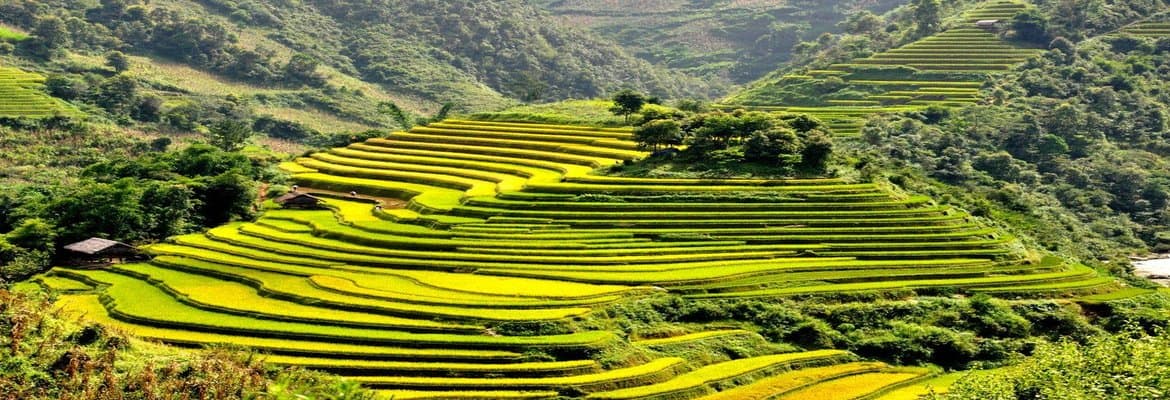

14 Rewarding Things to Do in Sapa for First-Timers
What to See and Do in Sapa, Vietnam
Located in Lao Cai, a province in the Northwestern region of Vietnam, Sapa is a small town but offers plenty of interesting things to do and places to see. Spectacular mountain landscapes, verdant rice terraces and unique ethnic minorities’ villages, all of them can be found in Sapa. To make the most of your Sapa experience, we have created an extensive of best things to do in Sapa for you. Let’s check it out.
1. Ride a Bike to Muong Hoa Valley
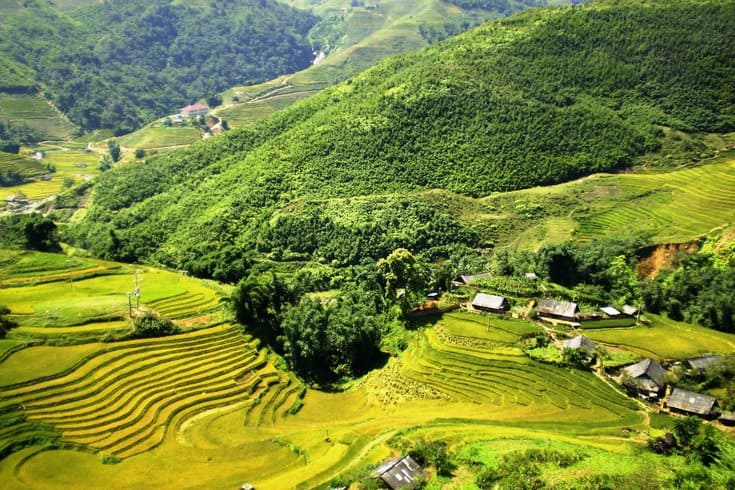
Highlights:
A stunning stretch of land at the bottom of Fansipan’s flank, Muong Hoa Valley is one of the most famous destinations for motorbike riders. 14 km far from the town, it lies between 2 high ranges of mountains. The place is a great place to learn about rice cultivating for those who want to understand more about local life. Driving from the town to Muong Hoa will be an amazing experience in your life. You have a chance to go through the highest mountain range to dozens of streams downhill, cross small villages and rice fields of ethnic minority people and watch how people do farming works. Besides, there are many photo opportunities of great views for you.
- The color of the terraced rice fields are the most attractive during September.
- The motorbike can be rent in Sapa town with just around USD 5
2. Conquer Fansipan – Roof of Indochina
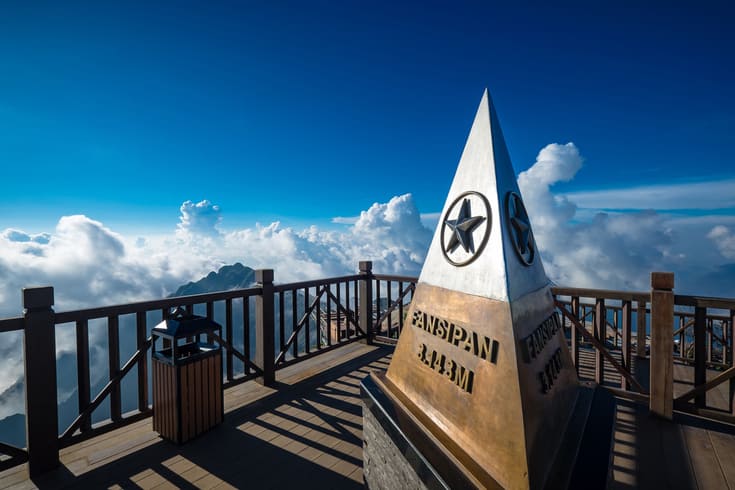
For those who truly love adventurous experiences , conquering Fansipan should be on top of your bucket list immediately. Regarded as the highest peak in Vietnam, it is located over Hoang Lien range, offering opportunities of discovering and enjoying many stunning scenery. It could be bamboo woods, rice terraces, or hospitable tribal people. And, a wonderful thing is that it doesn’t need any technical skill to conquer the Roof of Indochina . There are 3 different routes to climb to the peak. So, you should choose the most suitable one with your skill level and the time you have.
- You should prepare some sturdy and no-slip boots because the hike can be wet and slippery.
- Make sure you bring bottled water, dry food, and a flashlight.
- 3), first:(pageNumber == 1 && Math.abs(pageNumber - currentPage) > 3)}">{{ pageNumber }}
3. Shop for Trekking Gear and Local Handicrafts
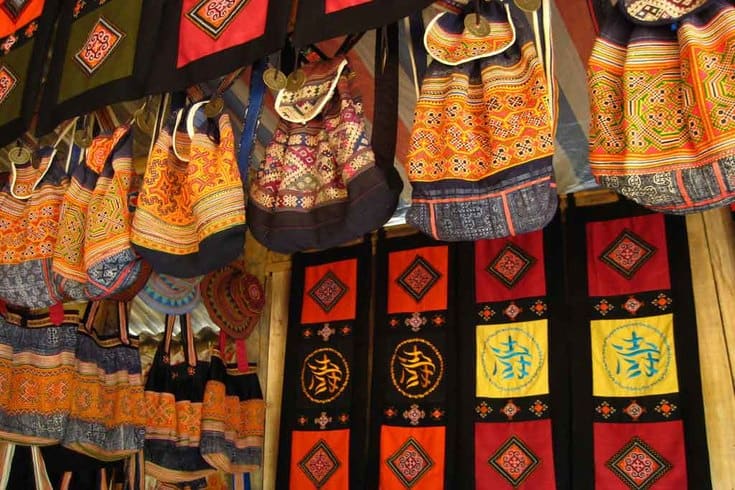
Sapa and the surrounding areas have a number of local markets where you can buy both handicrafts and anything you need for your trek. In the city center, you can find the main market which is close to most hotels and hostels. It sells everything like clothing items, food, souvenirs, and hiking gear.
Spread around the town, there will be many more small shops providing handmade items like musical instruments, leather bags, or locally designed items. However, the price of these items are a bit higher than the markets outside the city.
The best place to buy these nice things is at truly local markets in small villages. Here, you can get the most original and beautiful products at reasonable prices. You will also have a chance to meet the artisans and support them at the same time.
- Many items are counterfeit brands like the North Face, Nike, or Adidas. So you should consider what to buy as trekking clothes.
4. Trek in Sapa
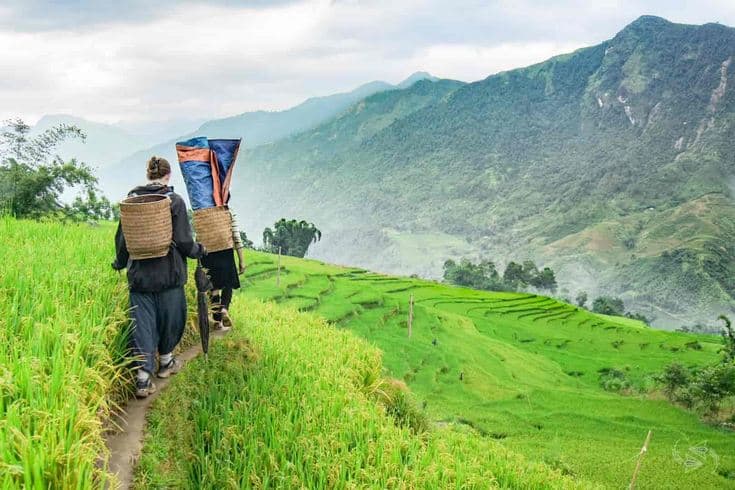
With dramatic landscapes, Sapa has been attracting trekkers for more than 30 years. As an undiscovered paradise for intrepid explorers, trekking in Sapa is a must-do activity when you visit this mountainous area. It is a challenging but incredible experience when you trek through the green paddy field and the world of minority villages around the town. You can choose to do it with or without a local guide. However, we highly recommend hiring a local guide to save your time and energy. They are also familiar with the weather, terrain, and tourist destinations so they can help you with a safer and more enjoyable trip.
- For a long trek in Sapa, it is better to stay at a local homestay . It will give you a deeper insight into the local lifestyle and join the daily works or prepare some tasty dishes.
- Before going trekking in Sapa, you should check the destination you will visit carefully and search for the weather forecast also.
5. Climb to Ham Rong Mountain
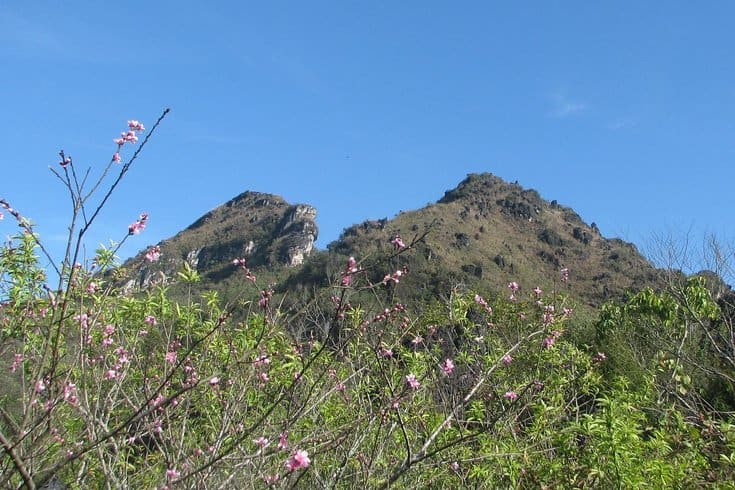
As the most spectacular mountain park, Ham Rong Mountain is a popular tourist area built on an area of around 150 ha. The more steps that you climb, the more breathtaking scenes you can discover such as orchid garden, cloud yard, heaven gate, and peach garden. Visit Ham Rong mountain , you can also explore a wide variety of plants and see a large number of rocks in different shapes. The place has its own distinct color at any time of the year. However, the best time to visit is spring when plenty of flowers are blooming, showing their sweetness and fragrance.
- Ham Rong mountain is open from 6:00 am to 6:00 pm. So, you should consider this when planning your itinerary.
- Before exploring the mountain, you should buy the ticket at VND 70.000 right in front of its main entrance.
6. Explore Silver Waterfall and be Amazed at Sky Gate
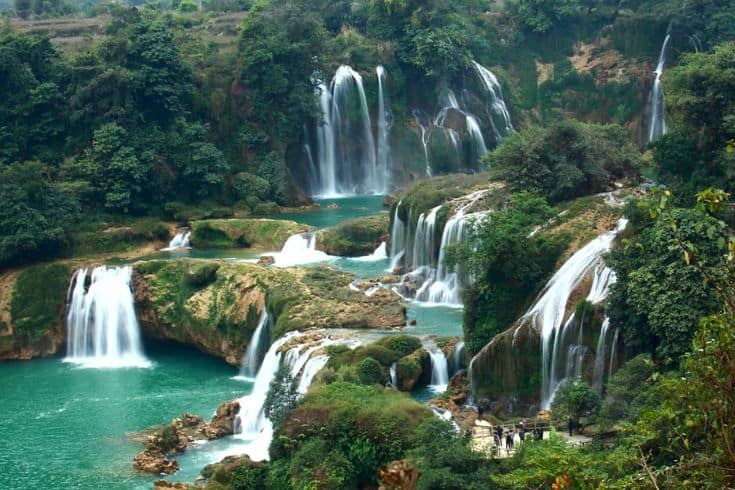
Waterfall has been famous as a land of Sapa which is about 200 meters high. Located at the foot of O Quy Ho pass , you can travel to this place by motorbike or bus. Most tourists to Sapa never miss the chance to get here because it is the most beautiful waterfall in Sapa. standing at the foot of the waterfall, you will see the sparkling water flowing down. It looks like a spectacular mountain scenery from afar, creating a wild and mysterious feeling. The Sky Gate is the place to admire the majestic beauty of Northwestern mountains and forests and the spectacular natural scenery. From here, you can see huge valleys with green terraced fields, the long road connecting Lai Chau and Lao Cai provinces, and the Silver Waterfall ( Thac Bac ).
- You should bring warm clothes because the weather can be quite cold and foggy even if it’s summer.
- There might be mosquitos and insects around, so it’s better to have an insect sprayer with you.
7. Visit Cat Cat, Ta Phin and Lao Chai Village
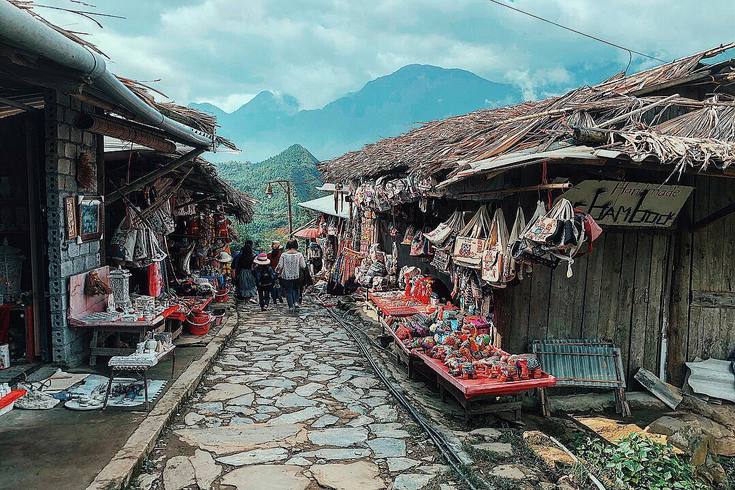
The villages in Sapa are an indispensable part of every Sapa tour. With beautiful and unique scenery, these villages attract large numbers of visitors to Sapa. Among them, Cat Cat , Ta Phin and Lao Chai villages are the most visited tourists. Cat Cat is home to Black H’Mong while Ta Phin is home to Dao ethnic people and Lao Chai is the village where H’Mong people live. These villages are all located in a four-sided wide and flat valleys. Coming here, you can get to know special features of different Vietnamese ethnic minority groups . Especially, it would be a great experience to try the bath medicine leaf Red Dao in Ta Phin village and buy local handicrafts in Cat Cat and Ta Phin villages.
- During your visit to any ethnic villages, please ask for permission first before taking photos. Some of ethnic people are not comfortable with this.
8. See the Ancient Rock Field
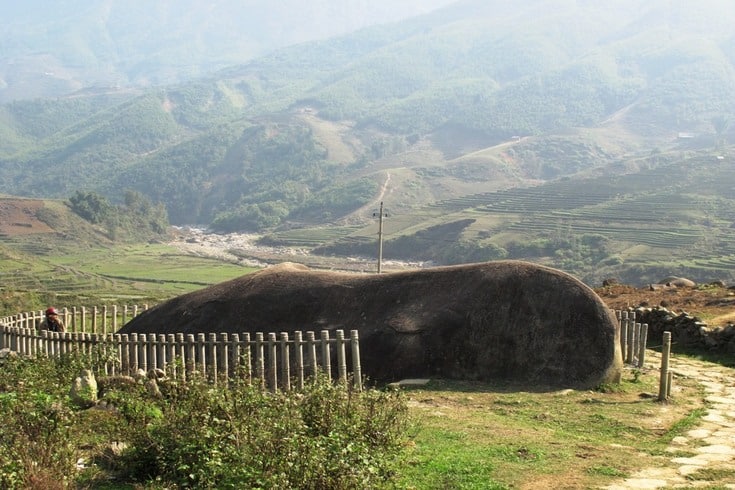
Ancient rock field is a unique spot that is located in Muong Hoa valley . The rock field is a good place to explore interesting history and take photos with its motifs. Located on the steep mountain road, the ancient rock field consists of more than 150 small and large boulders near the rice fields. Though it doesn’t look impressive at all from afar, you will be amazed to hear the introduction and examine the rocks after getting off the bus. Covering an area of 8 square km , most big rocks with strange and beautiful carvings are in Pho village. The carvings feature 11 styles of strange human images and the scientists consumes this was a big heritage of mankind.
- Each carving is believed to store a story about ancient people’s life, living and culture. So, let’s see and guess what they want to say.
9. Enjoy the Seven-color Steamed Glutinous Rice of Nung Dinh People
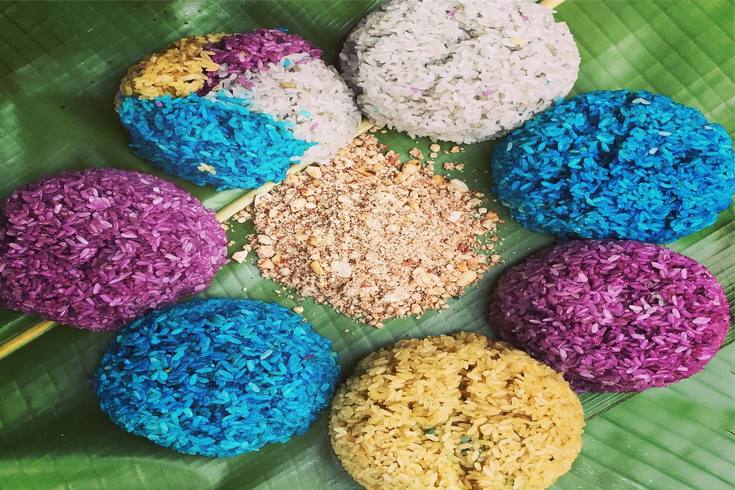
The seven-color steamed glutinous rice is a specialty of Nung Dinh people . The dish was initially invented to present to their ancestors to wish for an abundant harvest and a comfortable life. Each color of glutinous rice presents a special meaning. For example, the green is the color of spring, the dark red is the color of patriotic martyrs who sacrificed their life in the war, and the yellow presents the color of the scatter and heart-break. The dish is a great combination of seven colors without using chemical colors. The clever local woman creates the color by using many kinds of forest leaves and herbs and some of their traditional secrets. Nung Dinh people believe that eating this dish will bring luck to you. With an attractive appearance and special taste, it is prefered by many tourists.
- The original dish is in Muong Khuong, Lao Cai. However, you can find this dish in the morning market in Sapa town.
10. Enjoy Sapa Specialties at Sapa Food Court
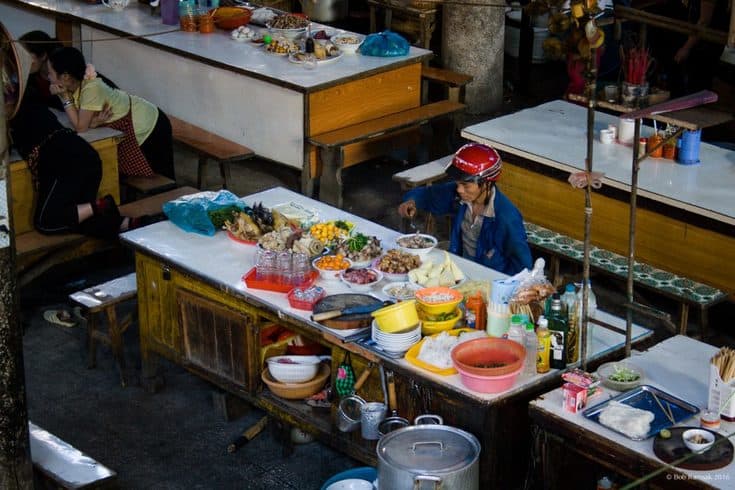
Every trip will not be complete without sampling the best local cuisine . As a culinary paradise with a diversity of food and flavors, Sapa food court is a great place to enjoy the most various culinary experiences. The place is very bustling and offers many delicious food stalls at reasonable prices. Eggs, grilled sweet potatoes, grilled meat,… all of these foods will surely fill your tummy before leaving. To make your eating experience in Sapa more enjoyable, it is advisable to go with your friends.
Tips:
- The snacks area in Ham Rong street will be open from 7:00 am to 5:00 pm. So if you wish to find something to eat in the evening, you can head to the BBQ area in Cau May street .
11. Admire Terraced Rice Fields
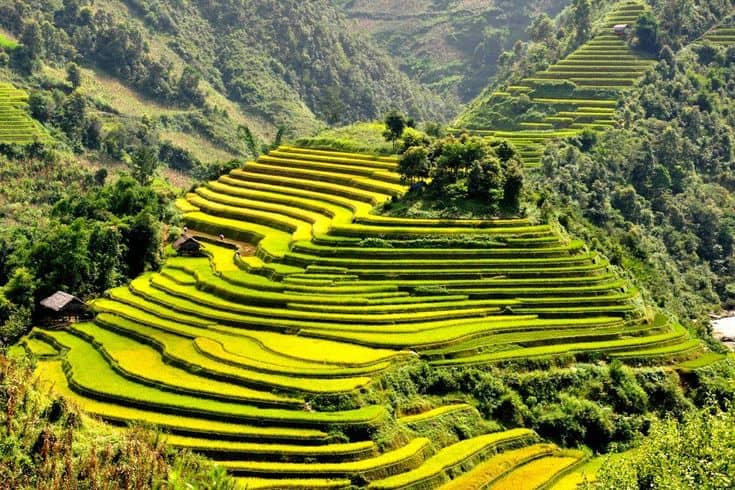
Highlights:
Sapa is not only a best choice for summer escape but it also attracts tourists to admire its stunning beauty of terraced rice fields on the hilly slopes. Due to steep features and fertile soil, local ethnic minority people grow their rice and establish beautiful terraced rice fields. We highly recommend trekking these rice fields where you can both understand about local cultures and admire the beautiful and spectacular scenery and have nice photos. Seen from afar, these terraced rice fields are a great picture of nature with heart-catching beauty that makes tourists stay for a while. The color changes seasonally with alluring charm in the beginning of new crops and yellow ripening rice when it is about harvested.
- If you visit the terraced rice fields in the harvesting crop, you can ask the local farmer and join them in harvesting rice. It would be a brand new experience in your whole life.
12. Have a Drink at Café in The Clouds
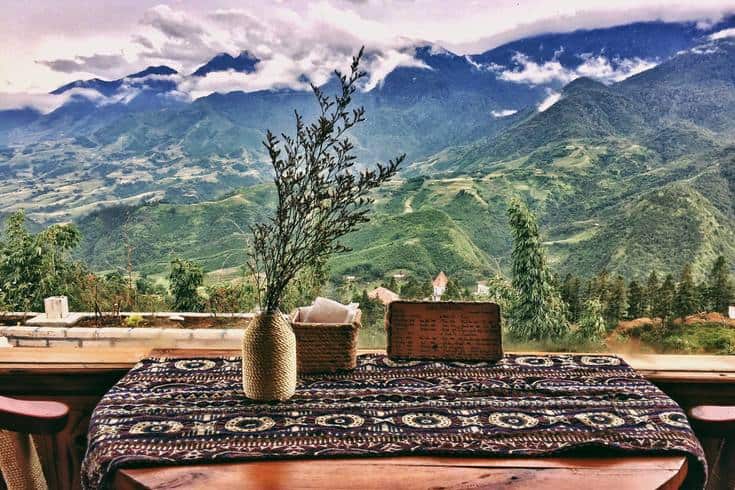
One of the great highlights of a trip to Sapa is having a drink at a cafe in the clouds where you can take in the lush beautiful views and enjoy a local drink. Most of these cafes can be found in Fansipan and Cau May streets. To name an outstanding cafe shop, it would be Cafe in the Clouds where you can spend time enjoying the eerie landscape and admiring the vistas over the green valley below. The cafe also offers a wide range of drinks and both local and international dishes. This could be a great experience to try in Sapa.
- To get the best view over the mountain and terraced rice fields, it is recommended to check the weather before visiting Cafe in the Clouds. In the early morning, it is likely to have fog so you could not see anything clearly.
13. Take Part in H’mong Sewing Class
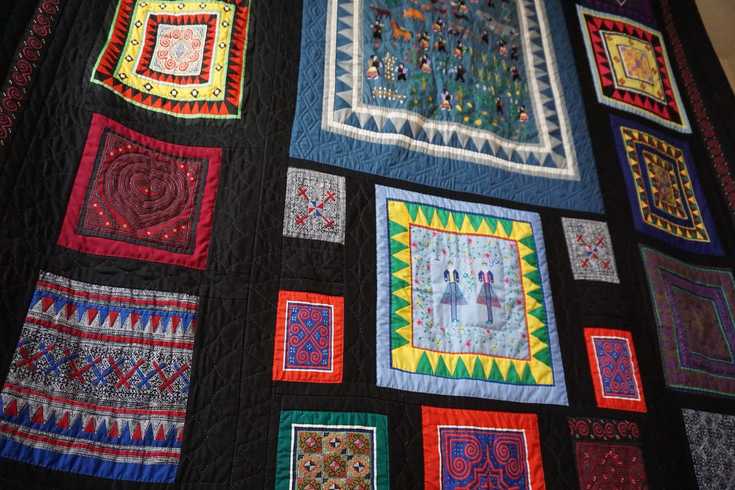
H’Mong ethnic minority counts a large population in this mountainous town. Their weaving technique is so unique and famous here. If you are curious about how they sew and make the products, just head to Indigo Cat where you can take the sewing class. An experienced local H’Mong person will teach you every step from picking the leaves, putting these leaves in the barrels, taking out, adding the lime,… to the final product. After that, you can try to practice and make your own product. The HMong are really good at English so they can explain to you carefully about the details. Besides, you can buy authentic weaving products for your family and friends here.
- If you are looking for some H’Mong clothing items different to the shops on the main street, this is the place to find some.
14. Watch The Ta Phin Commune Church Singing
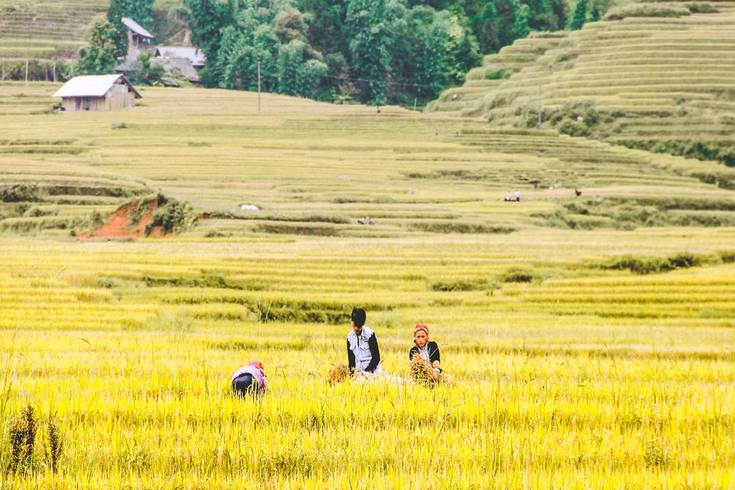
If you visit Ta Phin village during the very first weeks of spring, there will be a chance to witness one of the most beautiful traditions of the ethnic people called “church singing”. On this occasion, local people and visitors in the area will flock to the Ta Phin commune to watch this wedding tradition and listen to the beautiful singing . For most of ethnic minorities in Lao Cai province, marriages are still pre-arranged. During the church singing, the grooms and brides-to-be will participate in the procession to the village. The young men and women sing and dance in a competition to fulfill spiritual needs. The most exciting thing about this occasion is that you will see ethnic clothes in different styles and colors, creating a beautiful and unforgettable picture.
- You should come to the church early because there will be so many people attending this event.
So, there are many activities to try in the town. Above is our recommended list of best things to do in Sapa . If you have any other more interesting idea, please let us know so we can share with other travelers.
Most Popular

Foodlovers’ Guide to Eating in Sapa, Vietnam

Bac Ha Sunday Market in Sapa, Vietnam

Can Cau Market – A Unique Local Market in Lao Cai near Sapa, Vietnam

Trekking in Sapa: Must-know Points to Keep in Mind
More about sapa.
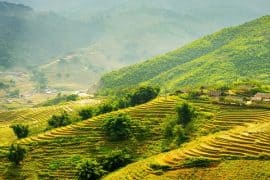
Ultimate Guide To Best Homestay In Sapa
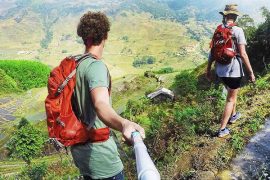
Can Cau Market - A Unique Local Market in Lao Cai near Sapa, Vietnam
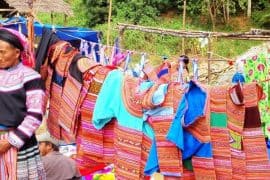
Coc Ly Market in Lao Cai, Vietnam
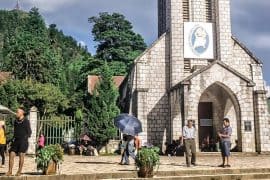
Sapa Church – An Ancient Symbol of the Sapa Misty Town
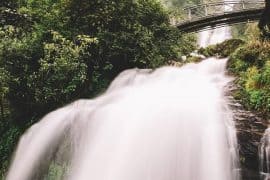
The Majestic Thac Bac Waterfall - Highlight of Sapa Tourism
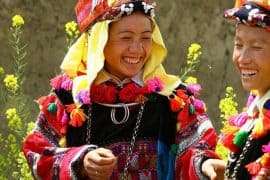
Interesting Nao Cong Festival in Sapa
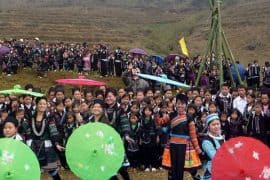
Gau Tao Festival - Discover the Cultural Beauty of Sapa, Vietnam
Tours may you like.
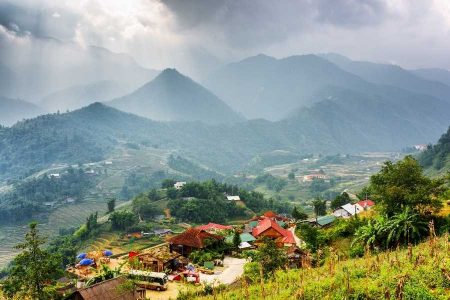
Sapa – Moana – Cat Cat Village – Fansipan…
3 days 2 nights
Start from: $139 /person
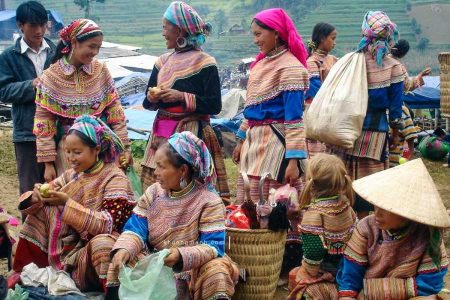
Sapa – Bac Ha Market Tour 3D2N, Daily Departure
Start from: $179 /person
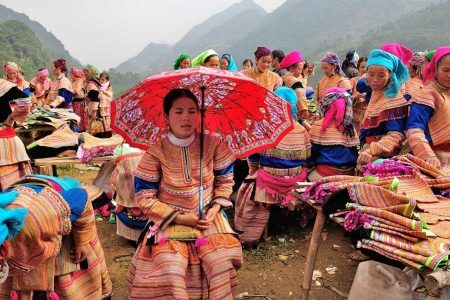
Sapa – Can Cau Market Tour 3N2D, Daily Departure
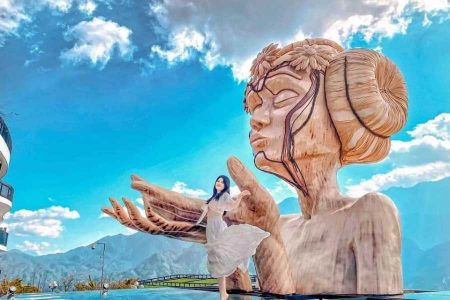
Sapa – Moana – Cat Cat Village Tour 2D1N,…
2 days 1 night
Start from: $85 /person
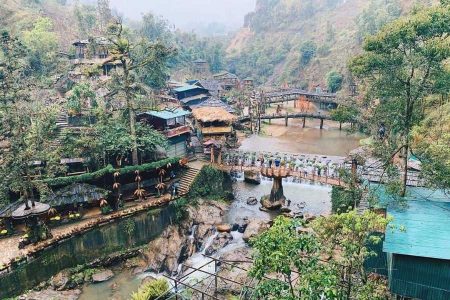
Sapa – Cat Cat – Moana – Fansipan Tour…
2 days 2 nights
Start from: $105 /person
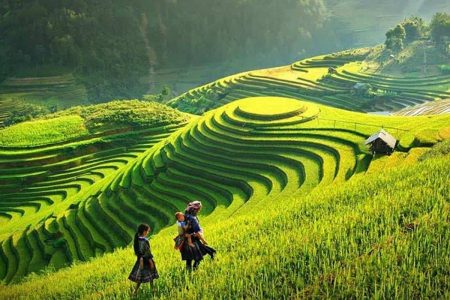
Sapa Trekking and Halong Bay by Bus 5-Day Full…
5 days 4 nights
Start from: $263 /person
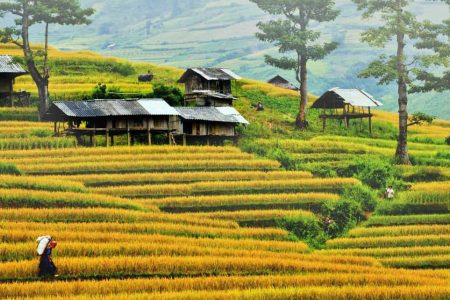
3 Days Honeymoon Sapa Tour from Hanoi
Start from: $365 /person
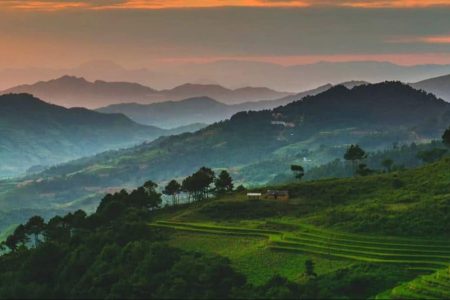
Sapa Hiking off Beaten Track
Start from: $50 /person
Destinations
Tours by style.
- Shore Excursions
Travel Guide
- Best Time to Visit
- Getting around
- Transportation
- Best Beaches
- Vietnam Honeymoon
- Travel esim to Vietnam
Our Company
- Responsible travel
- Terms of use
- Privacy Policy
- Recruitment
Connect with us:
- Email: [email protected]
- Hanoi, Vietnam: 23rd Floor, TASCO Building, Pham Hung road, Me Tri, Tu Liem, Hanoi.
- Ho Chi Minh City, Vietnam: 2nd Floor, VIPD Building, No. 4 Nguyen Thi Minh Khai, Da Kao Ward, District 1, HCMC
- Hong Kong: Vietnam discovery Travel Limited Room 1D, 2/F, Fu Tao Building,98 Argyle Street, Mongkok, Kowloon, Hong Kong

Where Do You Want to Go?
- Tell us details of your holiday plan.
- Get multiple quotes from our expert agents, compare, then customize further.
- Select & book the best deal.

Home » Travel Guides » Vietnam » 25 Best Things to Do in Sapa (Vietnam)
25 Best Things to Do in Sapa (Vietnam)
Beautiful Sapa is located in the northern mountains of Vietnam and is made up of a main town in the Muong Hoa Valley. Surrounding Sapa proper you will find a selection of local villages which are the home of some of the ethnic minorities in Vietnam. This means that this part of the country has a distinct and unique culture which makes a visit here not to be missed if you are in the region. On the outskirts of the town you will find jade hued rice paddies that are cut into the craggy mountain sides and the air is cooler as the mountains covered in a delicate mist. If you like trekking then this is definitely the place to come as the rugged scenery and mountain air makes this the perfect place to get outside and explore.
Here are the 25 Best Things To Do In Sapa …
1. Get out into the local villages

Sapa is basically a collection of small local villages which are dotted around the mountains.
This means that this is the place to come if you want to get out of the cities of Vietnam and experience something a little more rural.
You can stay in the local villages in a guesthouse with a local family and this will also give you a glimpse of how people have lived here for centuries.
The homestay programs here are not for everyone but for many who have tried them they are the highlight of a trip to Vietnam.
Suggested tours :
- Sapa: 2-Day Trekking Tour with Minority Village Homestay
- From Sapa: Sapa Valley Trek with Local Villages Visit (5 hour tour)
2. Visit Sapa Museum

Sapa doesn’t have too many ‘attractions’ in the main town but one of the few it does have is the Sapa Museum.
As such, this is the main (and only) place to come if your want to find a showcase of the history and culture of the region which stretches back to the French colonial period.
You can also explore galleries which are dedicated to the various ethnic minorities that live in this part of Vietnam and this is a great place to find out all about this unique section of the country.
3. Buy some local handicrafts

Sapa is known for its villages which are made up of local families who are also ethnic minorities in Vietnam.
These families include the Dao, the Yay, the H’mong and the Phu La and each of these ethnic groups is known for making amazing local handicrafts.
When you travel to the villages you can see how these are made and also pick up some traditional weavings or carvings which make great gifts and souvenirs.
4. Go hiking
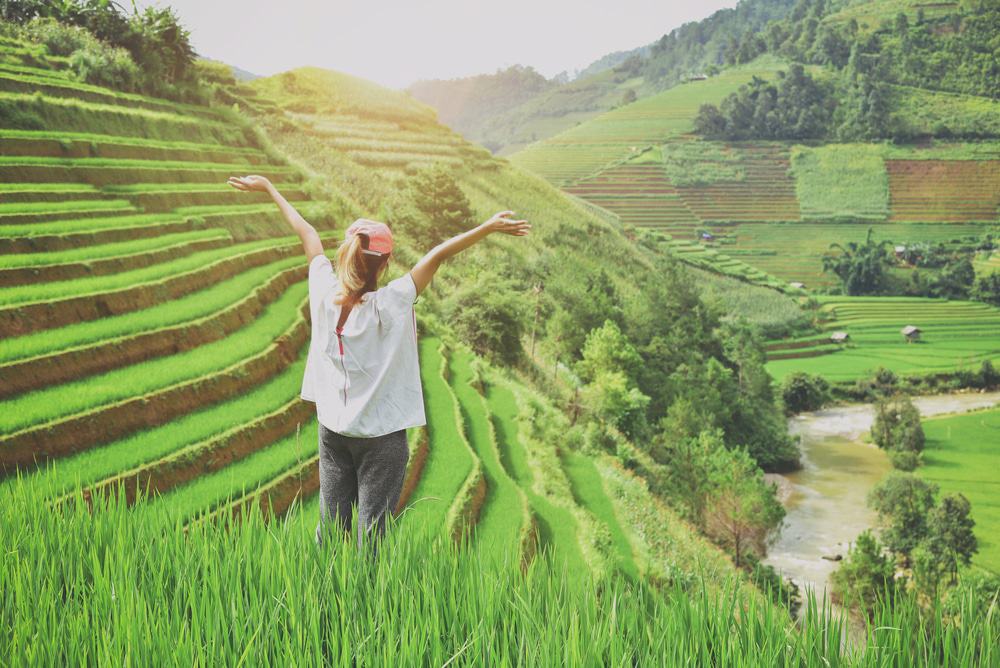
Sapa started out life as a scenic hill station during the colonial period and many people came here in the days of old to escape the heat and to enjoy the scenery.
The cool climate here also means that this is one of the best places to go hiking in Vietnam and much of Sapa is covered in lush green hills.
As well as the rolling mountains, you will also find gorgeous glittering waterfalls and stunning valleys which are dotted with craggy caves.
You can take a guided hiking tour of the best spots around Sapa or you can go it alone if you fancy an adventure.
5. Have a drink at Cafe in the Clouds

One of the great highlights of a trip to Sapa is the chance to take in the lush views and there is no better way to do this than by having a drink in one of the mountain bars.
One of the most famous is Cafe in the Clouds and as the name suggests you can spend time here enjoying the mist creeping across the eerie landscape and marvel at the vistas over the emerald green valley below.
You can get a range of drinks here as well as basic local and international dishes and this cafe also has Wi-Fi if you need to get online.
6. Join a H’mong Sewing Class

The H’mong indigenous group in Sapa is known for its sewing and weaving.
If you want to have a go at this firsthand, then you can visit Indigo Cat which is one of the most famous craft stores in town.
Here you can take a class where you can learn how to sew your own handicrafts and you will be taught by members of the local H’mong community.
If you prefer then you can simply visit the shop to buy some of the souvenirs on display which include beautiful textiles as well as other delights like local teas and spices.
7. Hike Fan Si Pan

Fan Si Pan has the claim to fame of being the highest mountain in Indochina and is located at some 3,143 meters above sea level.
The mountain is around 9 kilometers outside the center of Sapa and it can take a full week to get to the summit.
If you are feeling fit however and if you have the time, then this is an experience of a lifetime and you will be able to take in gorgeous views over Hoang Lien Son.
If you prefer, then you can also do some shorter treks which will take you part way up the mountain.
One of the highlights of trekking around Fan Si Pan is the chance to check out the local flora and fauna such as cute monkeys and antelopes.
8. Visit Cat Cat Village

The charmingly named Cat Cat Village is one of the oldest villages in the Sapa region and it is also known for being the home of the H’mong ethnic group.
The village is famous for its traditional industries such as flax and cotton production and there is a strong tradition of weaving here.
When travelers visit, they can learn all about these traditional techniques as well as spend time studying the H’mong culture.
9. Check out the barbecue restaurants

Vietnam is known for its delicious barbecued meats and these can be a welcome treat in the cold climes of Sapa.
If you want to find a high concentration of barbecue stalls in Sapa then you need to head to D Phan Si where you will find a number of simple joints set up along the road.
These stalls barbecue a range of meats including chicken, pork and beef over hot coals and these are served with vegetables and sometimes rice wraps so that you can roll everything together to make a toothsome kind of spring roll.
10. Walk to Silver Waterfalls

Sapa is famous for its waterfalls and one of these is Silver Waterfalls.
This is a collection of gushing cataracts that tower to a height of some 200 meters.
Located just up the path from Silver Waterfalls is the beautifully named Love Waterfall which is a place that is steeped in local legend.
Locals will tell you that fairies used to bathe in the waters here and although it is a long trek to both waterfalls it is more than worth it for the pretty scenery.
Suggested tour : From Sapa: Waterfalls, Trekking and Tribal Villages Tour
11. Explore Fairy Cave
Another key attraction is Sapa is Fairy Cave which is located a little way upstream from the Chay River.
The cave looks like something out of a fairy tale, as the name suggests, and the scenery here is reminiscent of Halong Bay.
The cave is said to be sacred in Vietnam and the mountain here is also cut through with babbling streams which make the perfect place to go for a swim at the end of a long trek.
12. Go boating on Sapa Lake

Sapa Lake is one of the main attractions in town and is just a 5 minute walk away from the main church.
The lake allows you to take in the beauty of Sapa from the water and this is a popular place to come for local families at the weekends.
One of the great highlights of the lake is that you can rent a peal boat for an hour and shoot all over the glassy surface of the water and enjoy the sights.
13. Visit Tram Ton Pass

If you want to see more of the scenery in Sapa then you need to head for the Sapa and Lai Chau road which then turns into the Tram Ton Pass.
The pass stands at an elevation of some 1900 meters which makes it the highest pass in all of Vietnam.
You will find a number of lookout points here which have amazing views over the surrounding area and you can also combine a trip here with the nearby Silver Waterfall.
14. Shop at Sapa Market

If you want to enjoy a traditional shopping experience in Sapa, then head for Sapa Market which is also conveniently located close to the local bus station.
Here you will find a range of colorful local produce as well as a fresh meat section which is certainly not for the faint of heart.
You will also find some handicrafts here sold by the hill-tribes people that live in the villages around Sapa.
15. Watch the Ta Phin Commune Church Singing

If you happen to be in Sapa during the first few weeks of spring then you can travel to Ta Phin Village where you can watch the annual church singing.
This is actually a traditional wedding tradition and you will get to watch brides and grooms parading through the village while locals sing and dance around them.
The colorful outfits worn by the young lovers are worth the trip itself and visitors are welcome to watch the festivities as long as you are respectful of the proceedings at the same time.
16. Walk around Muong Khuong Bird Market
Many towns in Southeast Asia have a local bird market and Sapa is no exception.
If you visit Muong Khuong Bird Market then you will get to watch the different tribes of the region getting together to listen to the birds sing.
In Vietnam many houses will hang a bird cage in front of their home to bring good luck, and people buy and trade birds from the market.
As such you can listen to avians such as nightingales signing and the market is a bustling affair which is best visited in the morning if you want to see it at its peak.
17. Check out Muong Hoa Valley

The Muong Hoa Valley is one of the jewels in the crown of Sapa and you will find the Hoa Stream cleaving through the valley and running through to villages like Han Thao and Tan Van.
You can take a tour from Sapa that will lead you through the amazing valley and there are even paintings on stones here that are said to date back some 3,000 years.
If you walk down to the bottom of the valley then you can also enjoy some river hiking along the Hoa Stream.
Suggested tour : Private Hoang Lien National Park & Tribal Village Trek
18. Drink some wine in Ban Pho Village

One of the best villages to visit around Sapa is undoubtedly the Ban Pho Village which is the home of the Mongolian Bac Ha tribe.
The village is also known for its wine making industry and when you come here you can learn how the villagers have been making corn wine here for centuries and even sample some of this signature tipple yourself.
You can also easily visit Ban Pho as part of a day trip from Sapa and as with all the villages in the region it also has spectacular views over the rice fields.
19. Admire Sapa Church

Sapa doesn’t have a huge range of monuments, but one of the most recognizable buildings in town is Sapa Church which dates back to the French colonial period.
The church is closed throughout the week and only opens for Mass every Sunday, but you can check out the exterior which is very pretty or venture inside if you happen to be here at the weekend.
20. Go for a walk around Ham Rong Resort

Ham Rong Resort is actually something of a misnomer as this is not a resort but more of an informal park area which sits at the base of Ham Rong Mountain.
Here you will find a cool and serene place to go for a walk although be warned, there are a lot of steps that lead you up the mountainside.
Still, if you don’t want to tackle some of the larger mountains in the region such as Fan Si Pan then this is a good place to go for a walk for a few hours and take some photographs across the valley.
21. Take a cooking class

Vietnam is world famous for its delicious food, and with that in mind you may want to have a go at cooking it yourself.
You will get the chance to learn from a H’mong chef who will take you out to the local market so that you can learn all about the traditional ingredients used in Vietnamese cooking.
Classes usually include learning how to cook five local dishes which you can then eat in the communal dining room at that end of the class and also pair with some local wines.
22. Dine at the Hot Pot Stalls

The weather in Sapa can be much colder than other parts of Vietnam due to the advanced elevation.
As a result, if you feel like you need warming up, then you may want to take a trip to the famous Hot Pot Stalls of Sapa.
These are considered to be a local delicacy in the town and this kind of hot pot is known as lau in Vietnamese.
The hot pot consists of meat stew which is then cooked with local vegetables such as cabbage and mushrooms which makes for simple yet hearty fare.
25. Tour the rice fields

The main reason why many people come to Sapa is to visit the rice fields, and even if you decide not to stay overnight in a homestay with a local family, a trip out into the countryside is not to be missed.
You can book a guided tour from Sapa which will take you out onto the famous stepped rice terraces and you can admire the views and also learn now the locals till the fields and harvest the rice.
25 Best Things to Do in Sapa (Vietnam):
- Get out into the local villages
- Visit Sapa Museum
- Buy some local handicrafts
- Have a drink at Cafe in the Clouds
- Join a H’mong Sewing Class
- Hike Fan Si Pan
- Visit Cat Cat Village
- Check out the barbecue restaurants
- Walk to Silver Waterfalls
- Explore Fairy Cave
- Go boating on Sapa Lake
- Visit Tram Ton Pass
- Shop at Sapa Market
- Watch the Ta Phin Commune Church Singing
- Walk around Muong Khuong Bird Market
- Check out Muong Hoa Valley
- Drink some wine in Ban Pho Village
- Admire Sapa Church
- Go for a walk around Ham Rong Resort
- Take a cooking class
- Dine at the Hot Pot Stalls
- Tour the rice fields
You are using an outdated browser. Please upgrade your browser to improve your experience.
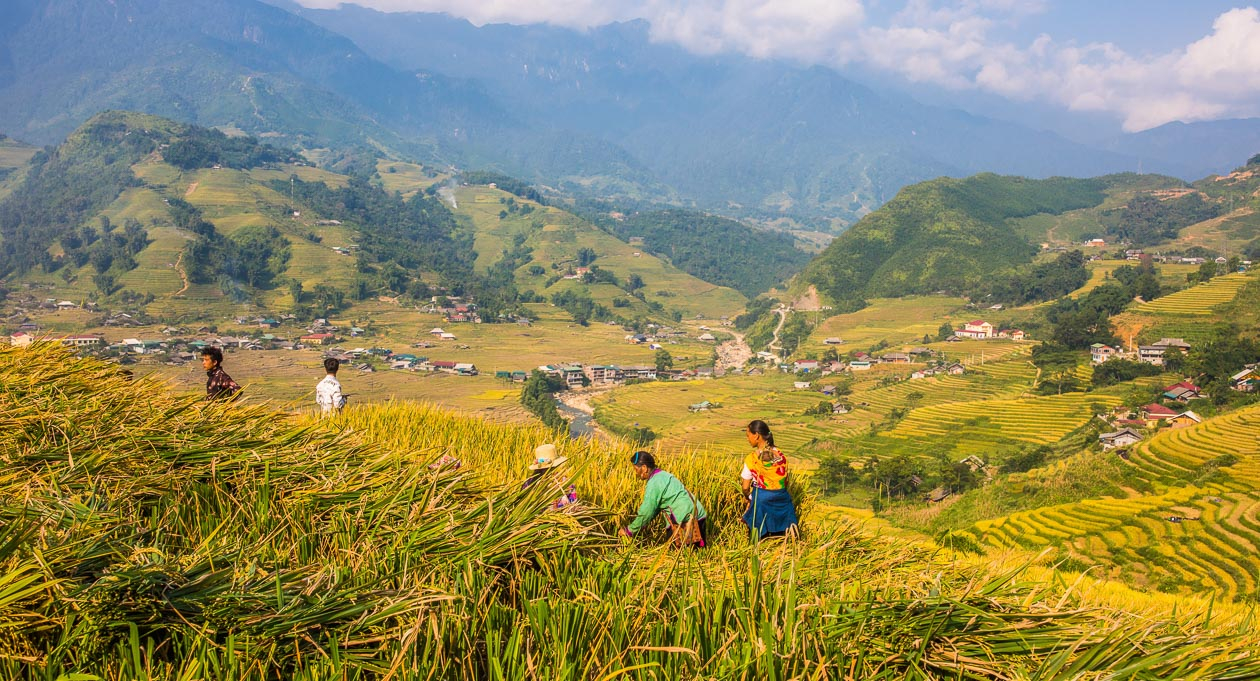
You may also like
Nearby places.
- How To Get There
Sapa town stands at the head of a deep valley of magnificent rice terraces that are still farmed today as they have been for centuries. Backdrops don’t get much more spectacular. Enticing ribbons of road lead the eye down to the valley floor, white-water rivers rush among rice fields, and lush green mountains stretch into the distance as far as the eye can see. The highest peak in the region, Mount Fansipan, crowns the ragged ridge line high above town.
Top things to do in Sapa
Summit Mount Fansipan
A 6-kilometre cable car journey will whisk you 3,143m to the summit of Mount Fansipan in just 15 minutes. Wander the pagoda complex before climbing the last few steps to the summit. The views from the ‘Roof of Indochina’ are unmatched.
Visit an ethnic minority market
Every Sunday the Bac Ha market bursts into life, as hundreds of traders from the Dzao, Han, Xa Fang, Tay and Thai tribes descend on the market, decked out in traditional garb. Expect a riot of colour and excited haggling.
Go trekking in the hills
Sapa offers some of Vietnam's best trekking, and some villages such as Cat Cat and Ta Phin can be seen without a guide. Book an overnight trek to wander through rice terraces, bathe in waterfalls and experience ethnic culture firsthand.
Stay in a mountain lodge
Stay outside the tourist hub of Sapa in simple comfort at a mountaintop lodge. Sapa is home to excellent lodges and homestays. Set among the rice terraces, you’ll brush shoulders with farmers as they go about their daily lives.
Mountain biking is a great way to get out and explore lesser-visited corners of Sapa. The annual Vietnam Mountain Marathon attracts some 4000 competitors who run buffalo-beaten trails ranging from 10 to 100 kilometres.
Sapa Weather
The best time to visit Sapa is in September and October when the rice terraces are at their most splendid; or in April and May when the weather is ideal and skies are clear. For those who don’t mind hot weather, June to August is a fine time to visit. Expect chilly weather from November to March.
Sapa Transport
Overnight trains are the most popular way to reach Sapa via the neighbouring province capital, Lao Cai. Upon arrival, transfer vans finish the journey up the mountains. Alternatively, regular buses and shuttle vans run from Hanoi with a journey time of five to six hours, stopping in the centre of town. As a former hill station, Sapa has plenty of steep roads and pathways. Many visitors get around by foot, or by taxi. Adventure-seekers can rent mountain bikes to explore the trails along the valley.
In this article:
Aristo International Hotel
Victoria sapa resort and spa, sapaly hotel lao cai, topas ecolodge.
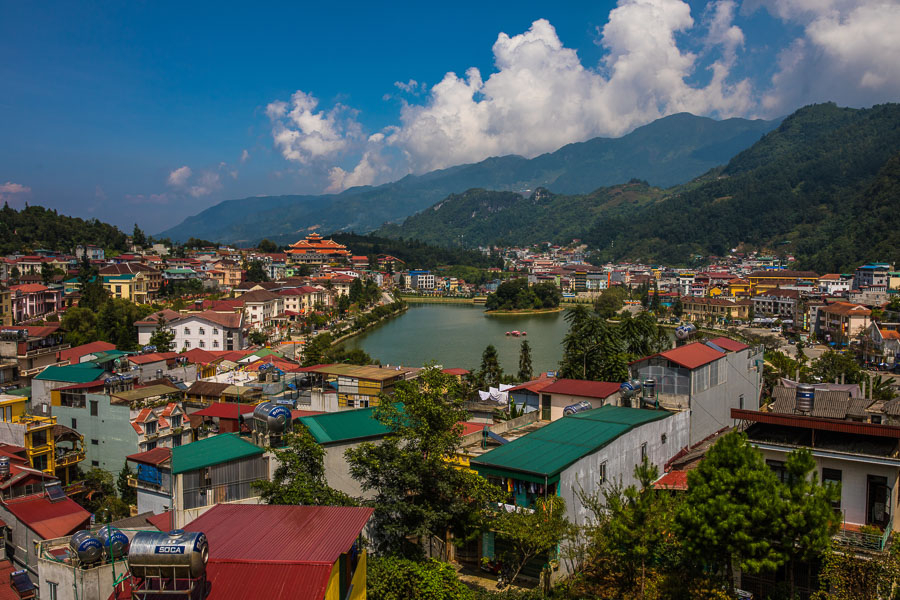
- You are here:
- Places To Go
- Northern Vietnam
Create an account
Already have an account? Click here to sign in
By clicking submit, you agree to our Privacy Policy and Terms of Use
Sign in with your social accounts
Sign in with your email
Forgot password? Click here to get it back
Don't have an account? Sign up here
Forgot Password
The entered email has subscribed for Vietnam Tourism monthly newsletter

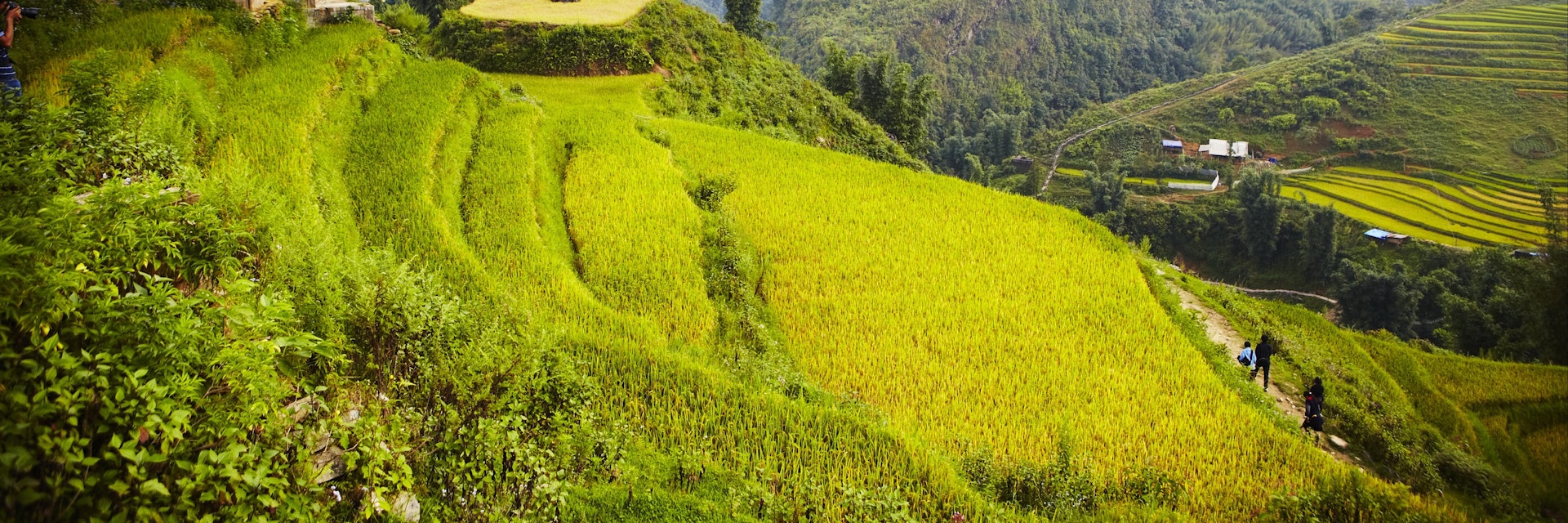
Established as a hill station by the French colonialists in 1922, Sapa today is the tourism centre of the northwest.
Leave the planning to a local expert
Experience the real Sapa. Let a local expert handle the planning for you.
Attractions
Must-see attractions.

Fansipan Cable Car
Towering above Sapa are the Hoang Lien Mountains, once known to the French as the Tonkinese Alps and now a national park. These mountains include the…

Sapa Museum
An excellent showcase of the history and ethnology of the Sapa area, including the French colonial era. Dusty exhibitions overview the various ethnic…
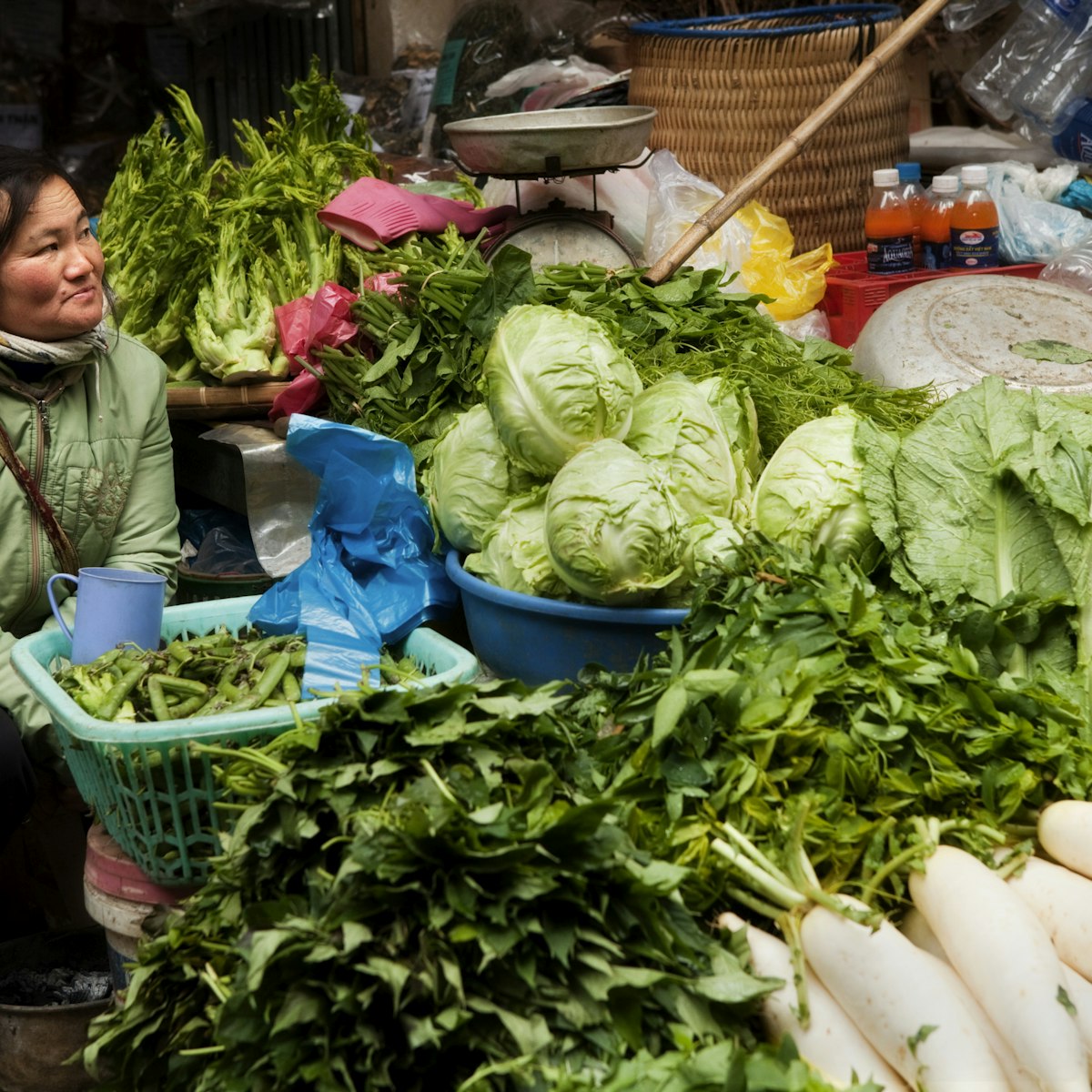
Sapa Market
Turfed out of central Sapa and now in a purpose-built modern building near the bus station, Sapa Market is still interesting, and hill-tribe people from…

Tram Ton Pass
The road between Sapa and Lai Chau crosses the Tram Ton Pass on the northern side of Mt Fansipan, 15km from Sapa. At 1900m it's Vietnam’s highest mountain…

Sapa Church
Sapa's small stone church was built by the French and is still a central landmark. It opens for Mass on Sunday and on certain evenings for prayers.
Plan with a local
Experience the real Vietnam
Let a local expert craft your dream trip.

in partnership with getyourguide
Book popular activities in Sapa
Purchase our award-winning guidebooks.
Get to the heart of Sapa with one of our in-depth, award-winning guidebooks, covering maps, itineraries, and expert guidance.
Everything you need to know BEFORE visiting Sapa Vietnam
By: Author Adam
Posted on Last updated: 2 February, 2024
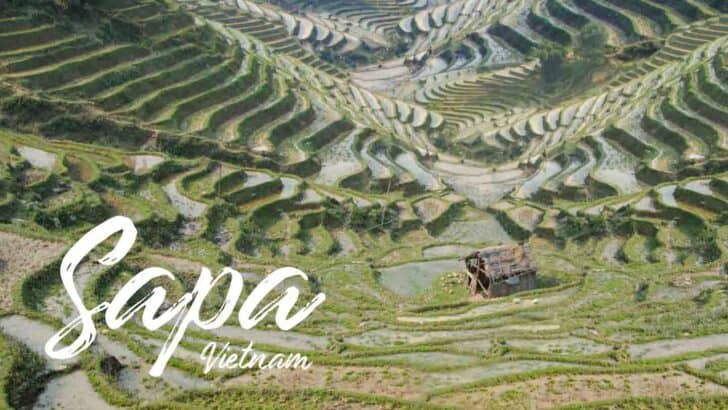
Lying in the northwest of Vietnam, not far from the border with China, Sapa is an absolute treat to visit. Sapa Vietnam lies amidst beautiful mountains and is surrounded by brilliant green terraced rice fields – well, that is if you visit at the right time of year!
While the scenery is stunning, Sapa is just as renowned for its intoxicating cultural makeup. The tiny villages dotted upon the hillsides are home to a diverse array of ethnic minorities, each with their own rich culture and customs.
Combining both culture and natural beauty into one enticing package, Sapa is definitely worth visiting if you have the chance. While its remote location does make it a bit of a pain to get to, it’s also what has preserved the scenic beauty and rich cultural heritage for so long!
Here is our travel guide to Sapa Vietnam with everything you need to know before your visit!
*When looking for the best price and biggest selection of hotels in Sapa check prices on Booking.com , we’ve found they are the best option and have a great cancelation policy.*
Sapa Vietnam Travel Guide
With each passing year, it gets a little bit easier to travel to Sapa and Northern Vietnam, but it is still one of the more challenging destinations to reach due to its remote location. That same remoteness is much of the appeal to most visitors.
Here in Sapa, you’ll have a chance to see rural life and experience cultures that are unique to this part of the world. Below is our first-hand guide from our time spent exploring Sapa, Vietnam.
Jump to Info on Sapa:
- How to get to Sapa – Hanoi to Sapa
- Things to do in Sapa
Trekking in Sapa Vietnam
- Weather in Sapa
Rice Terraces in Sapa
- Sapa Cultures and history
- Tips and Sapa FAQ
How to Get to Sapa Vietnam
As you might have gathered, Sapa lies in quite a remote region, so getting there can be a bit of a challenge – although you surely won’t regret it! While some routes are easier than others, you will need to plan carefully so that you don’t end up spending too much time in transit.
Hanoi to Sapa By train
The easiest, most convenient, and most popular way of getting to Sapa Vietnam is by train. The journey usually takes around eight hours if you’re coming from Hanoi. However, this only takes you to Lao Cai Railway Station; from there, you need to take a shuttle bus to reach Sapa.
There are a number of different options when it comes to the train; it’s a good idea to book in advance, as during the summer months and at weekends, it can get quite full, and the nicer cabins may get booked out. Many people decide to take the overnight express train to save on accommodation and sleep throughout the journey.
When booking your train tickets, it’s worthwhile going to the station yourself, as you may find that some travel agencies don’t always provide you with what you booked! There are a number of ‘classes’ for you to choose from; prices vary accordingly, depending on whether you booked a ‘soft bed’ with a private railway company or a ‘hard bed’ with the national Vietnam Railways. You can also choose to stay in a private cabin or a four or six-bed bunk compartment.
Prices also fluctuate depending on what time of year you go; they increase substantially during national holidays. When taking the train, you probably want to book one of the nicer options as they can be a bit grimy.
As you can see, the price of the train really depends on what option you choose. Tickets start from $18 and go all the way up to over $100 if you choose the really nice cabin!
Once you arrive at Lao Cai Railway Station, you need to take a shuttle bus to Sapa, Vietnam. Make sure to negotiate to avoid being overcharged; the fair price is around 50,000 Dong.
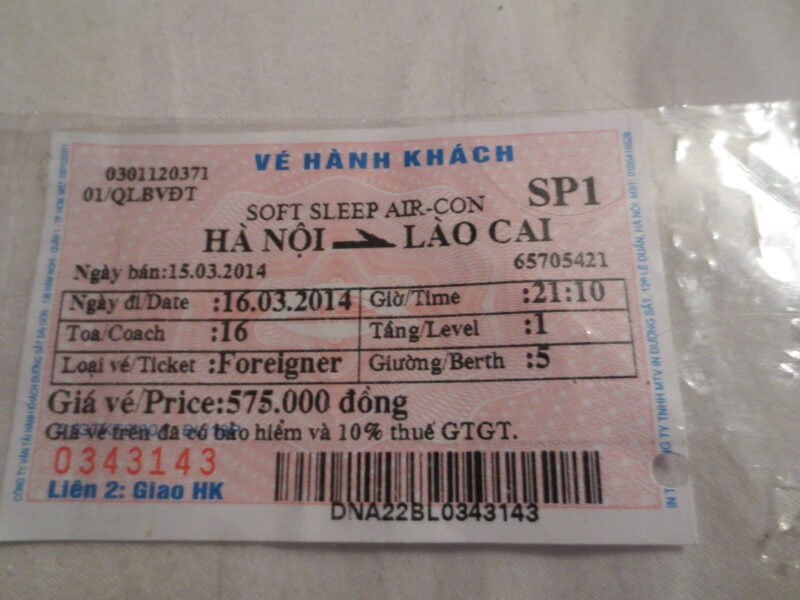
Hanoi to Sapa By bus
Another option is to take the bus to Sapa Vietnam. With the bus, the journey time is slightly shorter; it usually takes around six hours from Hanoi. As the terminus is in the center of town, you don’t have to mess around finding a shuttle bus.
Buses depart at all times of the day from Hanoi. Prices fluctuate depending on if you take one of the luxury lines or one of the more basic ones; some even drop you at wherever you have arranged to stay in Sapa.
Prices range from $11 for the cheaper bus lines up to around $20 or more for the nicer ones.
While you do pass some lovely scenery on the way to Sapa Vietnam, and the buses are certainly comfortable, the mountain roads can be quite windy and dangerous. You may be better off taking the longer but safer train journey after all!
Things to do in Sapa Vietnam
There are loads of great things to see and do in Sapa Vietnam. Visitors usually love all that the charming town has to offer – these suggestions only skim the surface!
1. Trek to the local villages
Trekking to some of the nearby local villages is a must when in Sapa, you’ll pass some absolutely gorgeous scenery. Once you arrive, you’ll be immersed in the hill tribes’ culture and customs and come away richer for the experience. The Cat Cat Village is particularly popular amongst tourists, as you get to see how the Hmong villagers farm the valley and produce handmade textiles.
2. Stop by the Sapa Culture Museum
This wonderful little museum is well worth stopping by if you want to learn more about the local history. Its exhibits and galleries highlight the different costumes, traditions, and cultures of the various hill tribes.
3. Hike up the highest mountain in Southeast Asia (or take the cable car)!
Fansipan towers to a height of 3,143 meters and is the highest mountain in Southeast Asia. Hiking to the top may be tough, but you’ll be rewarded with sweeping views of the beautiful countryside.
Alternatively, you can take the cable car up and enjoy the scenic view from its window if hiking in Sapa isn’t on your bucket list! The region surrounding Sapa Vietnam is often very foggy, so some visitors end up leaving without ever having glimpsed any of the stunning mountain scenery for which it is renowned.
4. Visit the lively Sapa Market
Stop by Sapa Market to experience the less-touristy side of the town and meander along the stalls, looking at all the fresh, colorful produce that is brought in from the surrounding area. Buy some local handicrafts which have been so expertly made by the local hill tribes as gifts or souvenirs.
5. Marvel at the stunning view from Heaven’s Gate
Although you’ll find beautiful scenery almost everywhere you go in Sapa Vietnam, the delightfully named Heaven’s Gate is well worth a visit; the views on offer are just breathtaking. The valley falls away before you, and mountains stretch away into the distance, seemingly going forever.
While it does look incredible, visitors sometimes find that fog covers everything but the highest peaks! Not far from Heaven’s Gate is the Thac Bac Waterfall; due to their proximity to one another, it is worth combining the two when making a trip.
6. Ham Rong (The Radio Tower) – The views are decent from up here, but the rest of the park is extremely confusing. Large fiberglass cartoon statues, paths to nowhere, and other strange sights just left us wondering why we paid 70,000 dong per person to climb up here.
Related Article: Things To Do In Hoi An
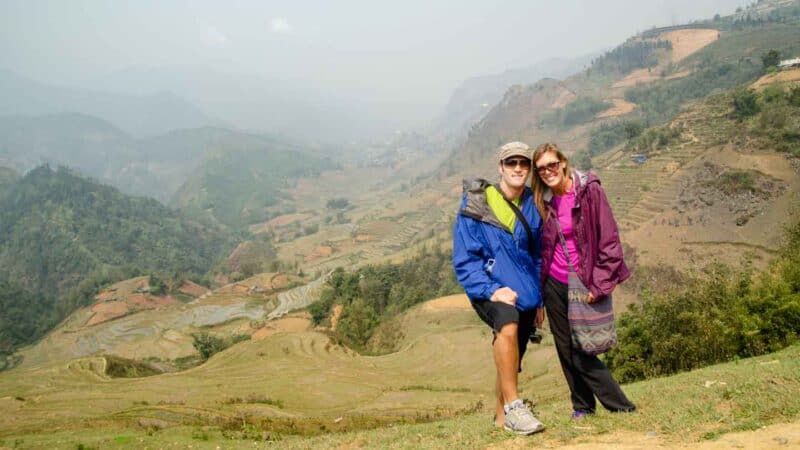
Most people make the long voyage up here to do trekking in Sapa Vietnam, and rightfully so. The allure of walking through rural Vietnam through stunning terraced rice fields with local people.
It sounds like a bucket-list-worthy place, doesn’t it? It surely can be, but getting an authentic experience gets more challenging every year.
Multiday vs. Single Day Trekking trips from Sapa
One isn’t necessarily better or worse but may be a better option depending on the traveler and the experience they are looking for. Here, we have broken down what you could expect while trekking in Sapa, Vietnam, on a single-day hike or a multiday trek.
Trekking Day Trips from Sapa Town
Single-day trips to trek through the villages and rice terraces outside of Sapa are easy to arrange in Sapa or before you get there. This type of tour is better for those who would prefer to stay in a hotel rather than a homestay while trekking, aren’t up for long treks, or don’t have the time for a multi-day hike.
The downside of a single-day trek is that you don’t get as far from the town, and you will only get to go to some of the more visited and somewhat less authentic villages. Plus, overnighting in a homestay is a unique experience and gives better insight into local life.
However, this is a double-edged sword since trekking and homestays are the most popular activities in Sapa. They themselves are slowly or not so slowly changing the cultures that visitors are trying to see.
- Shorter time commitment
- Less demanding physically
- Generally smaller or private groups
- More comfortable accommodation options
- Slightly less authentic experience
- Less access to remote villages and landscapes
Multiday Sapa Trekking
These are best for the adventurous types who are looking to get out of the city and see a glimpse of what local life is like in rural northern Vietnam.
- More authentic experiences
- Access to more remote areas of Sapa
- More immersed in local cultures
Cons:
- Generally larger groups
- Generally less comfortable accommodation options
Weather in Sapa Vietnam
Most people see pictures of Sapa and probably assume it’s always bright green rice terraces, but that’s not the case. Due to its northern location and high elevation, Sapa’s weather is drastically different and the city sees many changes seasonally.
Sapa Vietnam Dry Season & Monsoon (rainy) Season:
Dry Season: Traditionally, the driest months are from October until early to mid-April. Now that doesn’t mean it never rains, even during the dry months Sapa can get rain and is often humid with fog rolling over the mountains and hills.
During this time, historically, Sapa will have 8-15 days with some amount of rainfall and accumulate 30-80 mm (1.1-3.1″) of rain per month.
Rainy or Monsoon Season: Mid-April – Mid or End of September traditionally is the monsoon season in Sapa. However, in the past few years (2016 – 2019), we have seen a lot of volatility in what was once a very predictable cycle.
During this time, expect some rainfall just about every day and monthly accumulations of around 300-1000+ mm (11.1-31.1″) of rain. The 2017 & 2018 rainy seasons brought ten-year highs of rainfall with 1000-1500mm (31.1-59.0″) of rain per month.
Sapa Weather by month
December to February: These are the coldest months, with the average temperatures being around 13°C with highs close to 18°C and lows dropping to around 10°C. It does snow in Sapa, on average the city will see 1-4 snow days per year, however, 2017 and 2018 did not have any snow. If you are lucky, the rice terraces look stunning with a sprinkling of snow on them.
March to Mid-May: This is still part of the dry season with some of the hottest temperatures of the year, with average daily highs around 30° in April and a few degrees cooler in March and May. depending on the year, May could also be classified as the rainy season, with some years seeing as much rain as the following months. The second half of May will be getting pretty wet.
Our last visit was in March, and even though this should be one of the driest months, it was still very humid, so humid it broke one of our computers left inside a backpack in the hotel room.
Also, most evenings, a thick fog would roll in and cover the streets, making it hard to see more than 10 meters (30ft) in front of you; this is probably the foggiest place we have ever visited.
June to August: During this time of the year, it’s the rainy season in Sapa Vietnam. Temperatures cool off a few degrees, and rain increases dramatically. The pros of traveling during this season are that the rice fields will be at their peak. If you want to see bright green rice fields, this is the time to come.
Mid-September to December: September, much like May, can be rainy, especially at the beginning. By October, the rains have generally slowed but still have some rainy days.
The climate in Sapa only allows for one rice crop per year, meaning the terraces aren’t always bright green. The best time to see the rice terraces at their peak is also the rainiest time of the year. No matter what time you visit, there is something to see, and here’s what to expect at each time of the year in Sapa.
December to April: During this time, the rice terraces are empty. They will be somewhat green from grasses growing around them, but where the rice actually grows, you will see still ponds of water – which can be quite nice.
April to May: Famers will be planting the rice in their fields and terraces. Some planting may happen as early as March and April.
June to September: The hills and terraces will be the bright green you might expect when you think of Sapa. Be prepared for rainstorms during this time of year. If we go back to Sapa, it would be during this time.
October-November: At the end of the season, the terraces will turn golden brown when it is time to harvest the rice. This is a great time to get photos of farmers harvesting their fields, largely by hand, and getting them ready for the following year.
The Culture of Sapa Vietnam
Sapa is renowned in Vietnam for the ethnic minorities who live there. It is these hill tribes that give the town its unique character and feel – everywhere you go, you see the rich cultural heritage.
In this respect, Sapa is unlike anywhere else in the country. This is really what makes it such a special place to visit. At the Sapa Market, for instance, you’ll come across locals from various tribes wearing traditional clothes and selling handmade artisanal goods. Every now and again, you may come across a wedding or local celebration.
While the stunning scenery is undoubtedly one of Sapa’s main draws, its intoxicating cultural makeup is what many people come for. Trekking to some of the nearby villages in Sapa that are scenically located amongst paddy fields or hugging hillsides is a must if you want to gain a greater insight into local heritage and traditions.
Alongside the numerous day trips and treks on offer, which take you to visit the hill tribes’ villages, visitors can also elect to stay in a homestay with one of the families. This is a rewarding experience as you get to make new friends and learn about the local culture at the same time.
While the Hmong and Dao people make up the majority of Sapa’s population, other ethnic minorities are present in the shape of the Tay, Giay, and Xa Pho, with each having their own unique characteristics. Most people in Sapa and the surrounding villages work in agriculture, so you’ll see lots of people working in the rice fields.
The hill tribes also produce some lovely hand-made ethnic clothes, textiles, and artisanal products. Purchasing some is a great way to support the local culture while coming away with a memento of Sapa Vietnam. At the sight of a sale, however, you may be surrounded by more vendors, and children will often approach you selling small items and trinkets.
In Sapa, it is possible to take a Hmong sewing class so you can learn how to reproduce the local textiles and clothes for which the town is renowned.
The History of Sapa Vietnam
Due to Sapa’s remote location amid the mountains, not much, if anything, is known about the first people to inhabit the area. Indeed, all that’s left of them are hundreds of petroglyphs – lines carved into rock; experts believe that these date to the 15th century.
While you can visit them when in Sapa, Vietnam, most of them have been worn down over the centuries by the weather and aren’t that impressive to look at.
The first groups to move into the area after these earlier inhabitants were the Hmong and Dao peoples; they are still the most prominent of the ethnic minorities in Sapa today. The Giay and Tay people also moved into the mountain range around this time. The fact that the more numerous lowland Vietnamese (the Kinh) didn’t colonize the area meant that the ethnic minorities’ traditions and cultures were preserved.
As the valleys and highlands around Sapa were so secluded, the town didn’t even appear on any maps until the French showed up in the late 1880s; even then, it was often under the name ‘Chapa’ due to how the French pronounced it. From then on, French influence only increased, and military parties and missionaries soon started showing up.
From 1891 onwards, the entire region was ruled by the French colonizers, who sometimes sent the military into Sapa to silence any dissent or resistance in what was a sensitive area due to its proximity to China. Over the following decades, French civilians and a military garrison moved into Sapa, changing the town’s look in the process.
Much of Sapa was destroyed in the hostilities that took place from the end of World War II until 1954; almost all of its colonial buildings were lost during this period. Vietnamese nationalists fighting for independence would target French buildings and personnel, while the French carried out bombing raids on the town in a bid to suppress the resistance.
Due to all the fighting, most of the population left Sapa. Only in the early 60s did the town come back to life again, as the new socialist government encouraged lowland Vietnamese to migrate to the highlands.
While the Vietnam War (or as they call it, the American War) and further wars against both Cambodia and China did not have much impact on Sapa, it wasn’t until 1993 that tourists began coming to see its wonderful sights, when the socialist government opened the country to international tourism.
Although, in recent years, Sapa has become increasingly touristy, it still has many authentic parts to it, and the scenery alone makes it worth a visit.
Related Article: Best Vietnam Destinations
Sapa Vietnam Basics | FAQs
Does Sapa have an ATM? : Yes, several
Is there Wifi in Sapa? Yes, our hotel had Wi-Fi, and our SIM card had service as well.
Helpful Sapa Tips
Book your tickets in advance for the train – The nicer cars fill up, especially around the weekends. On the way to Sapa, we were in the caboose, people sleeping on the bathroom floor, and a rat scampered through our cabin as we woke up in the morning.
Don’t overpay for the shuttle to/from Sapa – The fair price is 50,000 Dong per person. The drivers will start at 200,000+, but stick to your guns. They will eventually give in and then ask you not to tell the other passengers who didn’t negotiate as well as you.
Go to the Supermarket – The convenience stores in town are very overpriced. We walked every other day up to the supermarket across from the lake to get water, snacks, and bread. Their baguettes are very nice and only 5,000 dong.
Best time to visit Sapa -The best time, according to locals, is July-August, but that’s also the rainy season. Because of the climate, Sapa only gets one rice harvest, and if you don’t time it right, the picture-perfect fields of green rice may not be full. They are still pretty impressive, but it would be ridiculously pretty if they were bright green.
Restaurants in Sapa – Every restaurant in town is significantly more expensive than everywhere else in Vietnam. It was difficult to find a meal for under 100,000 dong ($5 USD), which I know in the rest of the country I can get fat for that much per day!
The worst part was that the food was bad, even for the elevated prices. I had a few meals that were actually decent, but it was very disappointing because I really liked the food in Vietnam overall.
Related Articles
- 13 Must Visit Vietnam Destinations
- 10 Things To Do In Hanoi Before or After Halong Bay
- 7 Things I Will Not Miss About Vietnam
- Best Things to Do in Thailand
- Destination Investigation – Hanoi
Don’t forget to Pin me for later!
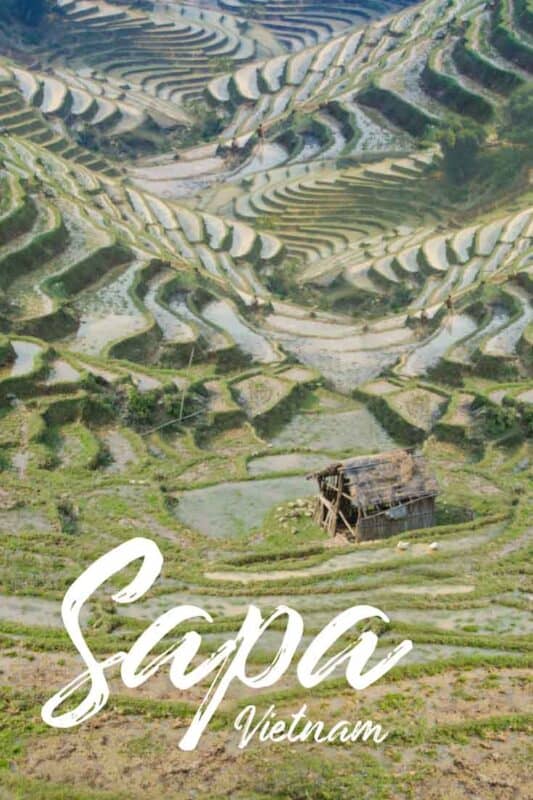
The Top 11 Things to Do in Sapa, Vietnam
:max_bytes(150000):strip_icc():format(webp)/mike_borobudur-5b6d3ea446e0fb0025fcb683.jpg)
Sapa, Vietnam sits at the heights of the Hoang Lien Son mountain range, a six-hour drive northwest of Hanoi. That distance is emblematic of the vast gulf between the Vietnamese capital and Sapa: the built-upness of the city versus Sapa’s wide open spaces, city brusqueness versus the warmth of Sapa’s tribes. Expect to get a workout if you’re planning a visit—Sapa is well-known for its long hiking trails to scenic villages, rice terraces, and mountain viewpoints. With eight ethnic minority groups residing here—including the Hmong, Dao (Yao), Giáy, Pho Lu, and Tày—you'll get to experience a variety of cultures as well.
Read on to find out what to expect if you take the time to visit Sapa. Set aside several days for your trip because there’s a lot to see and do!
Trek to Fansipan Peak
Huynh Thanh Huy / Getty Images
The highest mountain in Indochina rises about 10,300 feet above sea level. Despite its soaring height, Fansipan can easily be summited by any reasonably-fit trekker, even novices. Depending on the route taken, a direct hike to the top can be done within 10 to 18 hours minimum. Experienced guides will stretch out the climb to two or three days, especially for novice trekkers. The route will take you past a variety of landscapes, evolving from rice fields to bamboo forests to the cloud-carpeted panorama visible from the summit.
The best time to hike up Fansipan takes place between September and April, when the weather in Sapa is at its most predictable. Do not attempt to climb Fansipan without a guide.
People-Watch at Quang Truong Square
Life in Sapa revolves around Quang Trong Square. The neighboring tribes are accustomed to meeting in the square for both trade and social affairs. On Saturday evenings, a Love Market takes place, when the Hmong and Dao hold weekly gatherings to play games and to pair off singles of either tribe. Enjoy cheap street food at the foot of the Church of Our Lady of the Rosary—a Gothic-looking cathedral built in the 20th century. The taste of the delicious local barbecue is improved by the chilly weather!
Visit a Local Village
The Hmong, Tay, and Dao communities of Sapa are culturally distinct from Vietnamese lowlanders. While you’ll certainly meet them in Sapa, it’s worth walking hours into the local countryside to meet them where they live—and enjoy the gorgeous scenery along the way.
Some villages are pretty close to Sapa town; the home of the Black Hmong, Cat Cat Village, is only 2 miles away. Deeper in the Muong Hoa Valley, past farms and bamboo forests, you’ll encounter the Tay community in Ta Van Village. Muong Hoa Valley is also famous for its gorgeous rice terraces, a scenic planting technique used all around Southeast Asia. You can choose to reach these sights by rented car or minibus if you don't want to walk. Once you get there, explore the local sights, or check into a homestay to truly immerse yourself in village life.
Watch a Sunset at O Quy Ho Pass
At an elevation of 7,300 feet above sea level, O Quy Ho Pass is one of the most important mountain passes in Vietnam’s northwest, bridging the provinces of Lao Cai and Lai Chau. If the weather cooperates, Sapa visitors should head up to the pass, also called "Heaven's Gate," to watch the sun set behind the mountains. The sun will be framed by the Hoang Lien Son mountain range and the verdant valley below. A stop here is often done in tandem with a visit to Silver Waterfalls or Rong May (see below). To get to Heaven's Gate, you can hire a car or a motorcycle from Sapa town.
Take a Red Dao Herbal Bath at Ta Phin
Image courtesy of Sapanapro
Ta Phin Village is home to the Red Dao people, who have an intimate knowledge of the medicinal herbs growing around Sapa. Using a secret blend of leaves and bark collected in the wild, the Red Dao people have created a formula for a soothing hot bath in a wooden barrel that they claim wards off sickness and helps women recover immediately after birth.
Numerous spas around Ta Phin Village rely on this local knowledge to provide hot baths, and the best ones pair theirs with views of the valley. Sapa-Napro , the pioneer of Red Dao baths for tourists, created the herbal therapy products used in most Ta Phin locations; plan a visit to try their products for yourself.
Take Selfies at Sapa’s Waterfalls
The road to “Heaven’s Gate” passes by two of the area’s gorgeous waterfalls, one of which comes with a bonus story attached. Located in San Sa Ho Commune (9 miles northwest of Sapa town), the Love Waterfall takes its name from a local legend, where a fairy fell in love with a boy who often played his flute by the waterfall. Forbidden to meet her lover, the fairy instead turned into a bird so she could keep seeing him by the falls. The other notable waterfall on the route—Thac Bac, or “Silver Falls”—is highly recommended for that picture-perfect selfie.
Enjoy Nature at Ham Rong Mountain
The Ham Rong Mountain trail is the most easily-accessible trek from Sapa town. The name comes from the shape of some of its cliffs, which reminded locals of a dragon’s head (“ham rong” in the local language). Set aside five to six hours to climb to the top. As you ascend the stone steps, you’ll encounter the mountain’s Flower Garden, which has 190 species of orchid, and the Thach Lam stone formation. The last stop, at almost 6,000 feet above sea level, is the Cloudy Yard (San May), an observation level where you can look over Sapa town as clouds drift past.
Shop Around Sapa’s Markets
Sapa town and the other smaller tribal neighborhoods offer opportunities to meet the local cultures and, perhaps, take a piece of their culture home with you. Just arrange a visit to one of the markets that take place once a week around Sapa. Sunday mornings are for visits to Muong Hum or Bac Ha markets, both of which attract sellers and buyers from Hmong, Dao, Tay, Nung, and Phu La. Tuesdays are for Coc Ly Market, run by the Flower Hmong from their village on the Chay River. The market experience feels like a trip back in time, where you’ll find Vietnam’s tribes dressed in their traditional best, hawking native products and offering samples of their local cuisine.
Ride a Cable Car Up Fansipan
You can reach Fansipan’s summit without breaking a sweat, as a funicular railway and cable car service take visitors from Sapa town to the peak of Indochina’s roof in less than an hour. Both provide magnificent views of the Muong Hoa Valley and the Hoang Lien Son Mountain range along the ride. The cable car only goes three-fourths of the way up Fansipan—determined visitors should expect to hike another 30 minutes to reach the mountain’s peak.
The two transport services are connected to Sun World Fansipan Legend , a tourist complex that mines Vietnam’s religious and cultural roots for its attractions: restaurants, retail areas, shopping gardens, a golf course, and the highest seated Buddha in Vietnam.
Test your Mettle at Rong May Glass Bridge
Try standing on a glass viewing platform hanging high over the Hoang Lien Son mountain range, and see how long you can last before vertigo takes hold. The Rong May glass skywalk extends about 200 feet from the cliff’s edge, its transparent floors exposing the long, 1,000-foot-drop to the valley floor below. For an even greater thrill, try walking on the Doc Moc Suspension Bridge—a walkway made of 171 widely-spaced wooden planks and three cables (you’ll be secured to one as a safety precaution).
Both bridges of terror are part of the Rong May Tourist Complex, a facility located close to O Quy Ho Pass 10 miles from Sapa town; “Heaven’s Gate” (see above) is often visited in conjunction with Rong May.
Try the Local Cuisine
Locally-grown produce and livestock feature heavily in the restaurant scene along Cau May Street in Sapa town. From cuon sui (a type of dry pho noodle dish) to rainbow trout soup to thit lon cap nach (grilled free-range pork), the local menu will push all the buttons for adventurous eaters.
Visit the Hill Station Restaurant for a menu featuring traditional Hmong cuisine, or book one of their cooking classes for a more hands-on experience. Ham Rong Street, on the other hand, specializes in grilled pork, fish, and beef—a perfect way to enjoy all of the flavor with little cost. Be sure to pair your meal with a sticky rice dish cooked in a bamboo tube.
10 Great Places for Trekking in Southeast Asia
Ho Chi Minh City Guide: Planning Your Trip
The 13 Best Things to Do in Hanoi, Vietnam
Top UNESCO World Heritage Sites in Southeast Asia
What to Do in Mai Chau, Vietnam
The Top 12 Things to Do in Ethiopia
The 14 Best Beaches in Vietnam
Vietnam's Favorite Festivals
The Top 13 Things to Do in Vung Tau, Vietnam
The 8 Best Day Trips from Ho Chi Minh City
The 7 Best Places to Visit in Northern Thailand
Exceptional Destinations in Vietnam
Travel Itinerary: What to Do and See With Eight Days in Vietnam
Celebrate Tet Like a Local in Vietnam
Exploring & Adventuring in Ha Long Bay in Vietnam
The 7 Best Parks in Ho Chi Minh City
- Be Inspired
- Destinations
- Things to do
- Eat & Drink

Located in the Northwest of Vietnam, which is 38 km from the center of Lao Cai City and 376 km from Hanoi . Besides the main road from Lao Cai City, there is another route to Sapa, the National Highway 4D connects from Binh Lu, Tam Duong, and Lai Chau communes. Although the majority of Sapa residents are ethnic minorities, the town is home to the majority of the Kinh people living on tourism.
SAPA WEATHER
Blessed with a cool climate all year round, Sapa attracts many tourists to this beautiful land. Located at an average height of 1.500m – 1.800m, Sapa is effected by temperate climate, with an average temperature of 15 °C to 18 °C. From May to August, Sapa has a lot of rain. At the end of the year, when winter comes, the temperature in Sapa can drop below 0 degrees, sometimes it snows.
THE BEST TIME TO TRAVEL TO SAPA
You can go to Sapa at any time of the year, but the most suitable time to go to Sapa is from March to May or from September to November. During these times, the Sapa weather is good to visit, relatively mild, sunny in the day time, and cold at night.
From March to May: the blooming flowers season
Thousands of flowers bloom all over the hillsides, halfway up the slopes, valleys, mountain slopes, or roads on the town. All blends together to create the most beautiful, colorful picture you can see when traveling to Sapa.
From September to November: the rice season
At this time, the rice begins to ripen, the scenery of Sapa turns to the brilliant golden color of the rice, embracing the northwestern mountains, which is from September to October. From October to December, the weather may have turned cold and foggy, which is also the season of water in Sapa.
Besides these two wonderful times, visitors can also consider going to Sapa in December when Sapa is very cold, especially at night, and sometimes it snows. At this time, many young couples want to enjoy the romance of the snowy scenery, watch the peach blossom trees in the breeze, as well as the sunrise in the high valley in the early morning. It will be an experience that is hard to find anywhere else in Vietnam.
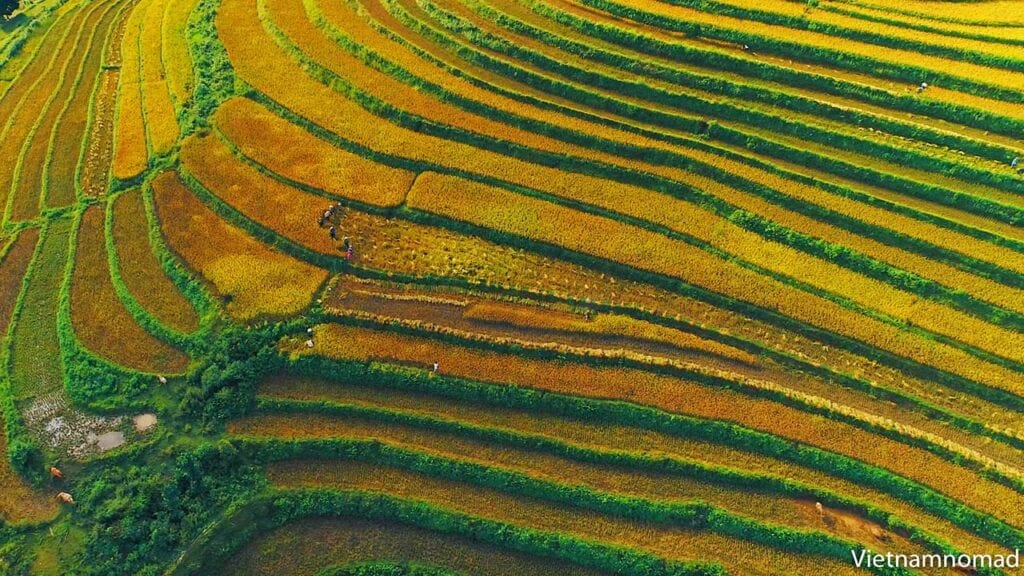
Sapa tourist map
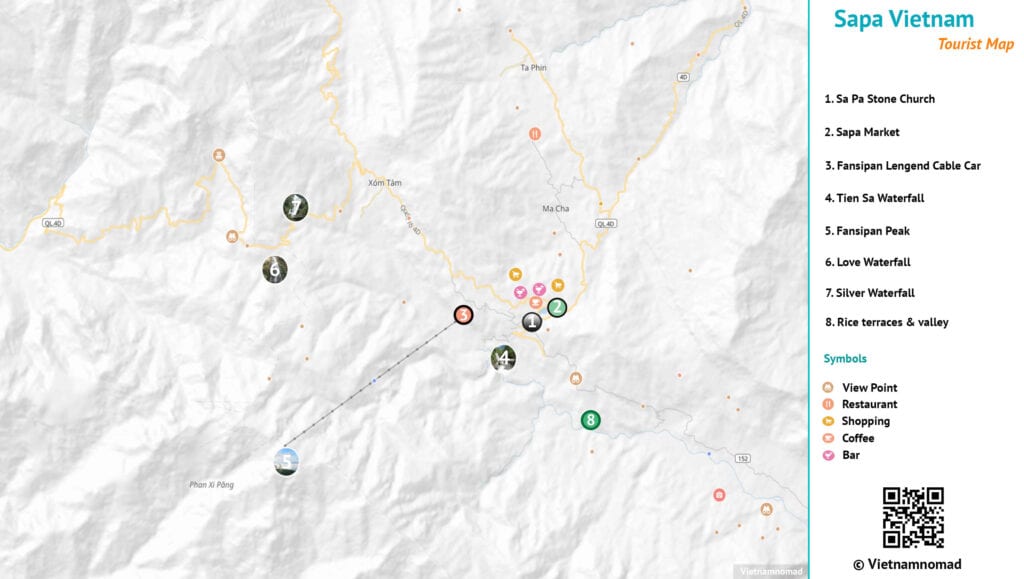
Sapa is a beautiful town with many attractive destinations. Still, the attractions here are far from each other and relatively difficult to travel, so we recommend a Sapa travel map, you can rely on it to find a suitable schedule.
How to get to Sapa
Discover transportation deals for Sapa from our partners >
As one of the best destinations in Vietnam, traveling to Sapa is extremely easy and has many different options, such as cars, limousines, and trains. We will guide you on how to go from Hanoi to Sapa in detail.
FROM HANOI TO SAPA
Currently, many bus companies run Hanoi to Sapa with very affordable fares, ranging from 180.000 – 200.000 VND/person/way, which have 2 times of travel: early in the morning from 6:30 am or late in the evening from 10 pm.
2. By Train
If you go to Sapa from Hanoi, you have to move to Tran Quy Cap station. Although the roads are convenient today, the train only stops at Lao Cai station; you have to take the bus to move up to Sapa. But going by train is also one of the exciting experiences that you must try once.
There are two options for you, one is the soft seat, the other and air-conditioned bed. The train starts at 9 or 10 pm and arrives early in the morning. The fare is around 200.000 – 600.000 VND/ passenger depending on the cabin class.
3. By Limousine
Besides the above choices, you also can go to Sapa from Hanoi by Limousine. It is an entirely new design with nine seats, ensuring comfort and convenience. Limousine prices are not too high, ranging from 300.000 to 600.000 VND/one depending on the company and seat class, travel time of 4 – 5 hours.
GETTING AROUND SAPA
To get around Sapa town, you have three options: rent a motorcycle and go by yourself, hire a motorbike driver, take a taxi.
1. Rent a motorcycle
With prices ranging from 120.000 to 180.000 VND/one, you can explore this land on your own. Remember, the above prices are applied in 1 day (from 6 am to 6 pm). Whether you rent morning or night, the same rate applies.
2. Hire a motorbike tour guide
For those traveling alone, hiring a motorbike driver is probably the best choice. Price range from 100.000 – 150.000 VND for 4-5 famous places near each other.
3. Take a Taxi
Besides the above options, you can also hire a taxi to move around Sapa town. However, ethnic minority villages are often located deep in small alleys. Therefore, you should consider this option, which will be quite expensive!
Where to stay in Sapa
As the leading tourist destination in Vietnam, there are many accommodation options in Sapa.
There are two areas with cheap accommodations in Sapa: Xuan Vien and Fansipan Street, the average price is from 200.000 VND – 400.000 VND/night for two people room. On weekends and public holidays, the price may be higher.
If you want to be in a quiet space, close to nature, you should stay at a homestay. When staying at a homestay, visitors also discover a lot of new and exciting things about the lifestyle and traditional culture of the people here.
Nowadays, there are some homestay villages such as Ban Ho, Lao Chai, Ta Phin, and Ta Van. If you are a little bit more condition, you can choose the villas or resorts with beautiful views and luxurious services.
Here are some recommendations for accommodation in Sapa, which are excerpted from the Vietnam travel guide book .
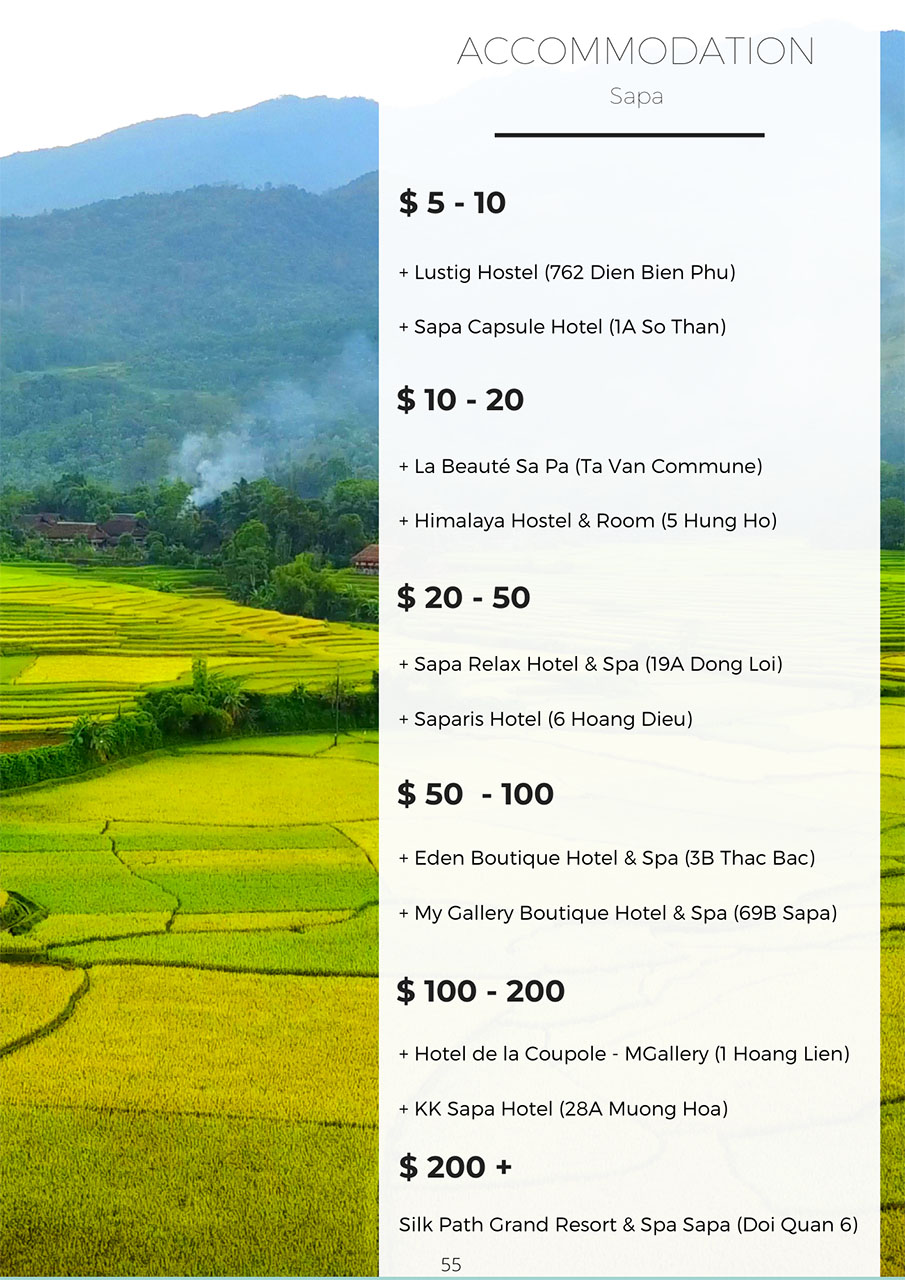
The most attractive destinations in Sapa
Sapa is famous for its many marvelous mountains and beautiful terraced fields. There are destinations you cannot miss when traveling to this town.
DESTINATIONS IN THE SAPA CENTER
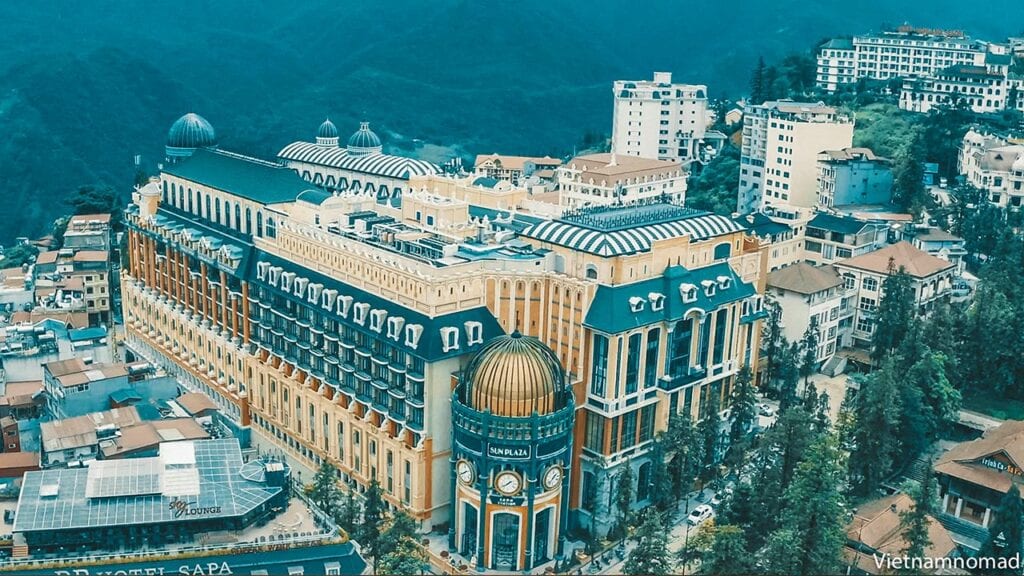
1. Sapa stone church
Built in 1895, it is considered as an ancient architectural imprint of the French left. The church has been renovated and preserved, becoming an indispensable place when mentioning the Sapa town.
2. Ham Rong Mountain
Standing on the top of Ham Rong Mountain, you can enjoy panoramic views of Sapa, Muong Hoa valley, Ta Phin hidden in the clouds. Visiting Ham Rong, tourists seem to be lost in the fairy garden with clouds and colorful flowers on the ground.
3. Cat Cat village
From the town center, following the way towards Fansipan mountain about 4km, visitors will come to Cat Cat village. This is the gathering place of H’mong ethnic people.
Owning a beautiful location right at the down of Hoang Lien Son mountain, Cat Cat is a lovely village with the simple and beautiful natural scenery of terraced rice fields and small stilt houses in Northwestern Vietnam.
Location: about 4km from the center of Sapa
4. Ta Van village
Follow 4D Highway to the Southeast, about 8 km from Sapa town to Ta Van Giay village. Coming here, visitors will have the opportunity to learn more about the lifestyle of the Giay’s ethnic. The road to Ta Van Giay village is small and narrow, both sides of the road are fertile terraced fields adorned with the green of corn and young rice.
Location: about 8 km from the center of Sapa
5. Sin Chai village
Sin Chai village, in San Sa Ho Ward, is a village that retains its untouched. This is a village of Black Hmong ethnic with a population of about 1.400 people. Besides planting rice and hybrid maize, Sin Chai villagers also grow cardamom that creates significant income for people in this ancient valley.
Location: about 5 km from the center of Sapa
6. Muong Hoa valley
The special thing in this valley is the ancient rock with many different shapes, interspersed between grasses and terraced fields of ethnic minorities. Hundreds of sandstones with engraved drawings and strange characters have not been identified yet, which has been recognized as a national heritage. In Muong Hoa valley, there is also a beautiful stream stretching about 15 km, passing through Lao Chai, Ta Van, Hau Thao communes, and ending at Ban Ho.
Location: Hau Hao Commune, 8 km to the South of Sapa
DESTINATIONS FAR FROM THE CENTER OF SAPA
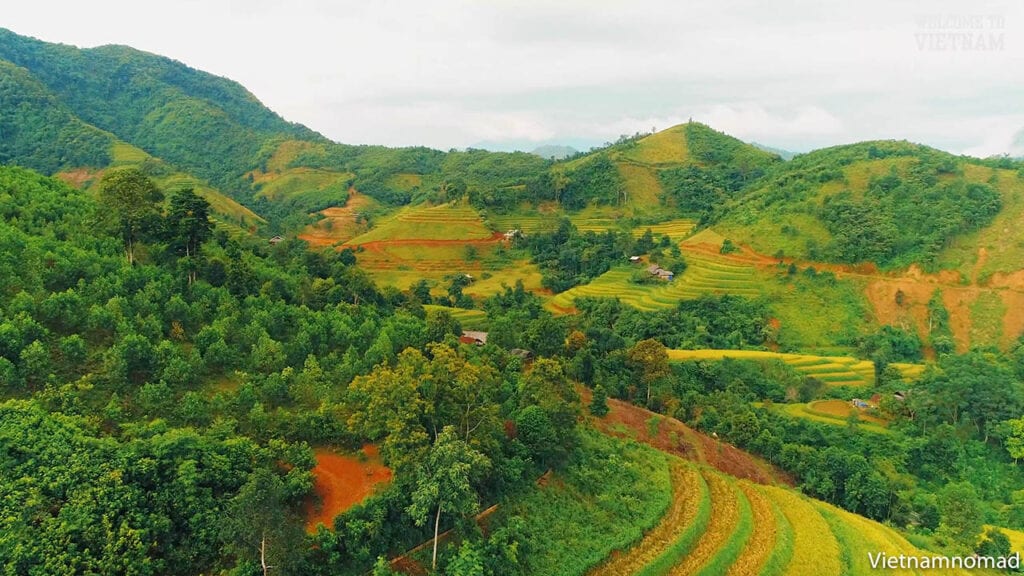
1. O Quy Ho mountain pass
Dubbed as one of the four high peaks of the Northwest Pass, O Quy Ho is a destination that any backpacker wants to conquer. O Quy Ho mountain pass with a length of more than 40km, is located at an altitude of over 2.000 meters, on 4D National Highway crossing Hoang Lien Son range. The top of the pass is between two provinces of Lai Chau and Lao Cai. The beauty of O Quy Ho Pass is always changing: Lao Cai province side is foggy while Lai Chau province side is sunny, which creates a beautiful landscape picture that attracts both domestic and foreign visitors.
Location: about 15 km from the center of Sapa
2. Silver Waterfall and Love Waterfall
From Sapa town, going to the West for about 11km on the way to Lai Chau Province, you will encounter rushing Silver Falls flowing down from an altitude of over 100m into a stream under the O Quy Ho valley, creating an impressive sound of mountains and forests. However, during the dry season, you should consider when visiting Silver Falls because then the waterfall has very little water. A further 3 km from Silver Falls is to Heaven Gate to look down on Lai Chau valley and the majestic Fansipan peak. If you like to walk, you can stop at Tram Ton and go through Hoang Lien National Park about 1 km more to explore Love Waterfall.
Location: about 11 km to the West of Sapa
3. Ta Phin village
This village owns a beautiful natural landscape along with the precious cultural traits of the Red Dao ethnic people. Coming to Ta Phin village, you can also visit the nearby Ta Phin cave. In this cave, there are many exciting stalactites shaped like fairy dancing, a party fairy sitting, distant fields, sparkling forests.
Location: about 15 km from the Sapa
4. Fansipan peak
The experience when visiting Sapa that you cannot miss is conquering Fansipan Peak – the highest mountain in Vietnam and Indochina Peninsula (3.143 m), located in the center of Hoang Lien Son mountain range. Currently, there are two options for you if you want to conquer Fansipan peak. First, you can go trekking Fansipan by following the tour of travel agencies or by yourself with the guidance of local people.
Secondly, you can also choose to go by cable car. Fansipan cable car route helped over ten thousand visitors who arrived at Fansipan Peak to admire, explore, and conquer the highest roof in Indochina. This is also the cable car with 2 Guinness records: the three-wire cable car with the most significant difference between the world’s departure and arrival station, about 141m and the longest three-cable cable car in the world, about 6292.5m. The time to travel to the Fansipan Peak is now shortened from 2 days to only 15 minutes.
Location: about 9 km to the Southwest of Sapa
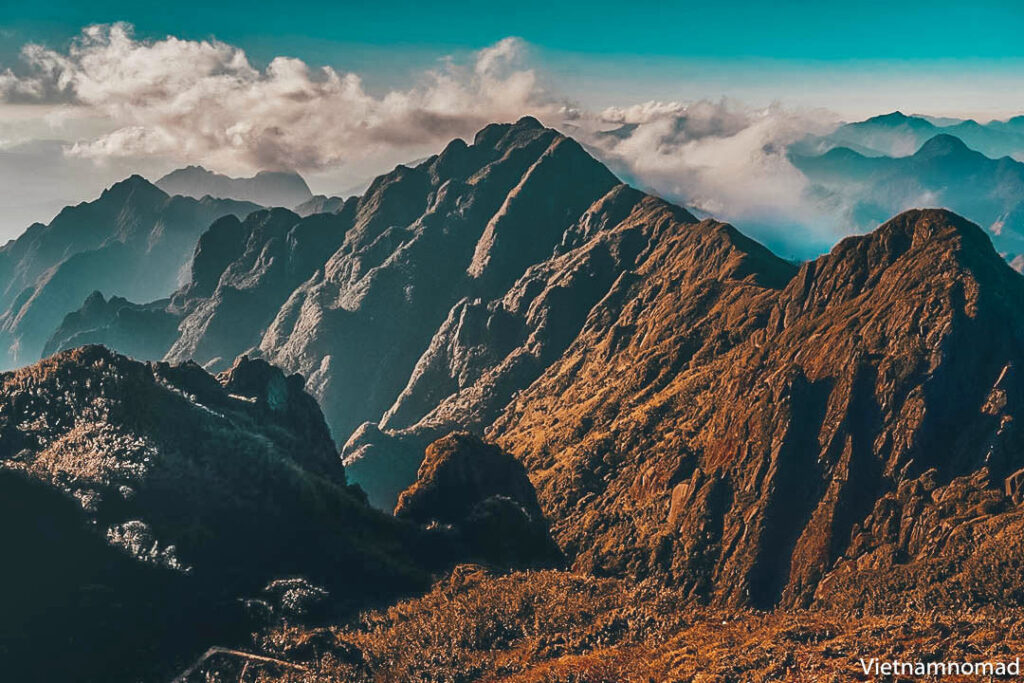
5. Tien Cave
Upstream of Chay River about 6 km, from the center of Bao Nhai commune (Bac Ha District), the boat will take you through the ancient city of Trung Do with many legends. Chay River constricted to create a deep, gentle stream, weaving between the two vertical cliffs. Tien Cave is a miniature Ha Long Bay, associated with the legend of Ba Co temple in Bao Nhai commune. Many tourists come here to enjoy the scenery, take a bath in the Tien stream, bask in the morning light on the flower island, pray for the beauty, health and wealth.
Location: 6km from the center of Bao Nhai commune, Bac Ha District
6. Coc San waterfall
Coc San is a system of waterfalls and caves with many various sizes. From 4D National Highway, there is a small dirt road about 1km long that is leading to Coc San. The way to Coc San is very twisted, dark, and filled with rocks. The beauty of Coc San is still completely natural and wild. Coc San landscape is harmonious and spacious. Everyone who comes here feels the miraculous mystery emanating from the waterfalls, rocks, and caves.
Location: Coc San, Bat Xat District, 7 km from Lao Cai Province
7. Hoang A Tuong Palace
Hoang A Tuong Palace, also known as the Northern Cat King Palace, is a tourist destination that many people choose when traveling to Sapa because of the majestic architecture after nearly 100 years of existence.
Hoang A Tuong Palace was built in a combination of Asian and European architecture, which was designed and constructed by French and Chinese architects.
Built in a closed rectangular layout on a total area of about 4.000 m2, the palace was both a workplace and living for the Hoang family. At the same time, there was a guard tower protruding on the four sides of the wall, no different from the fortresses in Europe. It can be said Hoang A Tuong Palace is a unique and majestic wonder in Bac Ha plateau and a destination you cannot ignore in Sapa.
Location: Bac Ha District
8. Bac Ha fair market
Bac Ha is the largest fair in the highland border area. The market meets on Sunday every week, attracting a large number of people around the region to trade and have fun. It is still a place to exchange and trade of ethnic minorities, mainly ethnic people from all surrounding villages. The stalls displayed all the essentials, such as clothes, shovels, and household items.
Top 7 must-try dishes in Sapa
Not only famous for its majestic natural scenery, but Sapa also has a unique cuisine, which is bold flavors of the Northwest mountains area. Here are the dishes you cannot ignore when coming to Sapa.
1. Bamboo-tube rice
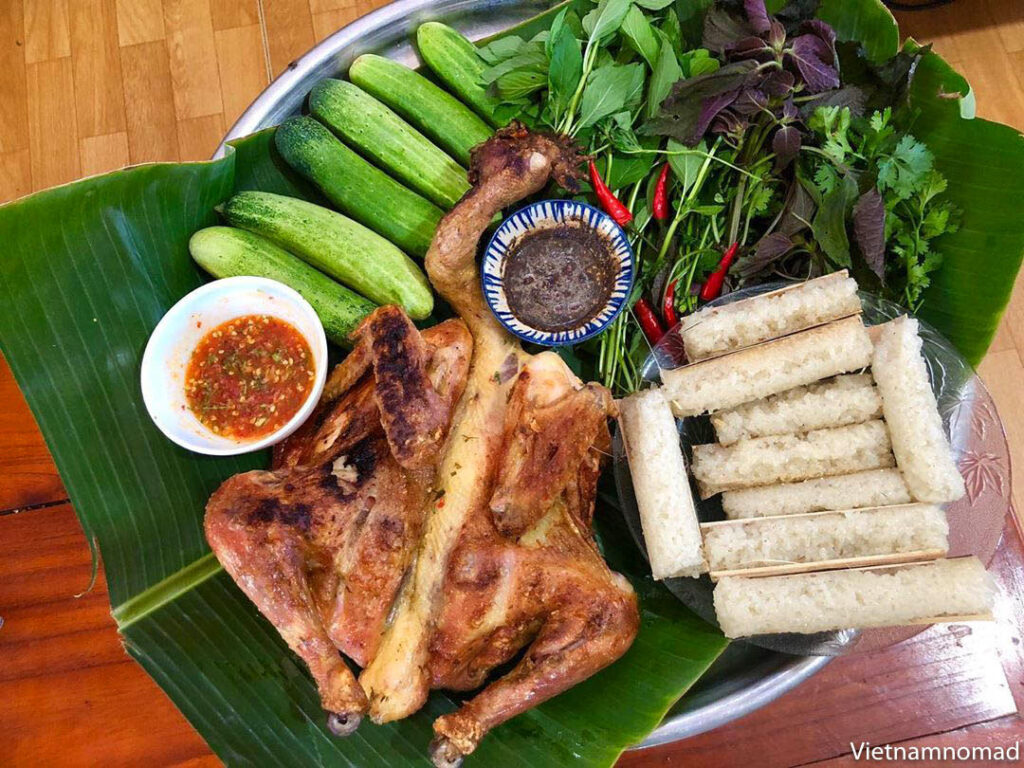
After grilling, splitting the burnt bamboo outside, leaving a thin layer of bamboo, and enjoy. Bamboo-tube rice (Com Lam) is popular and loved thanks to the richness of the sticky rice, and the soft fragrance of bamboo.
Address:
- Along Cau May Street
2. Barbecue
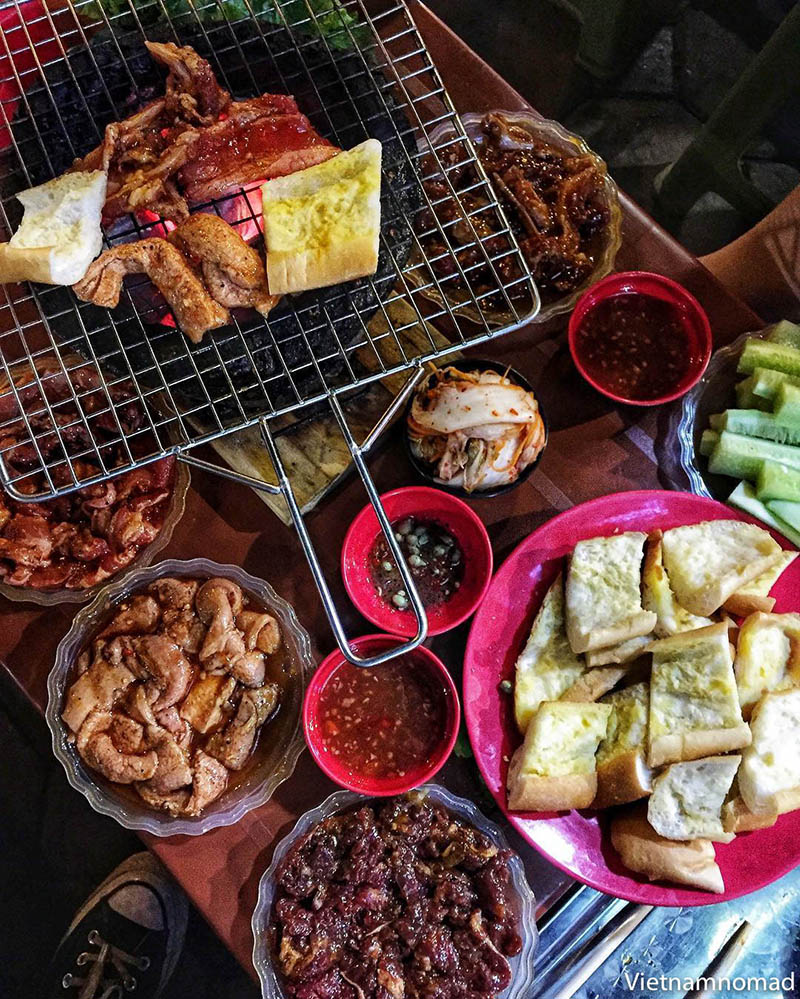
Referring to Sapa, you cannot help mention barbecue here. Sapa barbecue is diverse with pork skewers, whole pieces of bacon, chicken wings, quails, hearts, beef rolls with cats, and mushrooms. All you have to do is take a plate, choose the skewers you like, and wait for the owner to grill them on charcoal.
- Hoang Luc Xoi Restaurant – Ngu Chi Son Road
- Hoang Lien Restaurant – 4 Hoang Lien Road
- Mrs. Lich’s Restaurant – 1 Fansipan
3. Salmon hotpot

Coming to Sapa without enjoying the salmon hotpot, it is indeed deplorable. Unlike imported salmon, salmon in Sapa has a sweet taste, each piece of fish is firm, fresh, beautiful orange-pink color combined with sour bamboo shoots, pumpkin buds, and banana flowers create a delicious hotpot dish. In addition to hotpot, salmon can also be processed into grilled dishes, salads, curries. Besides, you can also try dishes made from sturgeon.
- Hoa Phuong Restaurant – Tier Union Street, group 7C, Ham Rong
- A Phu Restaurant – 15 Fansipan Street
- Hoa Dao – 48 Le Van Tam Street
- Thac Bac Restaurant – Thac Bac
4. Dried meat
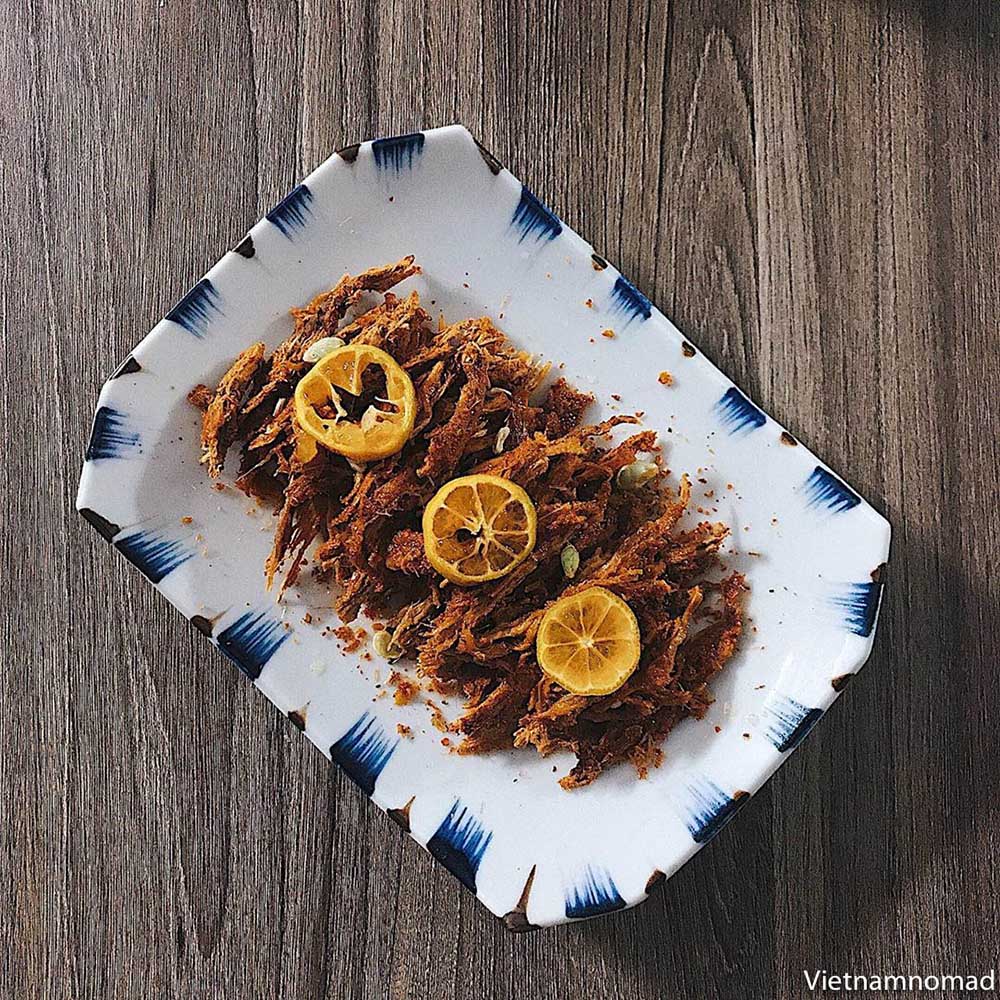
Meat of buffaloes, cows, horses, and pigs are usually hung on the kitchen floor by the Mong people for drying. Buffalos and cows are sliced along longitudinally into pieces of about 2 – 3kg threaded up and hung on the kitchen floor to serve as reserve food. These meats, when hanging up in the kitchen, will dry and leave for years. When eating, scrub the soot and dust, then fry it with tomatoes, bamboo shoots. The meat is fragrant and fleshy.
- Viet’s Farm – 26 Dong Loi Street
- Sapa Night Market – Dien Bien Phu Street
5. Lon Cap Nach

Lon Cap Nach is a specialty of Sapa. The name “ stolen armpit” stems from the local people carrying black armpits to seal at the markets. Pigs are left to roam freely and feed on the mountain slopes, so the meat is fragrant. The stolen armpit is very famous in Sapa and used for processing many special dishes. Its price is about 100.000 – 200.000 VND/kg. They are sold at markets in Sapa to serve tourists.
- Dung Trau Restaurant – 85 Street
- Gerbera Restaurant – 29 Cau May Street
6. Thang Co

Thang Co is one of the specialties of the Mong people, which is made mainly from horse organs. A pot of brakes consists of meat, heart, liver, heart, horse blood, and 12 spices: cardamom, cinnamon, lemongrass, ginger, and many other heirloom spices.
Thang Co often served with vegetables dipped in mustard greens, kohlrabi, and cabbage. Eating Thang Co must be accompanied by drinking warm, aromatic corn wine.
- Anh Quynh Restaurant, 15 Thach Son Street
7. Sapa Fish
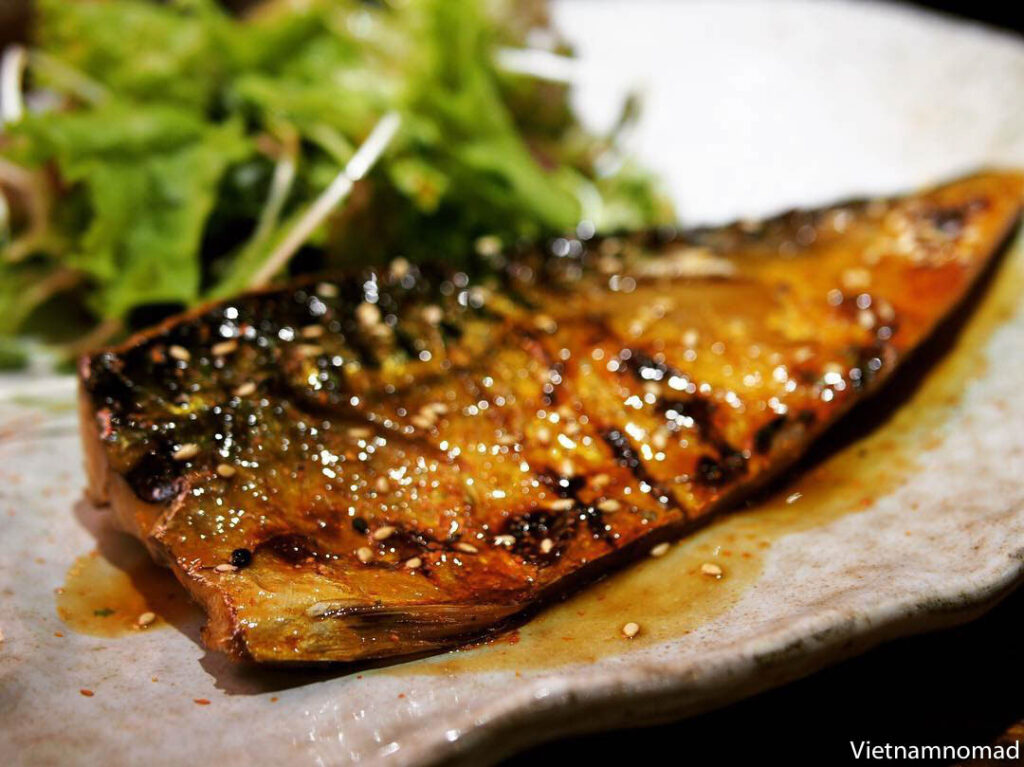
Sapa stream fish fried or grilled are also must-try dishes. Stream fishes are about 2-3 fingers long, often blue. Especially, Sapa stream fish has no fishy taste. The fish is fleshy, aromatic, and sweet, and the bones are crispy.
- Grilled stream fish restaurant – 15 Fansipan Street
- Delicious fish restaurant – 29 Cau May Street
- Chapa Restaurant – 40 Cau May Street
Festivals in Sapa
Sapa has six ethnic groups living together: Kinh, H’Mong, Red Dao, Tay, Giay, and Xa Pho. Each ethnic group has its unique cultural features, so it’s formed many unique traditional festivals in Sapa.
1. Roong Pooc Festival
Every year in January of the lunar calendar, the Giay people in Ta Van village organize Roong Pooc festival to pray for good harvest crops, favorable rain, and wind. Although still a traditional ethnic festival of the Giay people, in recent years, it has become a typical festival of the whole Muong Hoa valley. Besides the unique rituals, there are many games, dancing, and performing of gong drum and gong drum music in this festival.
2. Nao Cong Festival
Every year in June of the lunar calendar, Mong, Dao, and Giay people gather to worship at a temple in Ta Van village to celebrate Nao Cong. Each family appoints a representative, irrespective of male, female, old, and young. Nao Cong ceremony is held to pray for the blessing of the prosperous people, abundant crops. Also, during the festival, the leader will announce the typical conventions and end with a happy party.
3. Tet Dances Festival
Tet Dances is an important and well-prepared festival of the Dao Ta Van people, usually held on the 1st or 2nd of the Lunar New Year. The main content of the ceremony is to pray for the peaceful and prosperous people. The ritual activities during the Tet Holiday are very special.
4. Village sweeping ceremony of the Xa Pho
Every year, the Xa Pho people hold a sweeping village ceremony in February of the lunar calendar with the purpose of keeping people happy in the new year, good crops and healthy animals. During the sweeping village ceremony, each person contributes goats, pigs, chickens, and rice to make offerings to ghosts, worshiping masters. Villagers draw on their faces and dance to pray for peace. At the end of the ceremony, everyone enjoyed eating and drinking together. All food that is offered to the ghosts must not be brought into the village.
5. Gau Tao Festival of Mong people
The festival opens only for two purposes: to pray for a baby or to for health. One who does not have a child will make a ceremony to ask the fortune teller to open the Gau Tao festival to pray for him. Another who often got sick or have weak children, even had children died, crops, and animals gradually faded, he also asked a fortune teller to ask for the Gau Tao festival. The festival is also usually held at the beginning of the year.
6. Xuong Dong Festival of Sapa
The festival in the early spring of the Tay and Dao people in Ban Ho commune (Sapa) opens on the morning of the 8th day of Tet every year. The ceremony starts with soil and water procession, and then the worshiping ceremony with spirits. The festival starts with the unique dances and folk performances of the Tay and the Dao.
But the most outstanding, the funniest part is the show when the trumpet sound rang for the Tay girls to start the show with graceful biting moves. When the show ends, everyone goes to the game area. The games here are mostly folk games such as throwing longer, pushing sticks, spinning, hitting balls, blindfold, and catching.
7. Sapa Love market
Sapa Love Market takes place regularly every Saturday night with many special activities. Love Market is a dating place, expressing the feeling of lovers.
At Sa Pa love market, young men and women in villages in the Northwestern region will come here to meet, talk, and participate in many extremely bustling activities such as blowing aloes, singing love songs, etc. After this night market, many couples have become closer; even some of them become husband and wife. Coming to Sapa on the weekend, visitors should not miss this unique love market!
Above are the detailed Sapa travel guide. Hopefully, with this guide, you will have a memorable trip to this beautiful town!
Related Articles
Mui ne, phan thiet, ha long bay.

Best Things to Do in Sapa, Vietnam – Top Activities and Places to Visit
Posted on February 23, 2024 | Julie J. |
Last Updated on February 23, 2024
Planning a trip to Vietnam and want to add Sa Pa to your itinerary? After having explored Vietnam from South to North, I can tell you that Sapa is one of the best destinations in Vietnam . In this travel guide, I share all the best things to do in Sapa as well as useful tips to make the most out of your trip.
Sapa, Vietnam is a charming mountain town located in Northern Vietnam . Known for its breathtaking scenery, rich cultural heritage, and outdoor activities, Sapa is a must-visit destination for anyone traveling to Vietnam.
Whether you’re looking for a relaxing getaway or an adventurous outdoor experience, Sapa has something to offer everyone.
If you’re looking for the absolute best things to do in Sapa , I recommend taking the cable car to the top of Fusipan Mountain, exploring Cat Cat Village, and doing a guided hike through the rice paddies and local villages. Also, staying at a homestay is a must!
One of the most popular activities to do in Sapa is trekking through the Muong Hoa Valley to villages. With its stunning rice terraces, lush forests, and scenic mountain trails, Sapa is a hiker’s paradise. You can choose from a variety of trekking routes, ranging from easy walks to multi-day hikes, depending on your fitness level and interests.
Along the way, you’ll have the opportunity to meet local ethnic minority groups, learn about their traditional customs and way of life, and enjoy some of the most spectacular views in Vietnam.
In addition to trekking, there are many other things to do in Sapa, such as visiting local markets, exploring ancient rock formations, and admiring stunning waterfalls. Whether you’re interested in history, culture, or nature, Sapa has something to offer everyone.
So pack your bags, put on your hiking boots, and get ready to experience the beauty and charm of Sapa, Vietnam.
Planning your Trip to Sapa
The most important thing to consider when deciding whether visiting Sapa is worth it or not is the time of year. The best time is when the rice paddies are green, around August and September – outside of this time the landscape is way less spectacular.
I visited when the fields were just mud, so it looked nothing like the pictures you see. I still enjoyed my trip because of the cultural aspect. I did a homestay and a bit of hiking – and, it was nice to discover the local way of life, shop for handicrafts, and visit the villages.
However, you might be disappointed by the landscape, so keep that in mind.
You should also know that while Sapa is beautiful and culturally rich, it’s also a very rural and very poor part of Vietnam where you might witness some difficult stuff. I personally wouldn’t recommend staying in Sapa Town, I got a pretty off-vibe there, and prepare yourself if you’re not used to traveling to this type of place.

Weather and Climate
The best time to visit Sapa is during the dry season, which runs from September to November. During this time, the weather is relatively stable with sunny days and cool nights, making it perfect for trekking and exploring the rice terraces.
In contrast, January is one of the coldest months in Sapa, with fog often hanging over the valley, partially or entirely blocking Sapa’s famous views. Rice doesn’t grow in Sapa in January, so it’s best to avoid this month if you want to see the lush green rice terraces.
Getting to Sapa
One of the most popular ways to get to Sapa is by train. You can take an overnight train from Hanoi to Lao Cai, which is the nearest city to Sapa. From Lao Cai, you can take a bus or taxi to Sapa. The train journey takes around 8-9 hours and is a great way to see the countryside.
Another option is to take a bus from Hanoi to Sapa. The journey takes around 5-6 hours and is a more affordable option than the train. Several bus companies operate this route, and you can book your tickets in advance online or at a travel agency in Hanoi.
If you prefer to drive, you can rent a car or hire a private driver to take you from Hanoi to Sapa. This is the most expensive option, but it allows you to travel at your own pace and stop whenever you want. The journey takes around 5-6 hours and takes you through some stunning scenery.
You can also book a 2 to 3-day trip from Hanoi that includes transportation, a hiking guide, and a homestay, like this Sapa 2 Days 1 Night From Hanoi – Overnight in Ta Van Village.
Transportation Within Sapa
Getting around Sapa is fairly easy, with a variety of transportation options available. Taxis are readily available and can be hailed on the street or booked through a ride-hailing app. Alternatively, you can rent a motorbike or bicycle to explore the area at your own pace. Buses are also available for longer journeys to nearby towns.
Language and Communication
While English is not widely spoken in Sapa, many locals do have a basic understanding of the language. It’s a good idea to bring a phrasebook or download a translation app to help with communication. Alternatively, you can join a guided tour to ensure that language barriers are not an issue.
Cultural Events
If you’re interested in experiencing the local culture, plan your trip around the rice harvesting season, which typically takes place from August to October. During this time, you can witness the locals harvesting the rice terraces, which is a fascinating experience.
You can also attend the Love Market, which is held on Saturday nights in Sapa town. This is a traditional event where young people from different ethnic groups come together to find a partner.
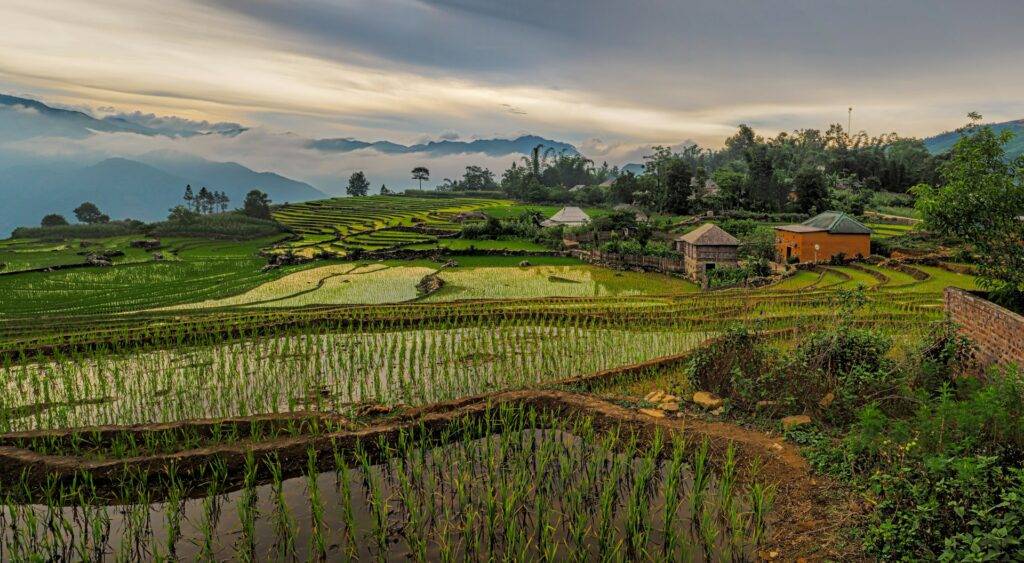
Where to Stay
If you are looking for an authentic experience, I recommend staying in a homestay in one of the nearby villages.
Sapa is home to many ethnic minorities, and staying with a local family is a unique opportunity to learn about their culture and way of life.
Ta Phin Village is a popular spot for homestays, they typically include meals and some activities, such as trekking or handicraft workshops. You’ll find many on Booking or Facebook.
Mama Chao Homestay comes highly recommended and is a truly authentic homestay.
If you need more comfort, Sapa Town has a wide range of hotels to choose from, ranging from budget to luxury.
For a unique experience, consider staying at the Hôtel de la Coupole – MGallery by Sofitel , which features a stunning design inspired by the region’s hill tribes.
The BB Sapa Resort and Spa is another popular choice, offering a range of amenities including a heated indoor pool and a spa.
If you are traveling on a budget, there are several hostels in Sapa Town that offer affordable accommodation. Go Sapa Hostel and Sapa Backpacker Hostel are both great options with excellent ratings.
Best Things to Do in Sapa
Ride the cable car to fansipan peak.
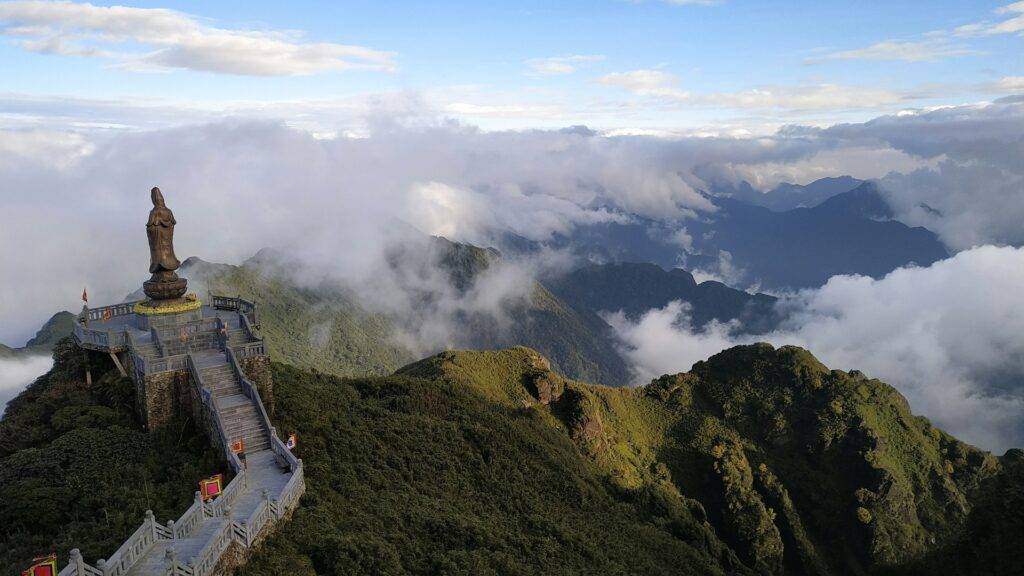
For stunning views, a trip to the top of Mount Fansipan is a must. On a clear day, take the cable car to the summit and enjoy the breathtaking scenery.
A roundtrip ticket costs VND 800,000 and it takes about 15 minutes to reach the top. From there, you can climb up the 600+ steps to the peak or take the funicular for VND 70,000 (one way).
I wouldn’t recommend going if the weather is cloudy as you won’t see much then.
If you’re feeling adventurous, you can also hike to the top. As the highest peak in Indochina, the climb may be challenging, but the views from the top are worth it. It usually takes 2 days back and forth and it’s recommended to hire a guide or book a tour .
Ride a Bike Through the Muong Hoa Valley
The lush greenery of the Muong Hoa Valley is a sight to behold. You can take a bike ride through the valley to see the rice terraces and local villages up close. The valley is also home to Sapa Lake, a serene spot for a picnic or a leisurely stroll.
You can also go hiking through the valley with a local guide for a different experience or book an easy rider tour.
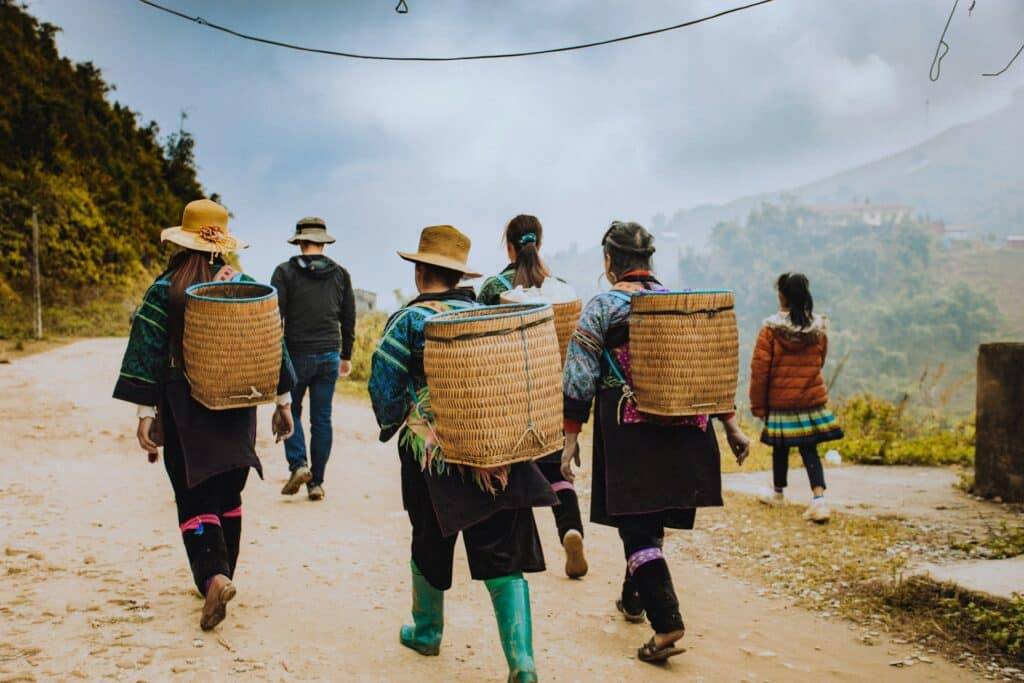
Visit Local Villages
One of the highlights of Sapa is the opportunity to visit local villages and interact with the ethnic minority groups that call the area home.
Cat Cat Village, Ta Phin Village, Tan Van Village, Y Linh Ho Village, and Lao Chai Village are just a few of the villages you can visit to learn about the unique cultures and traditions of the people who live there.
You can visit on your own, either hiking or by renting a bike, but I really recommend going with a local guide. If you’re staying at a homestay, it’s usually included, otherwise, this tour is a great option.
Explore the Markets
Sapa is home to many local markets , where you can find a variety of goods and experience the bustling atmosphere. The main one is located in Sapa Town and operates daily. There you can shop for fresh produce and handicrafts, and grab a bite to eat.
One of the most famous markets is Bac Ha Market, which takes place every Sunday. Here you can find everything from colorful textiles to fresh produce and livestock. It’s a 3-4 hour drive from Sapa but it’s well worth the drive. Your best option is to book a day trip from Sapa or take a tour from Hanoi that includes Sapa and the market, like this 3-day trip.
Another popular market is Can Cau Market, which takes place every Saturday and is known for its beautiful handicrafts. It’s also a bit far from Sapa but you can try adding it to your itinerary.
Learn About Local Handicrafts and Art
The ethnic minority groups in Sapa are known for their beautiful handicrafts. You can find everything from intricately embroidered clothing to handmade silver jewelry.
One popular activity is visiting a local village and learning about the traditional methods of indigo dyeing or taking a H’mong sewing class. Book this Hmong Batik Indigo Embroidery Workshop for a great cultural immersion.
You can also visit the Ta Phin Commune to see the locals singing in their traditional church.
You can also stop by the small Sapa Museum to see a display of traditional items.
Learn About the Ethnic Minority Culture
Sapa is home to many ethnic minority groups, including the Hmong, Dao, Tay, and Nung Dinh people. You can learn about their unique cultures by visiting their villages and participating in their daily activities.
For example, you can learn about the Hmong’s traditional way of life by trekking to their villages and staying in a homestay. You can also visit the Dao’s herbal bathhouses or the Tay’s traditional stilt houses.
Most homestays will arrange everything you need (transportation, food, hiking guide, cultural experiences…). If you like to plan ahead, you can book this experience (with nothing but stellar reviews!).
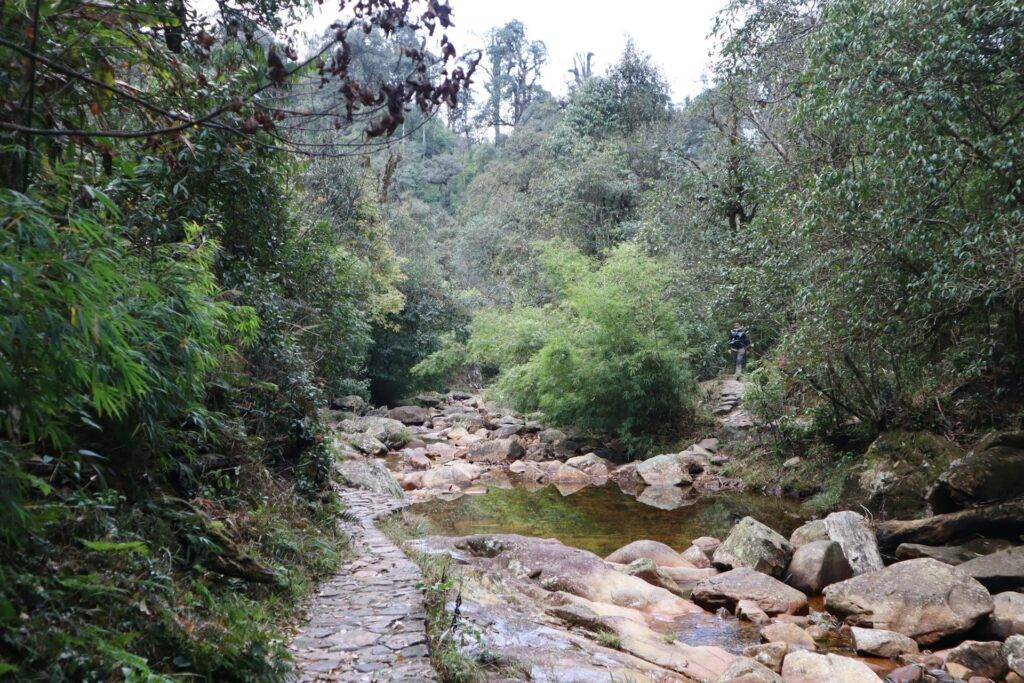
Sa Pa is known for its incredible trekking routes, and there are options for all levels of experience. One popular trek is the hike to Cat Cat Village, which takes you through rice terraces and Hmong villages. You can keep going past the village to Lao Chai, Ta Van, and Giang Ta Chai.
Another popular hike is the one to Love Waterfall, in San Sa Ho Commune, about 15 km west of Sapa town.
From the ticketing booth, it’s a 30-minute hike on a paved path through lush rainforest and open plains.
You’ll need to rent a bike or arrange for transportation. It should cost around VND 250,000 to be taken to Love Waterfall and the nearby Silver Waterfall (which you should also visit!) by motorbike.
You can also book a tour that will take you to Love Waterfall, Heaven Gate and San Sa Ho.
If you’re new to trekking or want to explore Sa Pa with a guide, there are plenty of guided tours available as well. These tours can take you to some of the most beautiful spots in Sapa, including waterfalls and hidden villages. Some tours also offer camping options for a more immersive experience.
For a truly unique experience, consider a multi-day trek. These treks take you to remote villages and areas that are less frequently visited by tourists. You’ll have the opportunity to see a side of Sapa that many visitors never get to experience. Keep in mind that these treks can be challenging and require a higher level of fitness.
Take a Herbal Bath
If you’re looking for something more unique, consider trying a Red Dao herbal bath. This traditional bath involves soaking in a tub filled with water and a blend of herbs, including lemongrass and ginger, which are known for their healing properties.
The bath is said to help with muscle aches, improve circulation, and promote relaxation.
There are several places in Sapa where you can experience a Red Dao herbal bath, including the Red Dao Spa in Ta Phin. A good idea is to hike there, relax at the spa, and take a taxi back to your accommodation.
See Flowers Along the Ham Rong Mountain
Located right next to Sapa Town center, the Ham Rong Mountain, or Dragon Head Moutain because of the shape of its peak, is a must-see while in Sapa.
The road to the top starts behind Sapa Church. It will take you around 2 hours to reach the top and back, from which you’ll get stunning views over the town and Fansipan Mountain. On the way, you can stop at the Ham Rong Flower Garden (only 30 minutes from the church).
Most of the way is paved and signposted. There’s a small entrance fee to pay at the start of the trail.
Food and Dining
When it comes to food and dining in Sapa, you’re in for a treat. The town is known for its delicious local cuisine, street food, and charming cafes and restaurants. Here are some of the best places to eat and drink in Sapa.
Local Dishes to Try
Sapa is famous for its local cuisine, which features a variety of delicious dishes. Some of the must-try dishes include Thang Co (stewed horse meat and organs), Com Lam (bamboo sticky rice), and Cap Nach Pork (a special breed of pig raised by the locals). You can also try Xoi Bay Mau (sticky rice with black beans) and Thit Trau Gac Bep (smoked buffalo meat).
Street Food
If you’re looking for a quick and tasty bite, Sapa’s street food scene won’t disappoint. Head to Sapa Food Court to sample a variety of dishes from different vendors. You can try Banh Mi (Vietnamese sandwich), Pho (noodle soup), and Bun Cha (grilled pork with vermicelli noodles). Don’t forget to try the local specialty, Salmon Sour Hot Pot.
Cafes and Restaurants
Sapa is home to some charming cafes and restaurants, offering a cozy atmosphere and delicious food. Gem Valley Coffee is a popular spot, offering stunning views of the valley and a great selection of coffee and snacks.
You can also try A Phủ Restaurant for a fine dining experience, or take a cooking class at one of the cafes to learn how to make local dishes yourself.
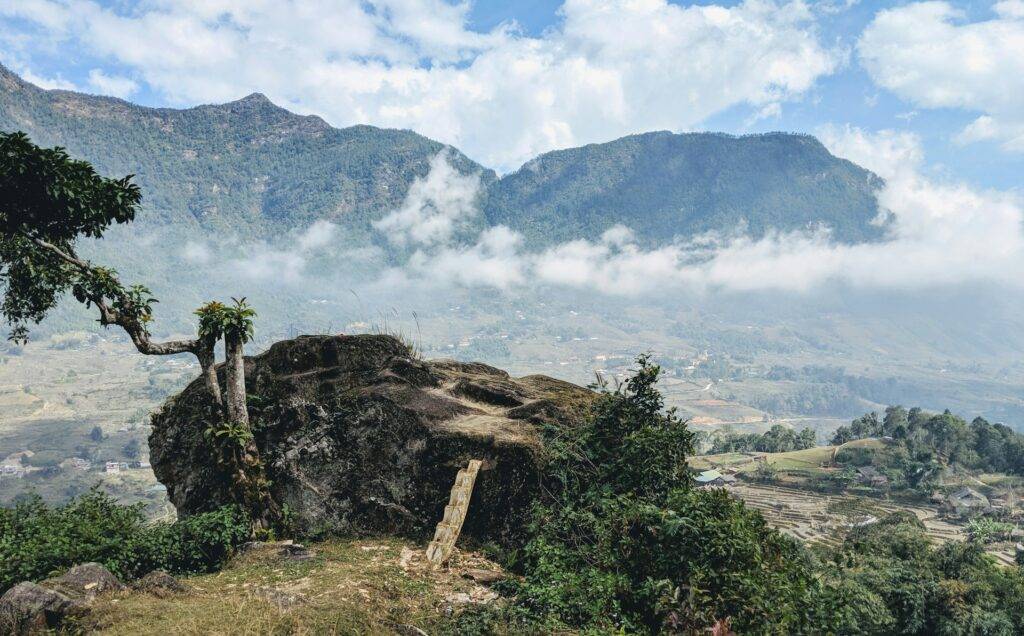
Itinerary Suggestions
One-day trip.
If you only have one day in Sapa, you can still see some of the highlights of the area. Start your day with a visit to the Sapa Market, where you can see the local ethnic minorities selling their wares.
After that, head to Cat Cat Village, which is just a short walk from the town center. Here, you can see traditional Hmong houses and learn about their culture and way of life.
Finish your day with a trek to the nearby Silver Waterfall, which offers stunning views of the surrounding countryside.
Multi-Day Excursions
If you have more time to spend in Sapa, there are plenty of multi-day excursions to choose from.
One popular option is to take a trek to the top of Fansipan, the highest mountain in Indochina. This trek can take anywhere from two to four days, depending on your fitness level and how much time you have.
Another option is to take a tour of the nearby villages, such as Ta Phin or Lao Chai. Here, you can learn about the different ethnic groups that live in the area and see their traditional way of life.
Save it on Pinterest for later:
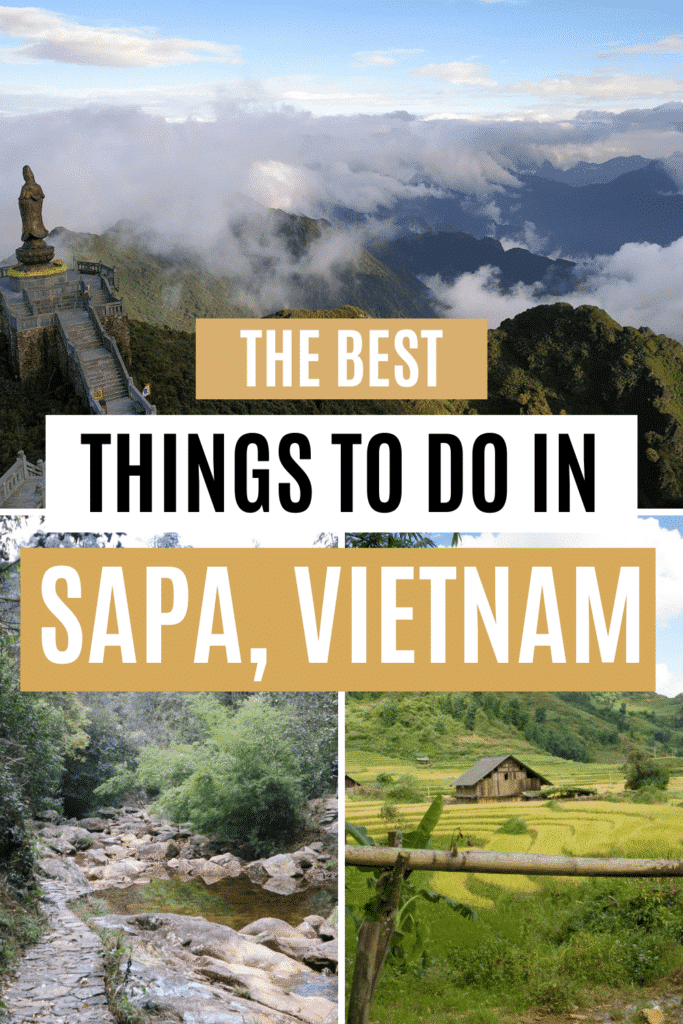
Related posts:

- Search for:
- Login / Register
- Small Group Tours
- Private Tours
- Hanoi Tours
- Hai Phong Tours
- Halong Bay Tours
- Ninh Binh Tours
- Mai Chau Tours
- Moc Chau Tours
- Thanh Hoa Tours
- Cua Lo Tours
- Quang Binh Tours
- Hoi An Tours
- Da Nang Tours
- Da Lat Tours
- Nha Trang Tours
- Saigon – Ho Chi Minh City Tours
- Mekong Delta Tours
- Vung Tau Tours
- Phu Quoc Island Tours
- China Tours
- Indochina Tours
- Cambodia Tours
- Thailand Tours
- Myanmar Tours
- Malaysia Tours
- Indonesia Tours
- Tailor Made Tour
- 5 Star Cruises
- 4 Star Cruises
- 3 Star Cruises
- Day Cruises
- Overnight Cruises
- Catholic Pilgrimage
- Our services
- Why travel with us?
- Travel Blog
Northern Vietnam Travel Guides , Sapa Travel Guides , Travel Guides , Vietnam Travel Guides
Sapa travel guide – everything you need to know.
As a popular tourist destination in Vietnam, Sapa stands at the head of a deep valley of magnificent rice terraces that are still farmed today as they have been for centuries. By staying in Sapa homestays and embarking on an exciting Sapa trekking trip through the surrounding mountains and rice terraces, visitors can fully experience the local way of life and the gorgeous natural beauty of Sapa. If you’re thinking of visiting this enchanting highland region, let’s discover the Sapa Travel Guide below, brought to you by Asia Legend Travel !
Sapa Travel Guide: Overview of Sapa
Located in the Northwest region of Vietnam, Sapa is a district-level town in Lao Cai Province, covering an area of 677 km2 and home to over 60,000 inhabitants. It sits at an elevation of about 1,500 meters and is 380 kilometers northwest of Hanoi, near the border with China.

The town is dominated by the Hoang Lien Son mountain range, home to a wide variety of natural creatures, many of which are found only in Northwest Vietnam. To preserve the area’s unique biodiversity, the Hoang Lien Nature Reserve was made a National Park in 2006, covering much of the mountain range south of Sapa. This range also includes Fan Si Pan, the highest mountain in Vietnam, standing at 3,143 meters above sea level.
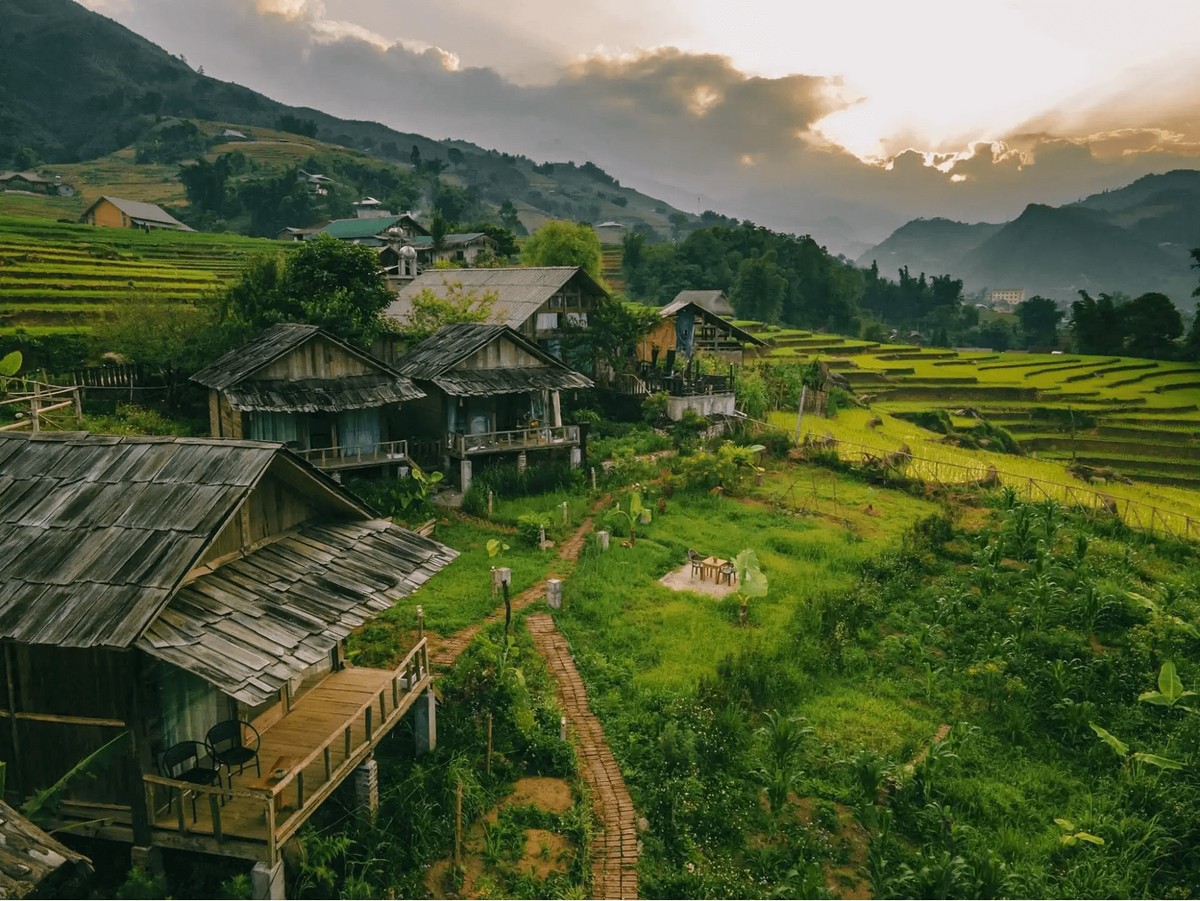
Aside from its breathtaking scenery, Sapa is famous for its fascinating cultural blend. The hillside villages are home to several ethnic minorities, including Hmong, Red Dao, Tay, Giay, and Xa Pho, each with unique cultures and customs. The stunning scenery and cultural immersion makes it a must-visit destination for anyone traveling to Vietnam.
Sapa Travel Guide: Must-Visit Destinations
Below is a list of captivating tourist attractions in Sapa that visitors should not miss. Let’s explore them in the Sapa Travel Guide right away!
Cat Cat Village
Located near Sapa Town, Cat Cat Village is a beautiful small rural village of H’mong residents. From the moment you arrive, you will be captivated by the breathtaking views of the surrounding mountains and lush green landscapes. But that’s not all; the village also mesmerizes visitors with its vibrant culture.

Sapa Culture Museum
Established and put into operation in 2007, Sapa Culture Museum is an ideal destination for culture enthusiasts. Visitors will have the opportunity to learn about the rich history of Sapa and explore the customs, beliefs, and lifestyles of each local ethnic group.
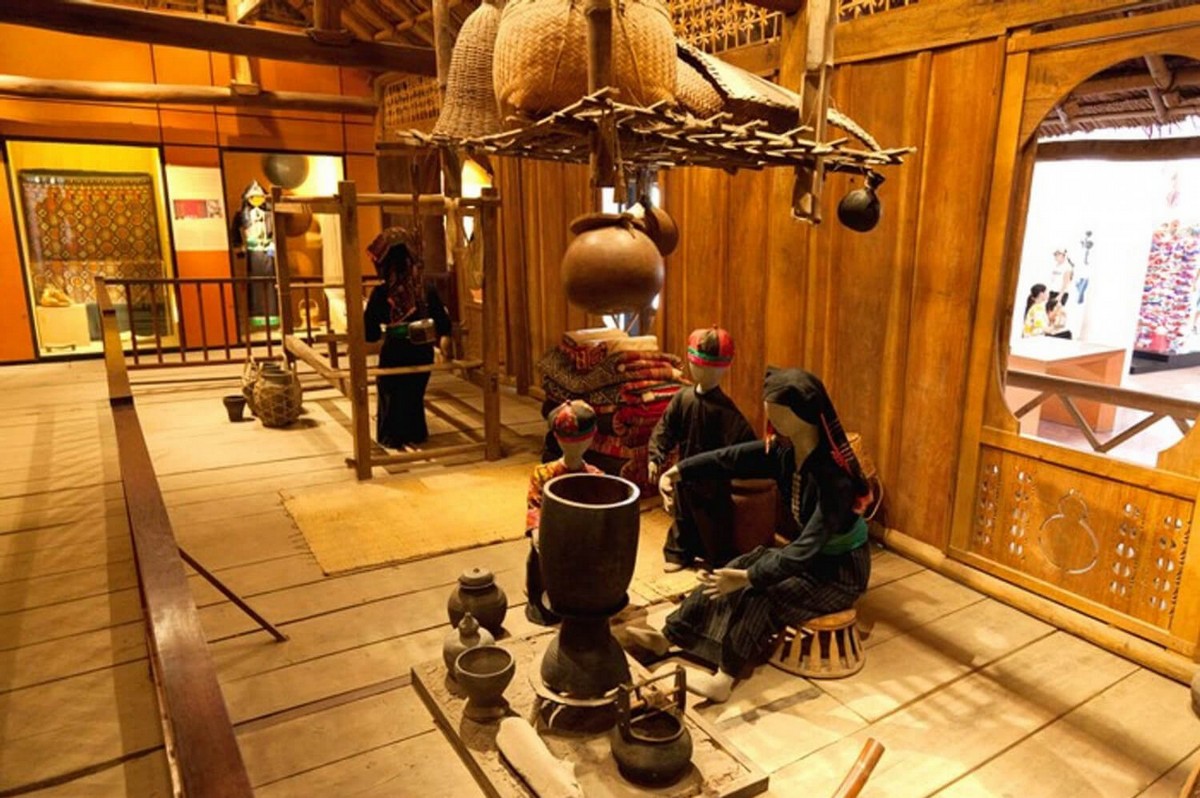
Fansipan , the highest peak in Vietnam, is a famous tourist destination for Vietnamese and international tourists. When tourists conquer the Fansipan Peak, they can admire the beautiful natural scenery and the magnificent clouds on the Hoang Lien Son range, making for an incredible experience.
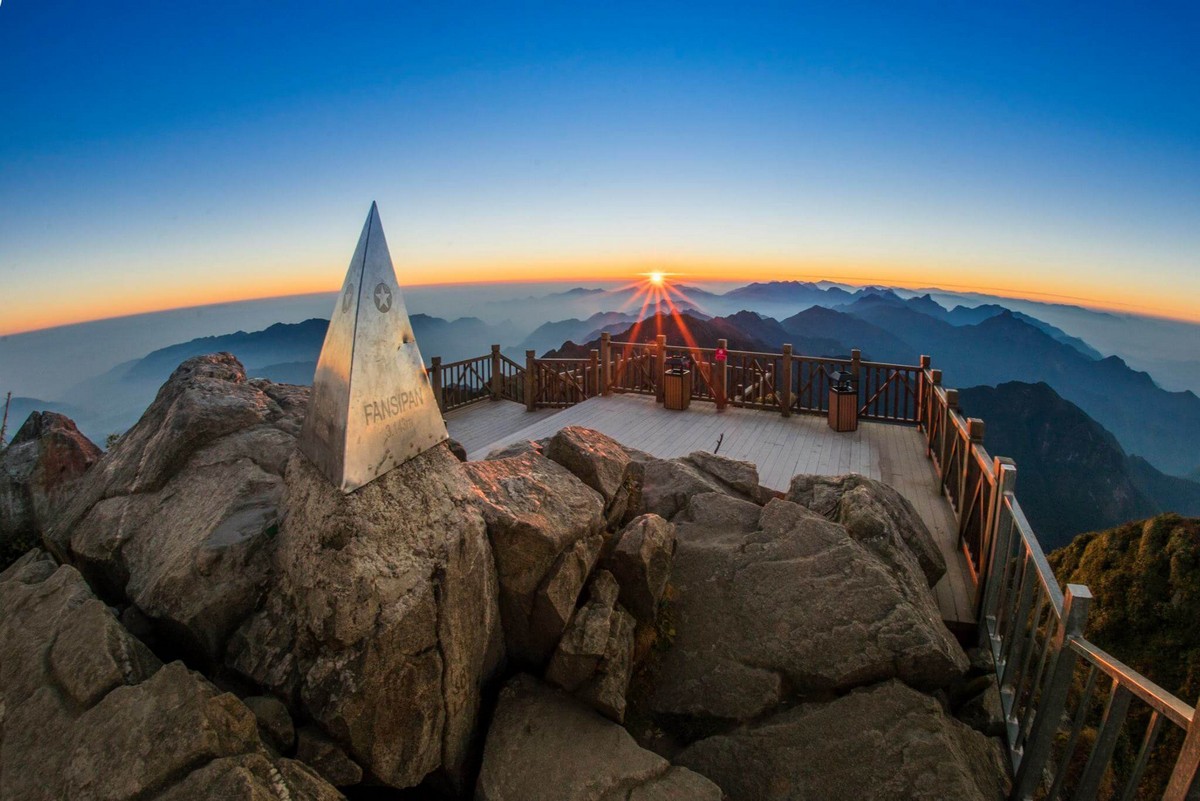
Sapa Market
Sapa Market is one of the most fascinating spots where visitors can explore and purchase various items such as Sapa delicacies, small souvenirs, beautiful traditional woven fabric, or handmade handicrafts made by locals. Furthermore, the weekend music exchange program is an excellent way to experience and appreciate the cultural uniqueness of the highland region.
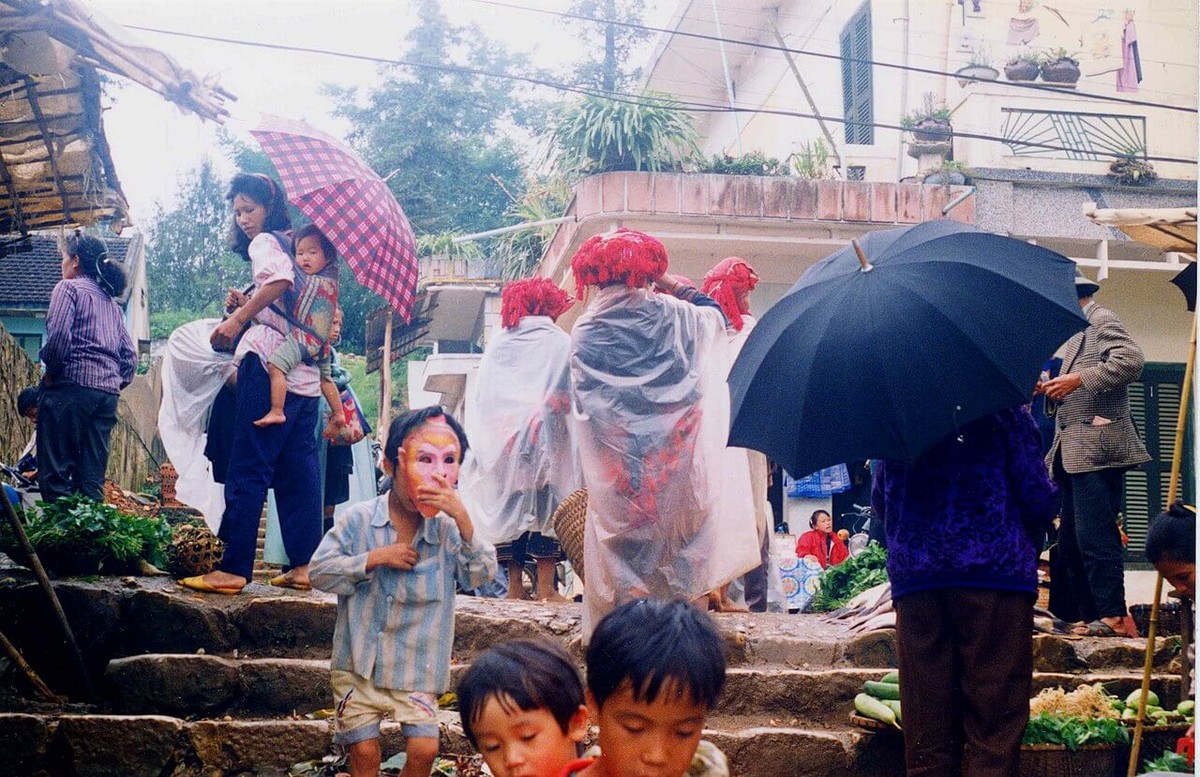
Heaven’s Gate
Heaven’s Gate Sapa has always been the go-to destination for tourists seeking to capture the perfect cloud-hunting moment and virtual photo-taking experience. The scenery here is simply mesmerizing, with mountains and clouds blending to form a picturesque landscape that no painter could depict.
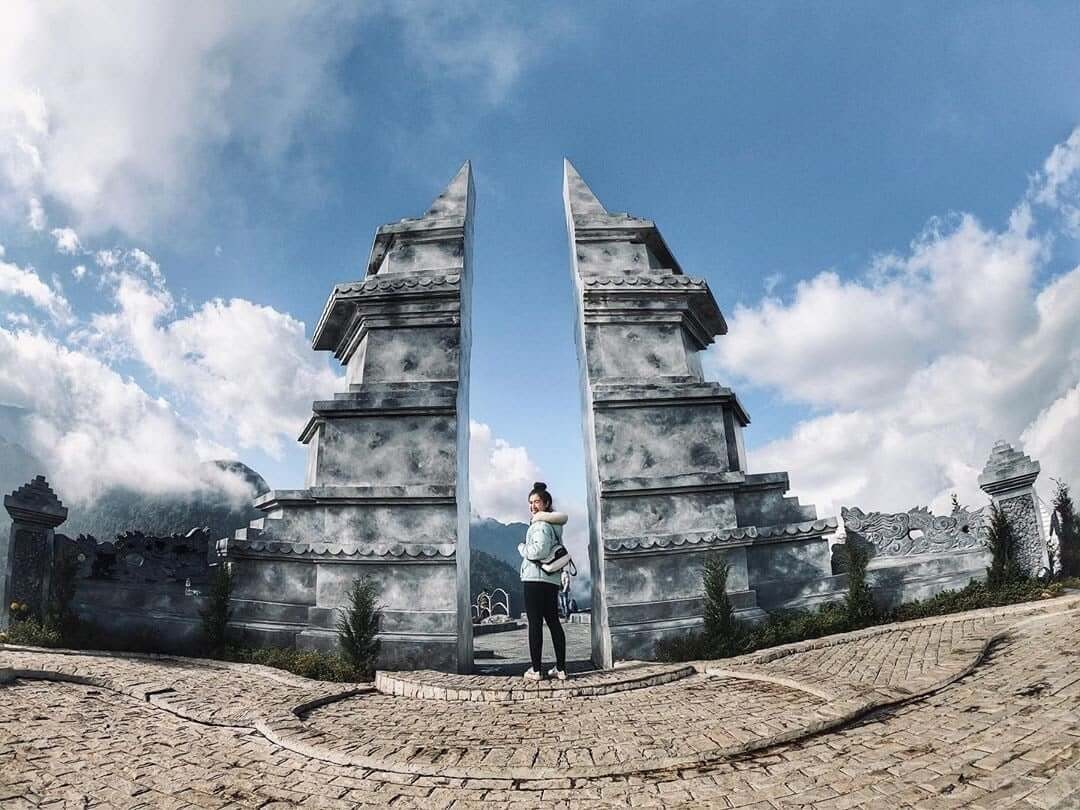
Ham Rong Mountain
Located right behind the Sapa Church, Ham Rong Mountain has a shape like a dragon holding its head up towards the sky. Along with the fascinating attached legend, the mountain is a fascinating spot that attracts millions of visitors each year.
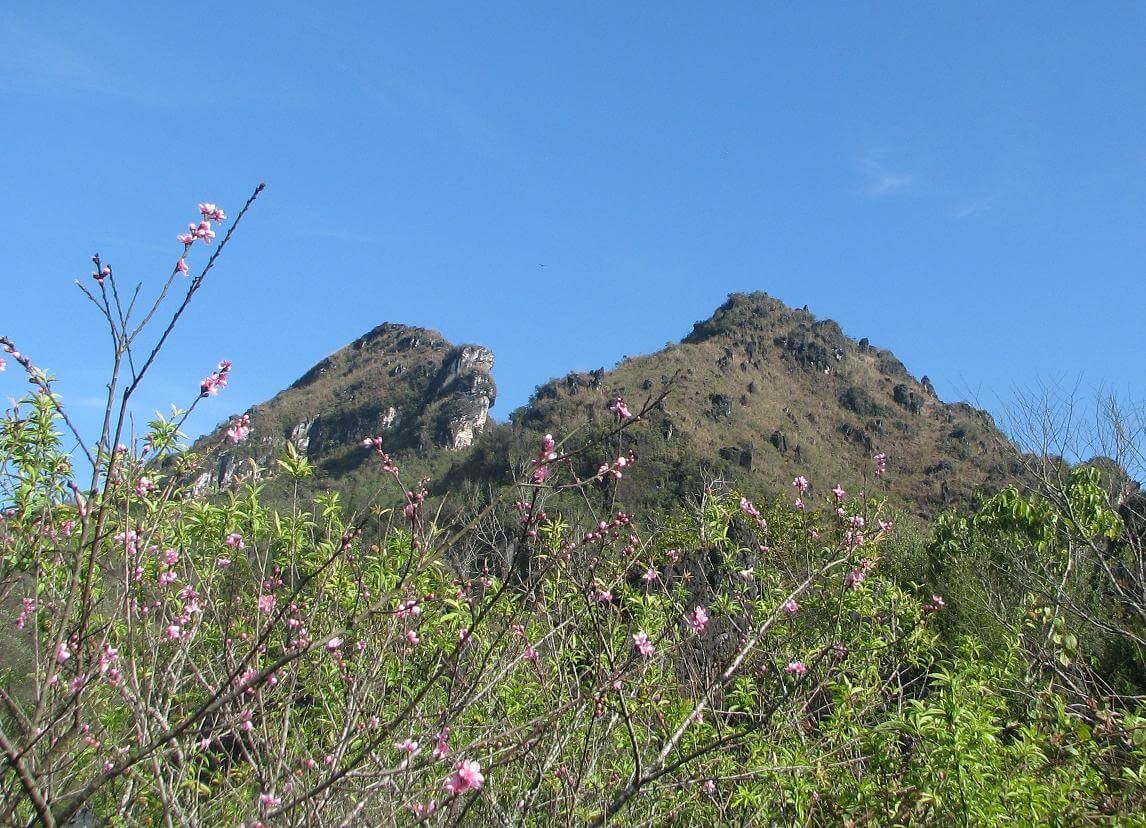
Sapa Travel Guide: Must-Try Local Food
When visiting Sapa, Vietnam, there are several must-try local dishes that you shouldn’t miss out on. Here are some of the top recommendations curated by Sapa Travel Guide :
Salmon/ Sturgeon Hotpot
This flavorful hotpot dish is perfect for cold days and features fresh salmon and sturgeon cooked in a rich broth. Whether you’re a local or a visitor travelling to Sapa Town, this exquisite dish is an absolute must-try that will leave you craving for more.

Thang Co, a traditional dish made from horse meat and offal, is renowned for its distinctive taste and aroma. With its unique cooking process, it truly embodies the culinary traditions and heritage of the region, making it a must-try for anyone visiting the area.

Com Lam (Bamboo-Tube Rice)
Com Lam is sticky rice cooked inside bamboo tubes, which gives it a delicious smoky flavor. This mouthwatering delicacy is widely enjoyed as a popular street food in Sapa, often purchased by visitors as a thoughtful gift for friends and family back home.
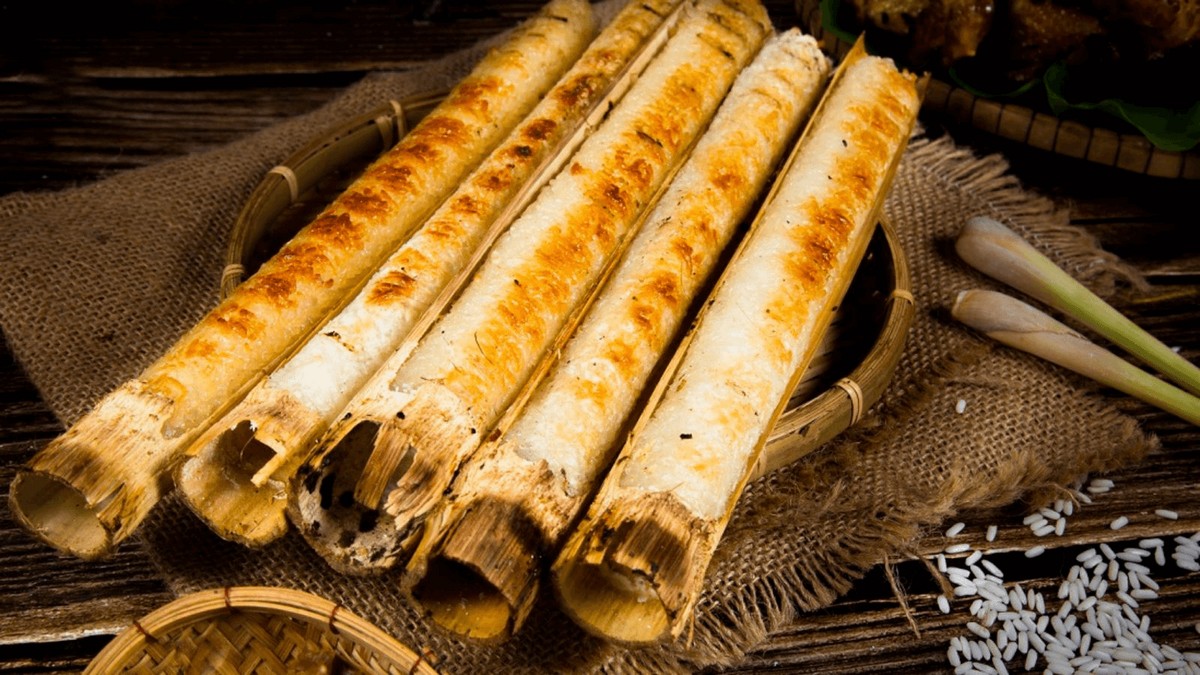
Thit Trau Gac Bep (Dried Buffalo Meat)
This dried buffalo meat is a specialty in Sapa and makes for a tasty snack or ingredient in various dishes. To enhance its flavor, you can eat it with a squeeze of lime juice and some chili sauce.
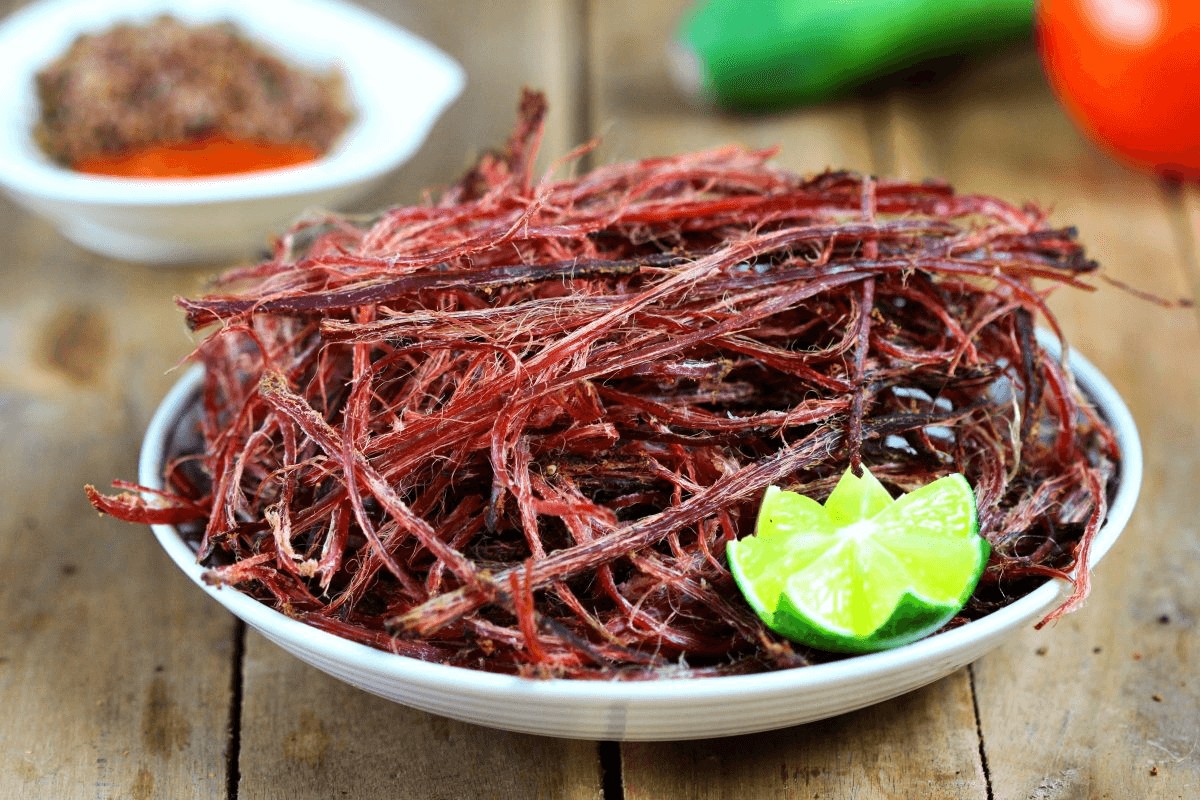

Mam Da (Sapa stone sprouts)
Sapa stone sprouts are a delightful specialty vegetable in Sapa. They are similar to choy sum but have larger stems and abundant branches. With their small leaves, they resemble sprouts growing in the crevices of rocks. These vegetables can be found on the high mountain peaks of Sapa and are only available from November to March, adding a touch of freshness to your meals during those months.

These are just a few of the must-try local foods in Sapa. Embark on your journey to this charming highland town, visit the restaurants in Sapa , and discover more delicious local dishes!
Sapa Travel Guide: Best Things to Do
Below is a list of great things to do in the beautiful town of Sapa, Vietnam. Keep in mind that these suggestions only scratch the surface and there is so much more to explore and experience!
Trek to the local villages
A trek to the nearby local villages is an amazing chance to fully experience the vibrant culture and traditions of the hill tribes. One of the must-visit places is Cat Cat Village, where you can observe the Hmong villagers cultivating in the valley and crafting exquisite handmade textiles.
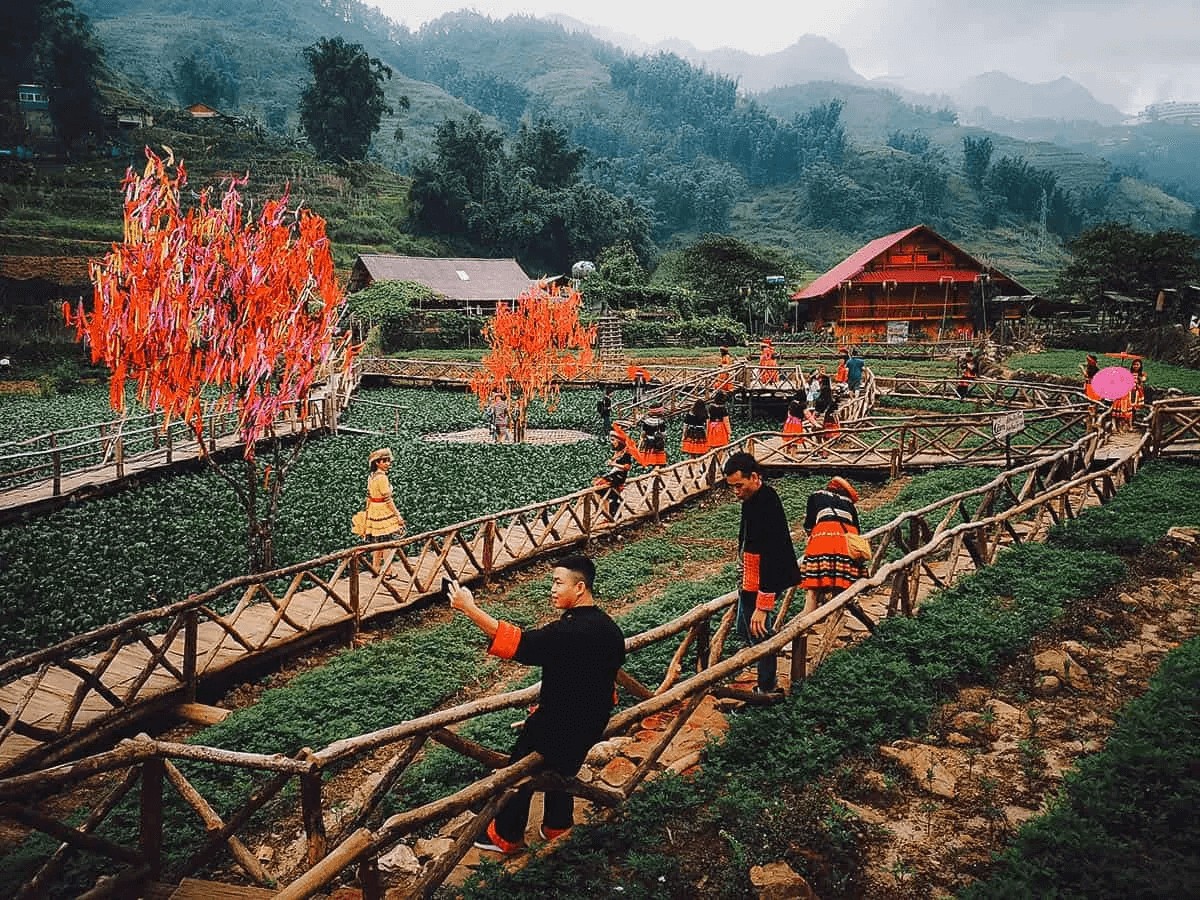
Hike up the highest mountain in Southeast Asia (or take the cable car)!
Reaching the roof of Indochina may be challenging, but it is definitely worth it for the sweeping views of the beautiful countryside. Alternatively, you can opt for a cable car ride to the summit and enjoy the awe-inspiring scenery through the windows.

Immerse in the lively atmosphere of Sapa local markets
A visit to local markets in Sapa is a great way to explore a more authentic side of the town. Taking a leisurely stroll among the stalls and discovering a wide range of vibrant, locally-sourced produce, you can find beautiful handicrafts that make for meaningful gifts or souvenirs for your loved ones.
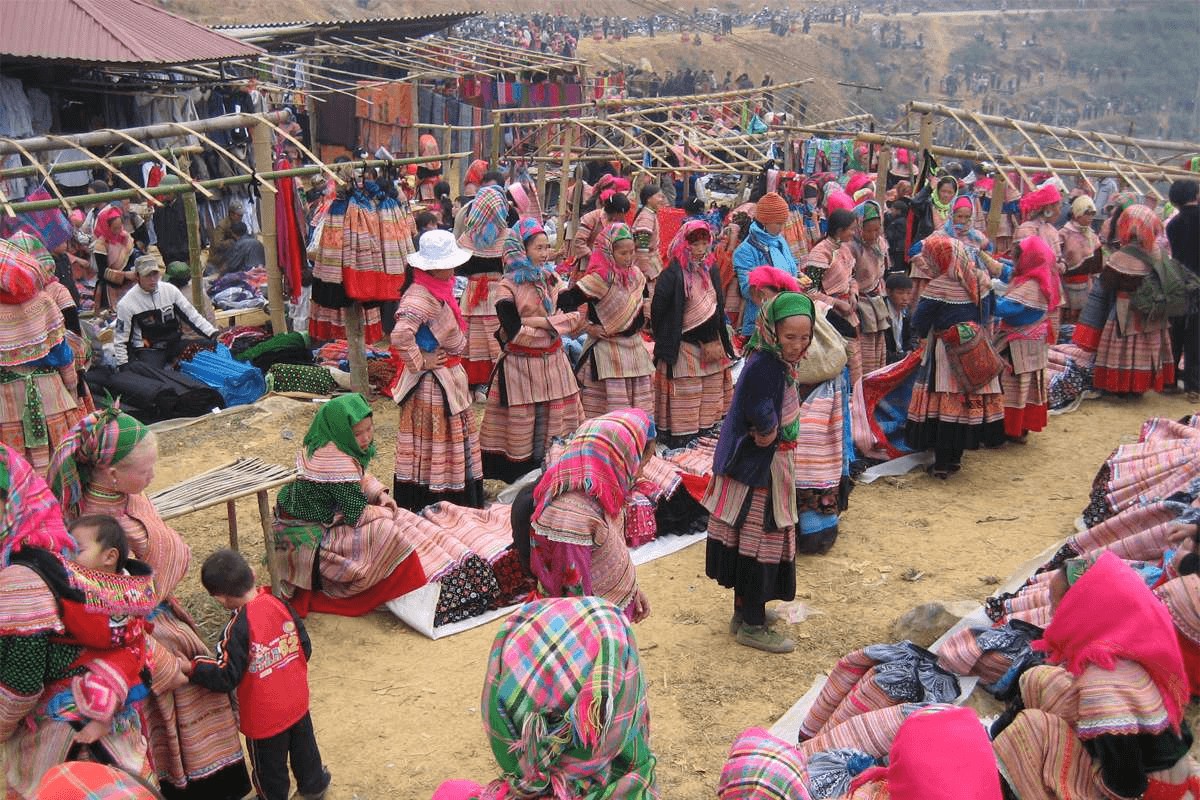
Best Time to Visit Sapa
The best time to visit Sapa is during spring (March to May) and fall (September to November). During these seasons, the weather is pleasant and relatively stable, with sunny days and cool nights, making it ideal for most outdoor activities and exploration.
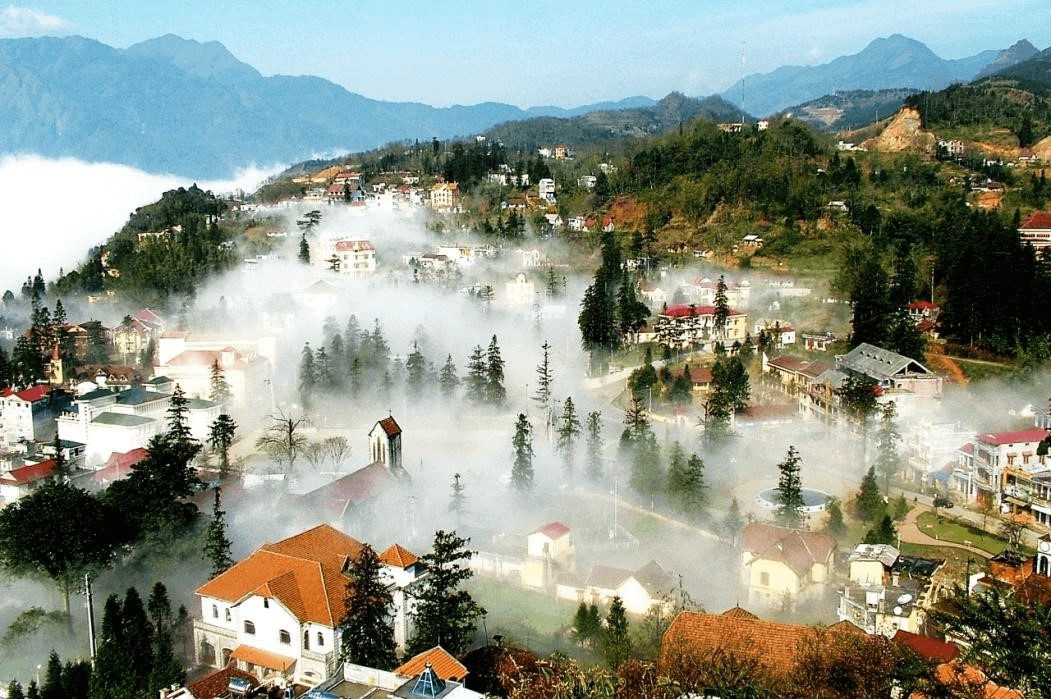
How Long to Spend in Sapa
So, what is the ideal duration for a trip to Sapa ? It depends on your interests and travel style, but typically spending 2 to 4 days in Sapa is sufficient to fully immerse yourself in the beauty of this town. During your stay, you will have the opportunity to explore the picturesque landscapes, take breathtaking hikes through the surrounding rice paddies, visit ethnic minority villages, and participate in cultural experiences.
Hopefully, the information in the Sapa Travel Guide above is helpful for you. Sapa is a fantastic tourist spot that attracts numerous tourists for several reasons. So, what are you waiting for? Start your journey to Sapa , enjoy your time, and immerse yourself in the stunning landscapes and vibrant local culture!
Tours related to Sapa
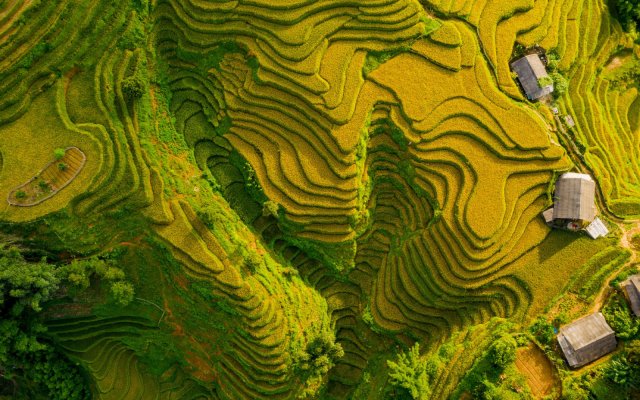
Hanoi – Sapa – 5 Days 4 Nights
$ 500 $ 439 +

Hanoi – Ta Xua – Moc Chau – 6 Days 5 Nights
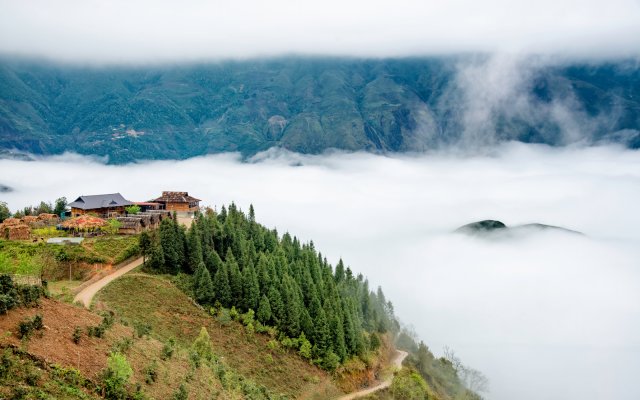
Hanoi – Halong Bay – Ta Xua – Moc Chau – 6 Days 5 Nights

Discover Vietnam – Scenic and Short Trek – 15 Days 14 Nights

Highlights of Vietnam – 15 Days 14 Nights
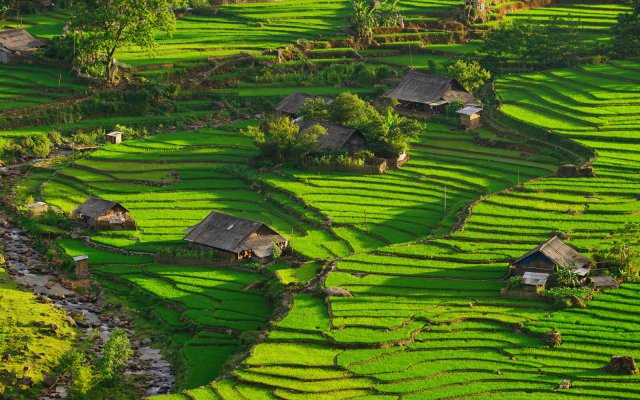
Discover Northwest Vietnam – Hanoi – Sapa – 5 Days 4 Nights
$ 575 $ 510 +
Shirleen Bui
Related travel guides.

Culinary Delights: 10 Exquisite Dining Sapa Restaurants

Sapa Homestay: Top 10 Hillside Views for Travel Enthusiasts
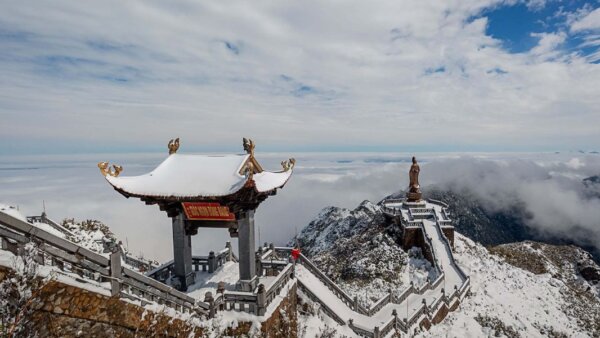
Sapa Vietnam Snow: Embracing Unique Winter Magic
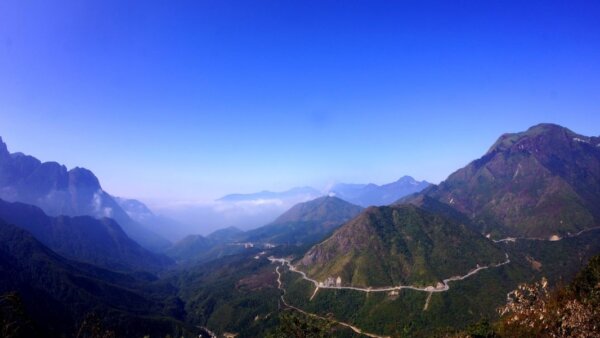
O Quy Ho Pass: Roads to A Majestic Adventure Unveiled
Leave a reply cancel reply.
Your email address will not be published. Required fields are marked *
Save my name, email, and website in this browser for the next time I comment.
Sapa, Vietnam: 9 Places to Visit & Things to Know
- August 6, 2023
- Last updated on December 5, 2023
- Vietnam Travel Blogs
Though Sapa is just a small town in Vietnam, its allure has reached global proportions. Many international travelers have only heard of Sapa through word of mouth or the internet, and they always wish to visit Sapa at least once in their lifetime. This has transformed Sapa into one of Vietnam’s most enticing tourist destinations. When you visit Sapa, you will be able to marvel at the majestic nature of the hills and mountains, gaze upon the sprawling terraced rice fields, and explore the lives of Vietnam’s various ethnic minority groups. Join us as we list some of the best attractions in Sapa and provide a few tips for your travel experience in Sapa. Read more: The Best 2-week Tour itinerary in Vietnam
Table of Contents
Overview of Sapa
Sapa is a highland town located in Lao Cai Province, a province in the Northwestern region of Vietnam . Considered the most beautiful and majestic place in the Northern mountainous region of Vietnam, Sapa consistently attracts a large number of domestic and international tourists every year. One of the most beloved features of Sapa by visitors is its terraced rice fields, ethnic villages, and grand mountain ranges.
Due to the influx of tourists, Sapa has garnered international investor interest, leading to the establishment of numerous luxury hotels, resorts, and top-tier entertainment services. This comprehensive investment has shaped Sapa into what it is today – a premier and captivating tourist destination in Vietnam.
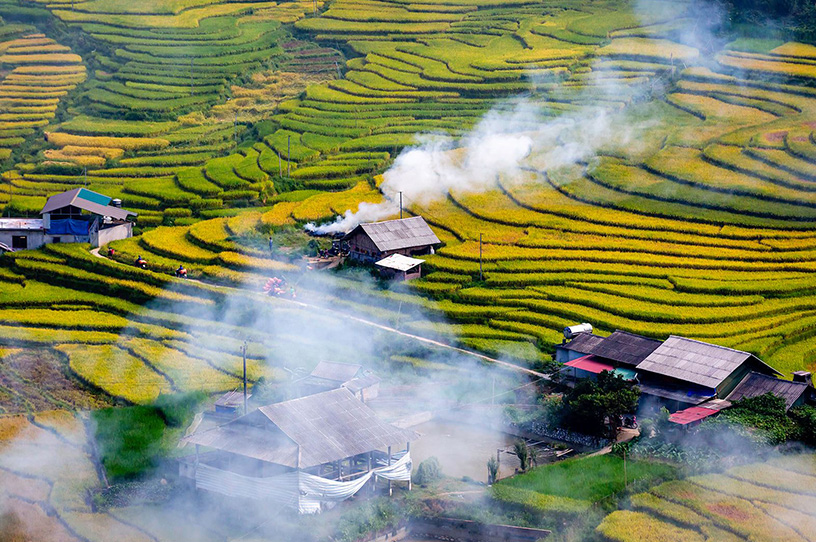
Best time to visit Sapa
Sapa has a cool climate with an average temperature of only 15 degrees Celsius, and it is one of the rare destinations in Vietnam that experiences all four seasons: spring, summer, autumn, and winter. Any time of the year is ideal for visiting Sapa, except during the rainy season from June to early August.
The best time to visit Sapa is during the autumn season, which lasts from September to November. During this time, Sapa is truly enchanting with the golden hues of ripened rice fields, and the weather gradually turns cooler. It is also the low tourist season for domestic travelers, so you will mainly see international tourists during this period. The winter season, from December to February, occasionally brings snow to the mountain peaks.
How to get to Sapa?
Currently, there are no direct flights from Hanoi to Sapa, so you can only travel to Sapa by road or by train. There are two main stages of transportation from Hanoi to Sapa:
- First, you need to take a train or car from Hanoi to Lao Cai province, covering a distance of nearly 300 km, which takes about 6-8 hours.
- Then, you travel by car from Lao Cai to Sapa on a 35 km mountainous route, which takes about 1 hour.

We recommend taking the night train from Hanoi to Lao Cai , and then taking a car to Sapa in the morning, as this is the most convenient option.
9 Best Attractions in Sapa, Vietnam
1. fansipan peak.
Fansipan is the highest mountain on the Indochinese Peninsula, standing at over 3000 meters above sea level. It is located about 9 km southwest of Sapa town. While it takes 6 to 7 days to hike and conquer the peak, most tourists opt for the cable car ride from the center of Sapa to the summit. This way, they save time and still get to admire the majestic natural beauty.
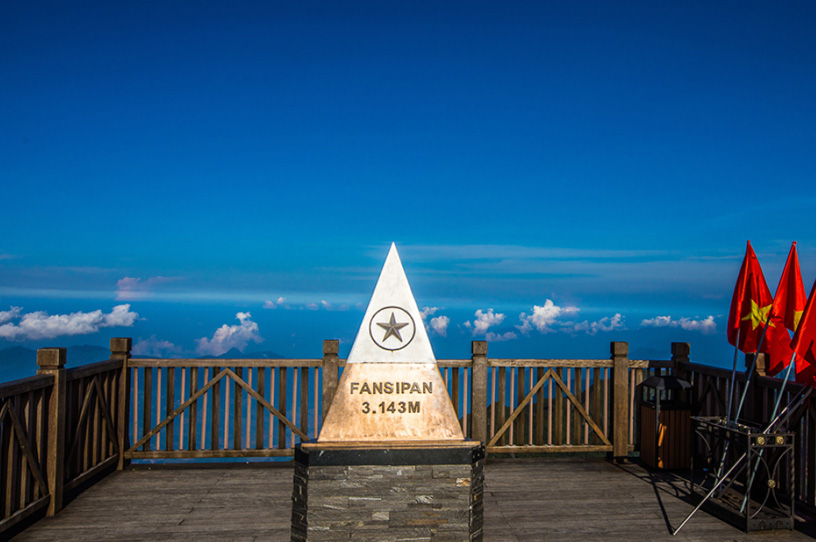
Read more: How to Build a Suitable Tour Package for You
2. Ham Rong Mountain
Ham Rong Mountain is relatively close to the center of Sapa, around 3 km away. The area has a pleasant climate with temperatures around 18 degrees Celsius, making it suitable for hiking or mountain climbing. Standing at the top of Ham Rong Mountain, you can enjoy a panoramic view of Sapa town, the Muong Hoa Valley, and Sapa and Ta Phin hidden in the mist.

Read more: Places to visit Nha Trang
3. Stone Church of Sapa
Located right in the center of Sapa town, the Stone Church of Sapa was built in 1895 and is considered the most intact architectural relic of the French that still remains. Despite going through various historical events and renovations, the church has retained its original charm and has become an iconic symbol of Sapa.

Read more: 7 Museums in Ho Chi Minh city You Should Visit
4. Cat Cat Village
About 2 km from the center of Sapa, Cat Cat Village is an ancient village of the H’Mong people, where many traditional customs and crafts are still preserved, such as weaving, silver carving, and jewelry making. The place has been developed into a tourist area known as Cat Cat Tourism Village.
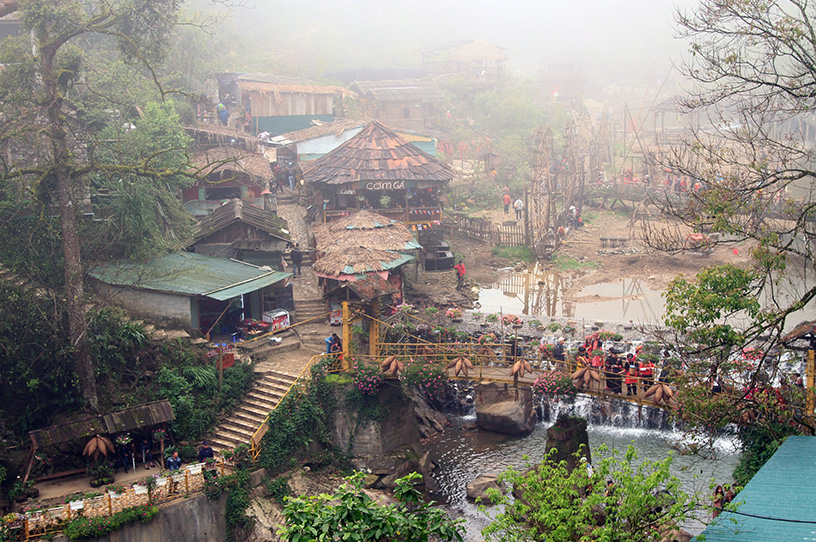
Read more: Phu Quoc, Vietnam: Places to Visit & Things to Know
5. Ta Phin Village
Ta Phin Village is located about 15 km east of Sapa town. It offers beautiful natural landscapes and rich cultural identity of the Red Dao ethnic group, known for their famous brocade weaving. Visitors to Ta Phin can also explore the nearby Ta Phin Cave, which features intriguing stalactite formations.
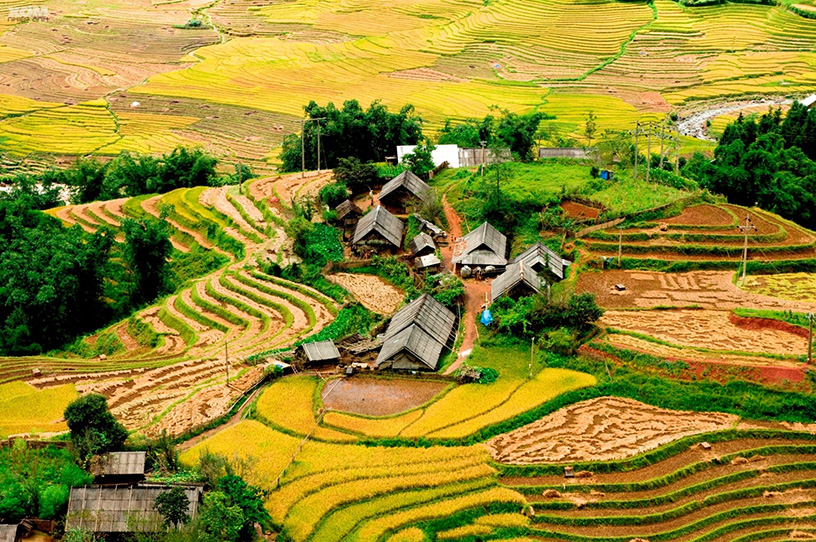
Read more: Hoi An Ancient Town – Some Sightseeing Tips
6. Sin Chai Village
Sin Chai Village is the largest village in Sapa, situated next to the picturesque Cat Cat Village, about 5 km from Sapa town. The village is home to around 1600 H’Mong people, and visiting here allows you to experience the unique culture of the H’Mong people, reflected in their daily life, architecture, and various aspects of the village.
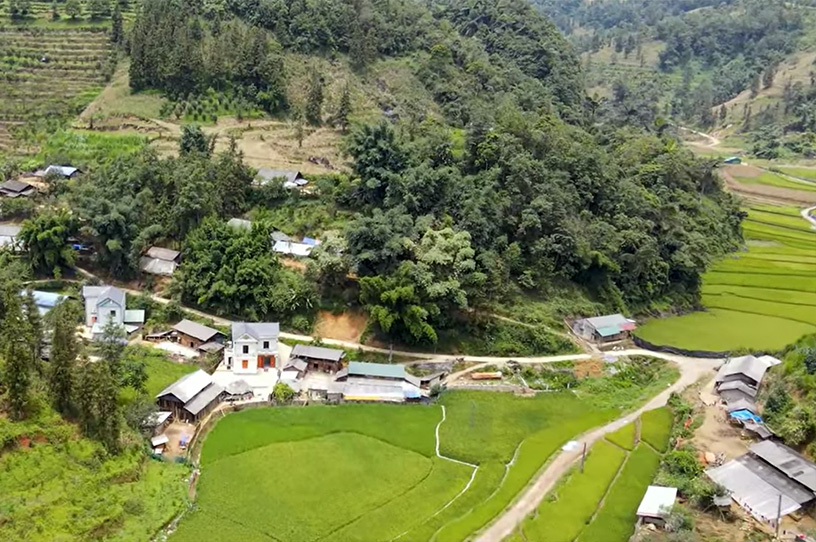
7. Lao Chai and Ta Van Villages
Located about 8 km from the center of Sapa, Lao Chai and Ta Van are two large villages with a mix of different ethnic groups living together. Visiting these villages, you can not only learn about the local life of the ethnic minorities but also witness the vast expanse of terraced rice fields that turn golden during the end of summer, creating a stunning view.
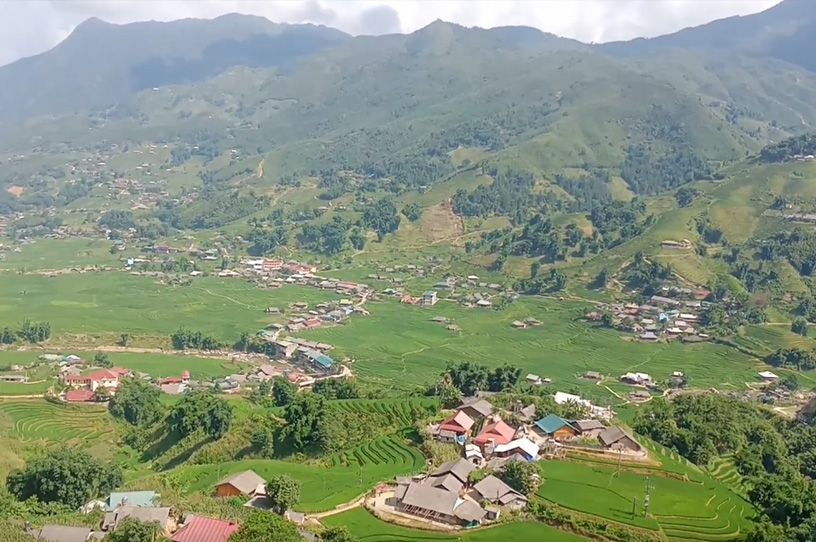
8. Muong Hoa Valley – Ancient Rock Field
Muong Hoa Valley is about 8 km southeast of Sapa town. What makes this valley special is the ancient rock field with various carvings scattered among the terraced rice fields of the ethnic people. Hundreds of engraved stones with mysterious symbols and characters have yet to be fully understood in terms of their origin and meaning. Today, this ancient rock carving site has been recognized as a national monument and is a unique heritage of the ancient Vietnamese.
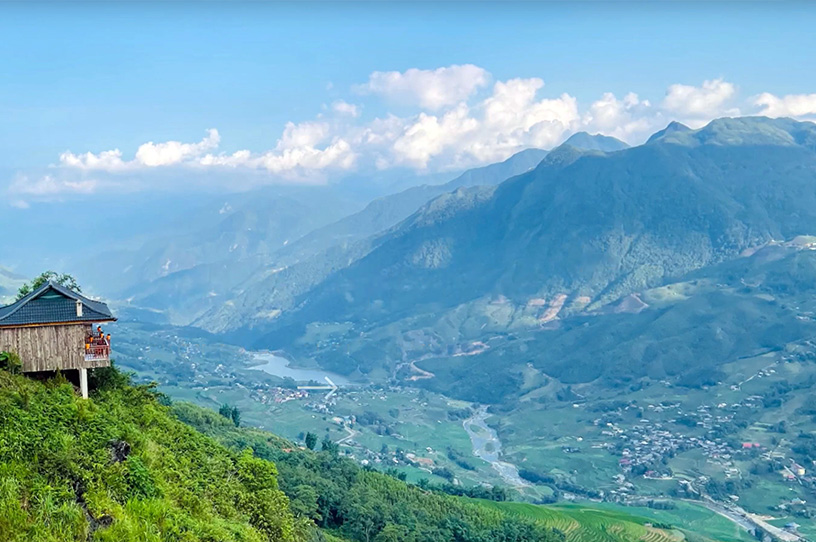
9. Sapa Sky Gate
Sapa Sky Gate is a famous tourist spot located on the O Quy Ho Pass at an altitude of 2035 meters above sea level, about 18 km from Sapa town. To reach this place, visitors must travel a 50 km route by motorbike or opt for a cable car ride, which is more expensive but ensures a safer and more convenient journey. Once you arrive at Sapa Sky Gate, you’ll be amazed by the surrounding mountains and lush green forests, creating a refreshing and immersive natural experience.

Sapa cuisine
Salmon in sapa.
Speaking of Sapa’s specialties without mentioning salmon would be a significant omission. Nowadays, salmon is being bred and raised in Sapa. The quality of salmon here is no less than that of imported salmon. The flesh of the fish is fragrant and not overly fatty, suitable for eating raw like sashimi or for preparing dishes like grilling or baking.
Wild Boar Meat
Sapa’s wild boar is a breed of pig with black fur that is raised by the Mong ethnic people on the hills. When fully grown, each pig only weighs about 6kg. The pork is firm and is interspersed with lean meat and fat. When grilled on a charcoal stove, it exudes an appealing and enticing aroma.
Some good hotels in Sapa
Hotel de la Coupole Sapa – MGallery by Sofitel Address: 1 Hoang Lien Street, Sapa Town, Lao Cai Province.
Hotel de la Coupole is a 5-star hotel in Sapa designed by Bill Bensley. It boasts nearly 250 luxurious rooms, featuring a classic French design with rich and bold colors. Each room is a unique masterpiece meticulously crafted with high-quality interior furnishings.

Website: https://www.hoteldelacoupole.com
Topas Ecolodge Address: Ban Lech Village, Thanh Kim Commune, Ban Ho, Sapa.
Topas Ecolodge Sapa is a resort offering 33 sturdy and solidly built bungalows made of granite. Located on a hilltop, the place boasts a wide and beautiful view. One of the highlights of Topas Ecolodge is its infinity pool overlooking the vast mountainous area of Sapa.
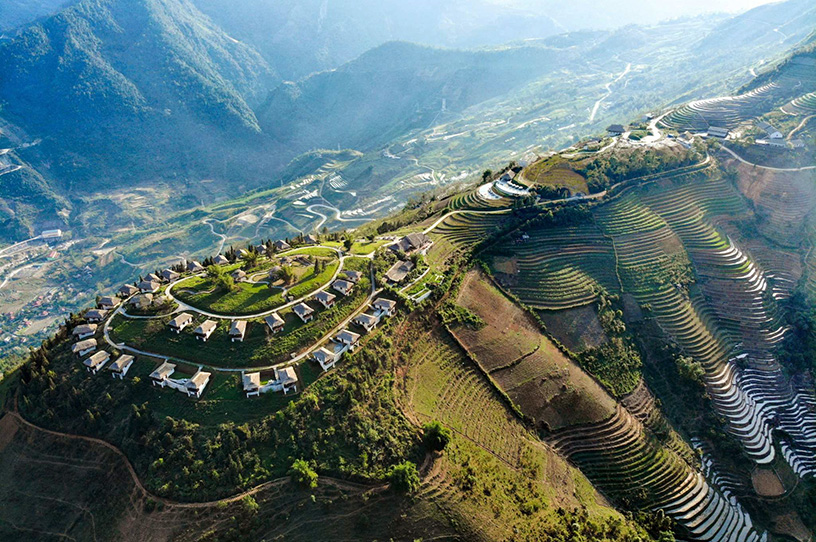
Silk Path Grand Resort & Spa Sapa Address: Doi Quan 6, Group 5, Sapa.
Silk Path Grand Resort & Spa Sapa is situated on a separate hill with breathtaking views. Inspired by luxurious French castles, the resort exudes elegance and sophistication with a distinctive Indochine architectural style influenced by the local Sapa culture. It proudly presents a dreamy vacation spot amid the Northwest mountains and forests.
BB Sapa Hotel Address: 8 Cau May Alley, Sapa.
BB Sapa Hotel is a 4-star rated hotel conveniently located in the center of Sapa, providing easy access to the town’s famous tourist attractions.
Sapa Jade Hill Resort and Spa Address: Premium Resort, Cau May Alley, Group 3, Sapa.
Sapa Jade Hill Resort and Spa is a 5-star resort nestled in the Lao Chai – Ta Van town, Sapa, about 2 km from the city center. It is surrounded by majestic nature, close to the beautiful Muong Hoa Valley, offering splendid panoramic views of Sapa.
Bamboo Sapa Hotel Address: 18 Muong Hoa, Sapa, Lao Cai Province.
Bamboo Sapa Hotel is a standard 4-star hotel in Sapa, and it is known for its beautiful views.
Pao’s Sapa Leisure Address: Muong Hoa Street, Sapa Town.
Pao’s Sapa Leisure stands out with its design resembling terraced rice fields. It offers 223 high-end rooms, reflecting the local cultural identity. The rooms are well-equipped with premium amenities and have spacious views. The hotel’s swimming pool and restaurant are highly rated by customers, making it a worthy choice.
Read more: Top 7 Vietnamese Rolls You Should Try
Pistachio Hotel Sapa
With its distinct local architectural style within a luxurious space, the 4-star Pistachio Hotel Sapa is a great choice. Located in the center of Sapa, it offers easy access to other tourist spots in the city. Additionally, the hotel provides a wide and open view of the Muong Hoa Valley. The modern and natural interior architecture, along with the warm and friendly staff, make it a top choice for a 4-star hotel in Sapa.
Sapa Panorama Address: 10 Hoang Dieu Street, Sapa Town.
If you are looking for a good 3-star hotel in Sapa, Sapa Panorama is the choice for you. Located in the central area, it offers convenient transportation. Moreover, it provides a panoramic view of Sapa town and the Hoang Lien Son mountain range.
Cafes with beautiful views in Sapa
Sailing Sapa Address: Sapa Ancient Rock Field, Sapa.
Read more: 14 Best Restaurants in Hoi An Ancient Town
Ville De Mont Mountain Resort Address: To 7, Sapa town, Sapa district, Lao Cai.
Coóng Coffee & Homestay Address: To 1, Cau May ward, Sapa, Lao Cai.
Viettrekking Sapa Address: 33 Hoang Lien, Sapa town.
Fansipan Terrace Cafe Address: 67 Fansipan, Sapa.
Notes when visiting Sapa
Note about clothing
If you visit Sapa in the summer, shorts and jeans are suitable, and you might want to bring a thin jacket to guard against the evening chill. In the winter, you’ll need thicker clothing to keep warm as there can be snowfall in Sapa during this season.
Read more: Top 10 Souvenirs to Buy When Traveling Vietnam
Prepare personal items
Sapa mainly consists of hilly terrain, and you’ll likely be walking quite a bit. Therefore, prepare a pair of sports shoes to facilitate movement.
Prepare cash and bank cards
Banking services in Sapa are quite developed. You can easily find ATMs in the town of Sapa or bank branches. However, it’s advisable to have cash on hand for convenient payment of dining or souvenir purchases.
Read more: Where To Exchange US dollars (USD) to Vietnamese Currency?
Taking photos with ethnic minorities
Sapa is often home to ethnic minority groups such as the H’Mong and Red Dao. If you wish to take photos with them, it’s considerate to offer a small gratuity as a token of appreciation.
The best tourist attractions in Sapa that we have just mentioned above will allow you to fully experience the majestic nature, life, and culture of Sapa. If you don’t have much time, you can choose a few key spots to visit, such as Fansipan, Ham Rong Mountain, and Cat Cat Village. Additionally, you should also take note of the best time to visit Sapa to ensure the best experience for your trip.
Plan Your Trip
Related Posts

Cao Bang, Vietnam: Top 9 Places to Visit
- November 14, 2023

Phu Yen, Vietnam: Top 10 Places to Visit
- November 1, 2023

Ben Tre, Vietnam: Top 10 Places to Visit
- October 31, 2023
Leave a Reply Cancel Reply
Your email address will not be published. Required fields are marked *
Name *
Email *
Add Comment *
Save my name, email, and website in this browser for the next time I comment.
Post Comment
- Best 13 Hotels in Bac Ninh That Exceed All Expectations
- 20 Beautiful Hotels in Phu Tho
- 11 Delightful Hotels in Thai Nguyen You Won’t Want to Miss
- 8 Affordable Hotels in Tuyen Quang to Elevate Your Stay
- 7 Hotels in Lang Son for a Luxurious Escape
Travel to Sapa Vietnam – Useful Guide for Your First Time
- by Chau Nguyen
- June 6, 2023
- 19 minutes read
Situated at the base of the magnificent Hoang Lien Son mountain range and just a 5-6 hour drive from Hanoi via the highway, Sapa Vietnam is a perfect year-round destination. Apart from the enchanting terraced fields during the rice harvest season, Sapa also captivates visitors with the splendor of numerous other attractions. In this Sapa travel guide, we will provide you with essential information to ensure a fantastic first trip.
Table of Contents
Where is sapa, when is the best time to visit sapa, how to go to sapa, how to move around sapa, what to do for the first time in sapa, what to eat in sapa, hotels in sapa, atm and money exchange in sapa, local emergency contact for tourists in sapa, other notes to ensure a wonderful trip beside of this sapa vietnam travel guide.
Sapa town is situated in the Lao Cai province , in the northwest region of Vietnam. It is located approximately 350 km northwest of Hanoi city and is close to the border with China. Sapa is renowned for its stunning and rugged landscape, as well as its rich cultural heritage and diverse cuisine. In the early 20th century, the French regarded Sapa as the Summer Capital of Northern Vietnam. Since then, Sapa’s natural beauty has continued to attract an increasing number of visitors who choose to spend their vacations there. It is especially popular as a honeymoon destination for couples.

Sapa enjoys a cool climate, making it a suitable destination for year-round travel. However, it’s best to avoid the stormy season from June to early August, as this period can bring about extreme weather conditions like floods, flash floods, and landslides.

From February to May, Sapa blossoms with a vibrant spring season, showcasing a variety of flowers such as cherry apricots, peaches, and plums. During the summer months of June to August, Sapa becomes a popular getaway for tourists seeking respite from the heat. It’s a great time to witness the lush green rice terraces.

Autumn graces Sapa from September to November, offering a picturesque landscape with golden hues from the ripened rice field, and the weather starts to turn cooler. Winter arrives from December to February of the following year, and if you’re fortunate, you may even have the chance to witness snow and ice atop the mountains.
Bus or train
To travel from Hanoi to Sapa, you have a few options available. You can book a limousine or a bus from My Dinh bus station, with prices ranging from 230,000 to 350,000 VND per person, depending on the seat class. The journey typically takes around 5-6 hours.
If you prefer to take the train, you can choose the Hanoi-Lao Cai route. The train ride lasts approximately 7-9 hours, and upon arrival in Lao Cai, you will need to take a bus or taxi to reach the center of Sapa. Train ticket prices vary from 160,000 to 800,000 VND, depending on the seat class and train type.
Alternatively, you can opt to drive to Sapa on your own. Take the Noi Bai-Lao Cai highway and then turn onto 4D road, which will lead you to Sapa. The road is generally easy to navigate, but it’s important to pay attention to road signs and maintain an appropriate speed. Before setting off, make sure to check your tires, brakes, lights, and other essential components, especially during cold rain, fog, or when the roads are slippery. The driving time is approximately 5-6 hours. It is advisable to depart from Hanoi no later than around 12:30 PM to ensure that you reach the mountain pass to Sapa before it gets too dark.
Book a tour from Hanoi
One of the best ways to save energy and effort when planning a trip to Sapa is by booking a tour. By doing so, you won’t have to worry about transportation, food, and accommodation, and you’ll have the opportunity to visit the most prominent travel destinations, which are tailored to be interesting. There are numerous tour providers that can help you arrange a tour from Hanoi to Sapa, but we recommend booking through Klook. Klook is a trusted platform that qualifies and rates its tour providers based on feedback from thousands of tourists, ensuring peace of mind throughout your journey.
Rent a Motorbike
Motorcycles are a popular mode of transportation in Sapa, favored by many tourists. This vehicle allows you the freedom to explore the captivating attractions of this misty town at your own pace and convenience.

Furthermore, motorcycles are an excellent option for adventurous young travelers who are passionate about exploring both picturesque and thrilling roads. It is advisable to travel in a group, ensuring convenience in movement and minimizing the risk of encountering difficulties on the road.
If you don’t have a motorcycle with you, you can rent one from the following locations:
Hire a motorbike taxi
To make your way around Sapa, you can opt for a motorbike taxi service. This is a suitable choice for those who may feel uncertain about navigating on their own. By hiring a motorbike taxi driver, they can serve as your guide, taking you to popular tourist attractions. The rental price for a motorbike taxi typically ranges from 100,000 VND to 150,000 VND for visiting 4-5 attractions located near each other in Sapa.

If you are traveling in a group, another option is to rent a tourist car with 4 to 16 seats. The rental price for such a vehicle ranges from 400,000 VND to 500,000 VND per attraction. Alternatively, you can negotiate a full-day rental. Apart from serving as a motorbike taxi driver, these drivers can also act as guides, providing you with valuable insights about the various places to help you better understand Sapa.
Renting a taxi in Sapa is a convenient option, especially for group or family travel. However, it’s important to note that taxi rental prices in Sapa can be relatively high, and the fare is typically calculated based on the number of destinations, rather than the duration of the rental. Therefore, it’s advisable to inquire about the price beforehand to avoid any surprises.
By renting a taxi, you can have some assurance regarding weather conditions. On the flip side, taxis may have limitations when it comes to venturing deep into the villages, and their access may be restricted to the outer areas.
Trekking in Sapa offers a wonderful combination of walking and exercise while immersing yourself in the majestic beauty of the region. It allows you to explore Sapa without any obstacles holding you back.

However, trekking requires good physical health, so make sure to prepare the necessary items, especially good hiking shoes with arches support to ensure a smooth journey. With this activity, you won’t have to worry about parking or taking care of a vehicle. Additionally, it’s easier to navigate shorter distances and reach nearby destinations on foot.
One great option is to join a trekking day tour specifically tailored for destinations like Cat Cat, Ma Tra, Ta Phin, Cao Chai, and Ta Van.
You can allocate approximately 3 days and 2 nights to exploring the famous attractions in Sapa.
Ham Rong Mountain

Ham Rong Mountain is a popular spot teeming with tourists, offering a mesmerizing and misty landscape. It has a range of elevations, with the lowest point at 1,450m and the highest point exceeding 1,800m. From the mountain’s summit, you can enjoy panoramic views of Sapa’s notable tourist destinations such as Muong Hoa Valley, Ta Van Village, and Cat Cat Village.
Ham Rong Mountain is an ideal place for a picnic, combining dining, shopping, and sightseeing, as numerous shops and beautiful flower gardens line the way up the mountain. The entrance fee for Ham Rong Mountain tourist area is 70,000 VND for adults and 30,000 VND for children.
Sapa Stone Church

Following your visit to Ham Rong Mountain, you can return to the town center, not far away, to explore Sapa Stone Church. This architectural gem holds symbolic significance for the mountainous town and was initiated in 1895. The church, designed in Gothic style, features elements like a cross-shaped structure, arched doorways, and a bell tower, all showcasing exquisite craftsmanship.
Cat Cat Village

Situated just 2 km from the center of Sapa, Cat Cat Village offers the choice of trekking or motorbiking to reach its serene Hmong community. The village proudly preserves various customs and traditional crafts, including weaving, silver carving, and jewelry making.
The journey to the village is picturesque, with winding roads flanked by terraced fields and ethnic dwellings. Upon crossing Si Bridge, you’ll arrive at the heart of Cat Cat Village, where the convergence of Tien Sa Stream, Vang Stream, and Bac Stream can be witnessed. Exploring the village allows you to gain insights into the lives of the Mong people, purchase handmade products as souvenirs, and indulge in local delicacies. The entrance fee to visit Cat Cat Village is 50,000 VND per person.
JOIN TREKKING DAY TOUR TO CAT CAT VILLAGE FROM SAPA
Lao Chai – Ta Van

To reach Ta Van, located approximately 10 km from the town, you can opt for a motorbike, taxi, or trekking. The road leading to Lao Chai – Ta Van is narrow, enveloped by the soothing green hues of rice and corn terraces. Although it is no longer entirely untouched, Lao Chai – Ta Van maintains its peaceful ambiance and is inhabited by various ethnic minorities , including the Mong, Dao, and Giay.
The captivating feature here, apart from the local ethnic life, is the sprawling terraced fields that adorn the hillsides, which we already listed in the top places to watch golden rice fields in Vietnam . Late summer is a particularly enchanting time as the rice ripens, painting the entire mountainous area in a golden hue. If you have ample time, it is recommended to spend a day here to immerse yourself in the local way of life. The entrance fee to the area is 70,000 VND per person.
JOIN TREKKING DAY TOUR TO LAO CHAI- TA VAN FROM SAPA
Fansipan Peak

For a less strenuous ascent to the highest peak of Fansipan mountain , you can take advantage of the cable car and mountain train. In the morning, head to the mountain railway station across from Sapa town square to purchase tickets. The cable car ticket costs 715,000 VND per adult and 525,000 VND per child, while the mountain train ticket is priced at 99,000 VND per person.
PREBOOK YOUR CABLE CAR & TRAIN TICKETS TO AVOID PEAK TIME
To reach the summit of Fansipan, follow the route of the mountain train and cable car, then proceed with either another train ride or a walk up 600 steps. Each leg of the train journey lasts approximately 6-7 minutes, while the cable car ride takes around 30 minutes. Walking enthusiasts can leisurely ascend the stairs and explore the spiritual complex on Fansipan, which features attractions like Kim Son Bao Thang Pagoda, an 11-storey tower, and the largest bronze statue of Amitabha Buddha in Vietnam.

At the cable car and mountain train stations, you’ll find stalls selling souvenirs and restaurants catering to the shopping and dining needs of visitors. It is advisable to wear comfortable shoes with low heels and bring a jacket, raincoat, or umbrella in case the weather at the mountain peak suddenly becomes chilly and overcast.
This picturesque attraction, known as Swing Sapa, is situated at 87 Nguyen Chi Thanh, near the town center, approximately 2 km from the Stone Church in the direction of the cable car.

Featuring captivating sculptures such as a man and woman statue, a giant stone hand, a Buddha statue, the “stairway to heaven,” and swings, Swing Sapa offers countless photo opportunities with its unique settings.
Prior to visiting, it is recommended to prepare your own photo props, or you can rent them on-site for 50,000 VND per set. Ensure that your camera and phone batteries are fully charged. If traveling with a group, you can even organize a camping trip or a small picnic in this area. The entrance fee is 80,000 VND per person.
Seo My Ty Lake

To reach Seo My Ty Lake, located in Ta Van commune, you must traverse a challenging 20 km road filled with large and small stones, making it quite difficult for inexperienced drivers. The lake was formed by constructing a dam for the Seo My Ty hydropower plant, and it holds the distinction of being the highest artificial lake in Vietnam. When viewed from above, the lake resembles a silk ribbon running alongside the Hoang Lien Son mountain range. Visitors can seek permission from local fishermen to sit on boats and rafts, enjoying the lake’s beauty and learning about salmon farming practices in the area.
Heaven’s Gate

From the center of Sapa, follow Highway 4D for approximately 15 km to reach Heaven’s Gate, situated at the highest point of the O Quy Ho pass. Standing here, you can marvel at the panoramic view of the vast valley below, adorned with terraced fields and winding roads. Several newly built establishments such as restaurants, cafes, and hotels can be found at Heaven’s Gate. Admission to Heaven’s Gate is priced at 80,000 VND per person and includes a drink.
O Quy Ho Pass

O Quy Ho Pass, known as the “King of the Passes,” features a deep valley on one side and rugged cliffs on the other. Stretching for about 50 km, it connects the provinces of Lao Cai and Lai Chau. For those seeking great photo opportunities, it is recommended to visit O Quy Ho Pass around sunset, between 17:00 and 17:30. As the sun gradually sets behind the mountains, the entire pass is bathed in a mesmerizing golden hue. However, Sapa’s weather can change rapidly, with dark clouds often rolling in just minutes after sunset.

Along the road to Silver Waterfall and Love Waterfall, you’ll find numerous stalls selling local specialties, food, and drinks, providing seating for weary travelers. When visiting O Quy Ho Pass, it is advisable to bring a raincoat and warm clothing. If traveling by motorbike, remember to wear a helmet and exercise caution on the winding roads.
Silver Waterfall – Love Waterfall

Located on the road of O Quy Ho Pass, approximately 3 km from the pass’s summit, Silver Waterfall and Love Waterfall are must-visit destinations, particularly popular among young people. Silver Waterfall features steps leading to the top of the waterfall, but be cautious as the higher you climb, the colder it gets and the water flow becomes stronger, making it important to watch your step to avoid slipping. Love Waterfall, although a 1.5 km walk from the entrance, takes visitors through a scenic forested area. Admission to Silver Waterfall is priced at 20,000 VND per person, while Love Waterfall tickets cost 75,000 VND per person.
Grilled food & hot pot

When visiting Sapa, indulging in grilled food is a must as it is a ubiquitous dish with a wide variety of options. You can enjoy skewers of pork, chicken, and vegetables, as well as grilled eggs, corn, potatoes, and lam rice. The prices for these delicious barbecue items range from 20,000 to 100,000 VND each. Another popular choice is salmon and sturgeon, which can be enjoyed in hot pot dishes or even raw. A hot pot typically costs between 300,000 and 600,000 VND and is suitable for 3 to 6 people to share.

Restaurants in Sapa
- Thang Co A Quynh (Thach Son Street): This restaurant is known for its specialty dish called “Thang Co,” which is a traditional horse meat stew enjoyed by the local ethnic groups.
- Hotpot Center (Xuan Vien Street): Here, you can savor delicious fish hotpot dishes. It’s a great place to warm up and enjoy a comforting meal.
- Ong Ha’s effervescent noodle soup (468 Dien Bien Phu): This restaurant serves a unique and flavorful effervescent noodle soup, a must-try dish in Sapa.
For young tourists who seek a vibrant atmosphere and enjoy good food, they can visit:
- My Grill (Dien Bien Phu Street): This restaurant specializes in charcoal grilled dishes, offering a wide selection of tasty grilled options.
- Tuk Tuk Chicken Shop: Known for their grilled spicy ribs and cheese shake, this place offers a unique dining experience with a fusion of flavors.
- H’Mong Pizza at Pi’s Boutique: Here, you can try the famous H’Mong Pizza, a local twist on the classic pizza, featuring local ingredients and flavors.
These restaurants provide a variety of culinary delights for visitors to explore and enjoy during their time in Sapa.

In the town center of Sapa, there are numerous cafes for visitors to choose from. However, if you prefer a peaceful atmosphere with a view of the valley or mountains, you can consider the following options:
- Coong Cafe (located along the way to Cat Cat village, near Coong homestay): This cafe offers a serene setting with a picturesque view of the surrounding area.
- Vietrekking (Hoang Lien street): Vietrekking cafe provides a tranquil environment where you can relax and enjoy a hot cup of coffee while taking in the beauty of the mountains.
- Gem Valley Cafe (located in the village of Cat Cat): This cafe offers a unique experience, nestled in the village surroundings, where you can enjoy your beverage with a scenic view.

These cafes provide an opportunity to unwind, enjoy a cup of coffee or tea, and soak in the stunning natural landscapes of Sapa. Whether you’re looking for a quiet space to contemplate or simply want to enjoy the serenity of the mountains, these cafes are worth a visit.
Sapa offers a wide range of accommodation options to suit different preferences and budgets. Whether you prefer a motel, homestay in a village, hostel, cheap hotel, or a luxurious 4-5 star resort, there are plenty of choices available. Here are some notable accommodation options in Sapa:
- Topas Ecolodge
- Sapa Jade Hill
- Hôtel de la Coupole – MGallery
- Silk Path Grand
Read more: Best 7 Sapa Vietnam Resorts

Homestays and Hostels
If you prefer a more immersive experience and want to enjoy the peacefulness of the Northwest mountains, consider staying in homestays or hostels in villages such as Cat Cat, Lao Chai, and Ta Van. Prices for dorm rooms start from around 100,000 VND per person, while bungalow double rooms are available from around 500,000 VND.
Some popular homestays include:
- Eco Palms House
- Heavenly Sapa
- Viettrekking
- Phori’s House
- Rock Garden

These accommodations provide opportunities to experience the local culture, interact with the residents, and enjoy the natural beauty of the region.
Read more: Best 10 Sapa Hotels – Voted by Tourists
Whether you choose a resort, homestay, or hostel, Sapa offers a diverse range of options to cater to different preferences and budgets. It’s advisable to book your accommodation in advance, especially during peak travel seasons, to ensure availability.
Sapa is a popular tourist destination, so finding an ATM is not difficult. Most restaurants and hotels accept card payments. However, it’s recommended to have cash on hand when visiting villages or purchasing goods from local stalls.
If you need to exchange money, you can inquire at the hotel reception for more information. It’s important to exchange money at authorized and legal places to ensure a fair exchange rate and avoid scams.
Having a mix of cash and card options will provide you with flexibility and convenience during your stay in Sapa.
Read more: 10 Best Places to Visit in Vietnam
- Sa Pa District Police – 0203 871 503
- Sa Pa town police – 0203 871 226
- Tourism manager – 0912 228 108
- Market Manager – 0912 010 521
- Sa Pa District General Hospital – 0203 518 558
- Emergency Rescue: Dial 112
- Police: 113
- Fire Department: 114
- Ambulance and Medical support: 115
- Remember to save your hotel/homestays phone number in case of emergency
- Clothing and Other Items: Prepare warm clothes, scarves, shoes, wool hats, and masks regardless of the season. Weather in Sapa in the evenings can be chilly, so wearing a windbreaker is advisable.
- Footwear: Opt for flat sandals or sports shoes as walking is the main mode of transportation in Sapa. Remember to bring your ID card for check-in procedures and a driver’s license if planning to rent a motorbike.
- Pre-Order Services: Save time, money, and effort by pre-booking trains and rooms for your Sapa trip.
- Phone Signal Coverage: Consider getting a Viettel SIM Card for better phone signal coverage, especially in forested and hilly areas. Read more guide on Vietnam SIM Card at Complete guide to pick Vietnam SIM Card for travelers .
- Energy-Boosting Snacks: Pack high-calorie snacks for trekking or mountain climbing activities.
- Temporary Welcome Gate: If you encounter a temporary welcome gate with knives, wooden swords, heads, chicken wings, etc., change your direction. The village is likely organizing spiritual cultural activities and wants to avoid intrusion. These festivals are usually held in February, June, or July of the lunar calendar.
- Village Etiquette: When walking in the village, maintain a quiet and respectful demeanor. Avoid laughing or talking loudly and move at a slow and elegant pace, appreciating the serene landscape.
- Interaction with Children: Refrain from patting children on the head, even if you adore them. Locals believe that such gestures can cause panic and make the child more susceptible to illness.
- Whistling in the Evening: Avoid whistling when walking around the village in the evening. According to local beliefs, whistling can attract ghosts to the village.
- Sacred Forbidden Forest: Each village often has a sacred forbidden forest, a place of worship for the entire community. While these areas are clean, beautiful, and cool, visitors should not stop to rest or eat there as it would be considered disrespectful to the gods.
More Sapa travel guides:
- 5 ways to get to Sapa from Hanoi

Share This Post:
Chau Nguyen
5 best cloud hunting spots in sapa, dak nong travel guide: your comprehensive handbook for first-time explorers, leave a reply cancel reply.
Your email address will not be published. Required fields are marked *
Save my name, email, and website in this browser for the next time I comment.
Notify me of follow-up comments by email.
Notify me of new posts by email.
Related Post

Best Ca Mau Travel Guide: A Must-Read Handbook for First-Time Explorers

Best Bac Lieu Travel Guide to Unraveling the Charms of Southern Vietnam

Soc Trang Travel Guide: Top Experiences and Local Recommendations for Your First Time

The Perfect Kien Giang Travel Guide for First-Time Adventurers

Hau Giang Travel Guide: Unlocking the Secrets of this Enchanting Destination

Best Tra Vinh Travel Guide to Plan Your First Trip
@travelhackfun
Wander, Camp, Savor
Sapa, Vietnam: The Ultimate Travel Guide with Recommended Itinerary and Must-Visit Attractions & Food
Table of Content
Sapa | Introduction
Sapa ( Sapa ) is a small town located in the northern mountainous region of Vietnam, approximately a five-hour drive from Hanoi. Situated in the heart of the Hoang Lien Son mountain range, in Sapa, you can ascend the "Roof of Indochina" at Fansipan Peak, overlooking the spectacular terraced fields and mountains shrouded in mist. You can also visit traditional villages and experience the diverse culture of the ethnic minorities.
![Vietnam] Sabah Sapa Free Tour Complete Guide | Travel Planning | Recommended Must-see Attractions & Cuisine 1 Vietnam] Sapa Sabah Free Tour | What to do in Sabah? | 3-Day Itinerary | Fansipan | Panda Village | Ethnic Village Walking | Sabah Food (Traditional Chinese Subtitles)](https://i.ytimg.com/vi/2Jqo_LOb-is/hqdefault.jpg)
Sapa | Itinerary
Sapa, being quite a distance away from Hanoi, offers a wealth of activities. It's generally recommended to plan for at least a two to three-day itinerary.
On Day 1 of the itinerary, after arriving in Sapa following at least a five-hour drive, start by touring the Sapa town center to get a feel for the local atmosphere. If time permits, you can take the cable car to Sun World Fansipan Legend on the very first day, reaching the summit of Fansipan Peak to enjoy the spectacular mountain views. In the evening, stroll through the Sapa night market and shop for souvenirs.
On Day 2 and 3, the focus will be on trekking and the culture of the ethnic minorities. For instance, you can join a two-day and one-night trekking tour, spending a night in a local ethnic minority's homestay. Alternatively, head to Cat Cat Village and find a day-long round-trip trekking route to admire the terraced fields and mountain views.
Recommended Sapa 2D1N Trekking Tour
- Tripadvisor
Sapa | How To Get There
There are a number of transportation options available from Hanoi to Sapa. The following are the main ones:
Take the train from Hanoi to Lao Cai, and then transfer to a bus from Lao Cai to Sapa. Many people prefer the option of taking the overnight train, which not only saves a night's accommodation but allows them to arrive in Sapa in the morning. Moreover, it's relatively safe and comfortable. The train journey is longer, requiring 8 hours to reach Lao Cai, followed by an additional one-hour bus ride. Ticket prices typically range from 25 to 50 US dollars.
Hanoi - Sapa Sleeper Train
Sleeping Bus
Take the Sleeping Bus departing from Hanoi, which goes directly to Sapa. The journey typically takes around 5 to 6 hours, which is faster and cheaper than taking the train. Ticket prices usually range between 10 to 20 US dollars.
Hanoi - Sapa Sleeper Bus
Private transfer
If you need more privacy and flexibility, you can also opt for a private transfer. The driver will pick you up from your hotel and take you directly to Sapa, though the cost is higher. This method offers more flexibility, allowing you to depart at any time. The journey is usually shorter than the Sleeping Bus, often reaching the destination in about five and a half hours.
Hanoi - Sapa Private Transfer
Sapa | Where To Stay
There are two most convenient accommodation options for tourists in Sapa. One option is to stay in a hotel in the town center. Sapa is a small town with Sun Plaza and the adjacent church at its heart. Hotels closer to Sun Plaza are more convenient. Another option is to participate in a trekking tour, which typically includes one night at an ethnic minority homestay. The advantage of this is that it allows for a deeper understanding of the ethnic minority culture. Travelers can choose based on their interests and itinerary.
Recommended Hotel | Hotel De La Coupole - MGallery
Hotel De La Coupole – MGallery is a five-star hotel located in the center of Sapa town. Its location is incredibly convenient, situated right inside Sun Plaza. Directly below the hotel is a shopping street, and right in front of it is the town center. Behind the hotel is the Sun World station leading to Fansipan Peak. To get to Fansipan, it's only a thirty-second walk.
![Vietnam] Sabah Sapa Free Tour Complete Guide | Travel Planning | Recommended Must-see Attractions & Cuisine 2 Sapa 1](https://blog.travelhackfun.com/wp-content/uploads/2023/10/Sapa-115.jpeg)
The interior design of the hotel is also quite stunning. The design of the hotel alone is worth a visit.
![Vietnam] Sabah Sapa Free Tour Complete Guide | Travel Planning | Recommended Must-see Attractions & Cuisine 4 Sapa 3](https://blog.travelhackfun.com/wp-content/uploads/2023/10/Sapa-116-1125x1500.jpeg)
The rooms are also very cozy and comfortable.
![Vietnam] Sabah Sapa Free Tour Complete Guide | Trip Planning | Recommended Must-see Attractions & Cuisine 10 Sapa 9](https://blog.travelhackfun.com/wp-content/uploads/2023/10/Sapa-164.jpeg)
Hotel De La Coupole - MGallery
- Booking.com
Sapa | Must-see Attractions
Downtown sapa.
Sapa is a charming little town. Some places worth visiting in town include Sapa Church, Sapa Lake, and Sapa Market, all of which are within walking distance from the town center.
During the day, the liveliest area is the plaza in front of the town center's Sun Plaza. You'll often see people dressed in ethnic minority attire moving about, peddling their goods. There are often street performances taking place in front of the plaza. We might see some children hawking goods; it's best not to buy from them and encourage them to return to school instead.
![Vietnam] Sabah Sapa Free Tour Complete Guide | Trip Planning | Recommended Must-see Attractions & Cuisine 12 Sapa 11](https://blog.travelhackfun.com/wp-content/uploads/2023/10/Sapa-2.jpeg)
In the evening, the nearby street, lined with hotpot restaurants, is brightly lit and is an excellent place for dining.
![Vietnam] Sabah Sapa Free Tour Complete Guide | Trip Planning | Recommended Must-see Attractions & Cuisine 15 Sapa 14](https://blog.travelhackfun.com/wp-content/uploads/2023/10/Sapa-301.jpeg)
Sapa Church
The Sapa Church is a small stone church built by the French. It stands directly in front of the plaza and remains a central landmark of the town to this day. The church opens on Sundays and specific evenings for people to attend mass and prayers, and occasionally there are choir performances.
![Vietnam] Sabah Sapa Free Tour Complete Guide | Trip Planning | Recommended Must-see Attractions & Cuisine 18 Sapa 17](https://blog.travelhackfun.com/wp-content/uploads/2023/10/Sapa-167.jpeg)
Sapa Lake is just a five-minute walk from the church and is one of the town's primary attractions. If you want to appreciate Sapa from the water, you can also rent a small boat for a lake tour.
![Vietnam] Sabah Sapa Free Tour Complete Guide | Trip Planning | Recommended Must-see Attractions & Cuisine 22 Sapa 21](https://blog.travelhackfun.com/wp-content/uploads/2023/10/Sapa-137.jpeg)
Sapa Market
Sapa Market is the best place to buy souvenirs. You can find local handicrafts as well as a variety of goods from both the north and south. The prices can be quite reasonable, but bargaining is absolutely essential. Make sure to bargain hard, to the point where you're seemingly unsatisfied and ready to walk away.
![Vietnam] Sabah Sapa Free Tour Complete Guide | Travel Planning | Recommended Must-see Attractions & Cuisine 27 Sapa 26](https://blog.travelhackfun.com/wp-content/uploads/2023/10/Sapa-141.jpeg)
Sun World Fansipan Legend
Fansipan is the highest peak in the Indochina Peninsula (including Vietnam, Laos, and Cambodia), known as the "Roof of Indochina". If you enjoy hiking, consider spending two days trekking up the mountain for an amazing experience. However, the traditional trekking route has been supplemented by the Sun World cable car , which can take you to the summit in about two hours. The view from the top of Fansipan is spectacular, offering a panoramic view of the entire Sapa area. In addition to the natural beauty, Sun World has also established some man-made attractions and facilities on the mountain.
Sun World Fansipan Legend Tickets
![Vietnam] Sabah Sapa Free Tour Complete Guide | Travel Planning | Recommended Must-see Attractions & Cuisine 32 Sapa 31](https://blog.travelhackfun.com/wp-content/uploads/2023/10/Sapa-36.jpeg)
Fansipan in Sapa: A Half-Day Journey to the Roof of Indochina
Cat Cat Village
Cat Cat Village is a mountainous hamlet located near Sapa, situated at the base of the Muong Hoa Valley, about two kilometers away from Sapa. Originally a picturesque mountain village, Cat Cat was founded by the local Black H'mong ethnic group in the mid-19th century. In the early 20th century, the French discovered this village and developed it into a holiday resort. The village's name is derived from the stunning Catscat waterfall located within. Visitors here can observe unique traditional architectural styles, watch cultural performances, dress in traditional ethnic minority costumes, savor local delicacies, and shop.
My journey to Cat Cat Village can be found in the following post .
Discovering Sapa's Heritage: A Visit to Cat Cat Village
![Vietnam] Sabah Sapa Free Tour Complete Guide | Trip Planning | Recommended Must-see Attractions & Cuisine 35 Sapa 34](https://blog.travelhackfun.com/wp-content/uploads/2023/10/Sapa-346.jpeg)
Sapa | Trekking
If you have a passion for authentic ethnic cultures and breathtaking mountain views, finding a trekking route in Sapa to deeply appreciate the natural scenery and visit ethnic villages is a must-do. Sapa offers a plethora of trekking options, which you can either find upon arrival or book in advance. Typically, travelers choose either a day trip or a two-day one-night itinerary. The choice of trek is usually based on the desired village to visit, but the actual route might vary depending on the day's circumstances, leading to slight differences.
The focus of the trekking journey is to understand the ethnic minorities and to appreciate the beautiful terraced fields and mountain views. The most common route is through the Muong Hoa Valley, which is dotted with several small villages. Trekkers will pass through the Y Linh Ho, Lao Chai, and Ta Van villages. However, these three spots also attract the most tourists and, as a result, have become more commercialized. Therefore, choosing a less popular village route might offer a more authentic experience with fewer sales distractions.
We prefer hiking, so we chose Muong Hoa Mountain. Our journey took us through Hang Da Village and Moung Hoa Village. The details are recorded in this article .
Muong Hoa Adventure: Trekking Through Sapa’s Cultural Landscape in a Day
![Vietnam] Sabah Sapa Free Tour Complete Guide | Trip Planning | Recommended Must-see Attractions & Cuisine 39 Sapa Vietnam](https://blog.travelhackfun.com/wp-content/uploads/2023/10/Sapa-269.jpeg)
Sapa | Cuisine
Nha hang a hoi vua.
- Rating: ⭐️⭐️⭐️⭐️
We came for dinner and ordered a salmon hot pot, dried beef, and apple wine. The portion of the salmon hot pot was even more generous than the previous restaurant, though the broth here felt a tad richer in flavor. The apple wine was home-brewed by the establishment, bottled in a plastic bottle. It reminded me a bit of the indigenous rice wine, with a stronger alcohol kick but an intensely rich fruity aroma, making it very enjoyable. We initially ordered the dried beef as a side dish, which came with a very spicy homemade chili sauce that was incredibly tasty. To my surprise, I found the dried beef more memorable than the hot pot. Unexpectedly, the portion of dried beef was so generous that, along with the wine, we continued to snack on it until the end of our trip.
![Vietnam] Sabah Sapa Free Tour Complete Guide | Travel Planning | Recommended Must-see Attractions & Cuisine 41 Sapa 39](https://blog.travelhackfun.com/wp-content/uploads/2023/10/Sapa-148.jpeg)
Nha Hang Kham Pha Viet
This is also a hot pot restaurant.
We came here for dinner and ordered salmon pot, beef jerky and apple cider. The salmon pot was bigger than the previous restaurant, but the soup was a little heavier. The cider was home-brewed in a plastic bottle, which felt a bit like aboriginal millet wine. The wine was strong, but had a strong fruity flavor, and was very tasty. The beef jerky, which we originally wanted to order as a side dish, was accompanied by a very spicy homemade chili sauce, which was superb, and I was even more impressed with it than I was with the hot pot. What I didn't realize was that the beef jerky was a huge portion, and we ended up eating it all the way to the end of the trip with the wine.
![Vietnam] Sabah Sapa Free Tour Complete Guide | Travel Planning | Recommended Must-see Attractions & Cuisine 46 Sapa 44](https://blog.travelhackfun.com/wp-content/uploads/2023/10/Sapa-293.jpeg)
Banh Mi (An unnamed roadside stand)
The roadside stall didn't seem to have a clear name, and it's located when you exit the main entrance of Sun Plaza, take a right and then a left into an alley. We noticed that it had a thriving business, and most of the customers were locals. A Banh Mi costs 25 and is grilled on the spot. While the fillings weren't extraordinary, the bread was toasted wonderfully. It came with ham, eggs, cucumber, coriander, and other ingredients – simple yet delicious and nutritious.
![Vietnam] Sabah Sapa Free Tour Complete Guide | Travel Planning | Recommended Must-see Attractions & Cuisine 53 Sapa 51](https://blog.travelhackfun.com/wp-content/uploads/2023/10/Sapa-391.jpeg)
Further reading
- More Vietnam Further reading
Thank you for visiting our website. All the content on this site is original and shared with the purpose of providing valuable information. We sustain the operation of this site through a small amount of advertising and sponsored links. If you click on links to third-party merchants on our site and make purchases, we may receive a portion of the sales as a commission. If you click on links to third-party merchants on our site and make purchases, we may receive a portion of the sales as a commission. Find more posts on a map Here . My recommended resources for hotel bookings.
- Expedia.com
- TripAdvisor
- Best US Credit Card for smart traveler
- Backpacking 101: How to Pack for a Long Journey | A Beginner Packing List
If you are interested in quoting this article or using any part of its content and images on your website or publication, please contact us via email to request permission.
Share this post
Comment 取消回覆.
Things To Do In Sapa
Top hotel collections.

Best Hotels
- Filter (28)
- Hills & Valleys (4)
- Cultural Village (3)
- Waterfall (2)
- National Park (1)
1. Ride The Fansipan Cable Car

1 out of 28 Things To Do in Sapa
Instead of climbing for around 4 hours for three days, the Fansipan Cable Car will take you to the top of the Fansipan Peak in just 15 minutes. It starts from the Fansipan Legend tourist area in the center of Sapa town and ends at Fansipan Cable Car station. From there, you need to climb 600 steps to reach the mountain.The view from the cable car is breathtaking.
2. Spend A Fun Day At Sunworld Fansipan Legend

2 km from city center 2 out of 28 Things To Do in Sapa
Cradled in the Hoang Lien Mountain Range, Sun World Fansipan in Sapa is a tourism and cultural complex offering recreational experiences, attractions, and accommodations. A 20-minute cable car ride takes you to Fansipan Peak at 3,143m altitude. At Fansipan, there are more than a dozen spiritual destinations to explore. The Great Buddha Statue, rising over 3,000m, is the primary highlight.
3. Trekking To Fansipan Mountain

8 km from city center 3 out of 28 Things To Do in Sapa
Fondly known as the 'Roof of Indochina', Fansipan, in Vietnam, is the largest mountain in the Indochina region (Cambodia, Vietnam, Laos. Standing at over 3 Km (3147 ft) in the Hoang Lien Son mountain range, it is situated around 9 Km away from Sapa. This mountain attracts hiking and trekking enthusiasts. Reaching the top takes 3-5 days via a trek of intermediate difficulty. Tour companies organize these treks with overnight stays near the peak and at various spots during the climb.
4. Visit Cat Cat Village

1 km from city center 4 out of 28 Things To Do in Sapa
Cat Cat Village is a Hmong tribe village at the bottom of Muong Hoa Valley. It was established by H’mong and Dzao families in the 19th century. The open-air museum-like village has beautiful traditional houses, rice terraces, handicraft shops, and hiking trails. It is a popular place to visit for tourists interested in the culture and ethnicity of the mountain people inhabiting North Vietnam.There is a fee of VND 25,000 charged for entering the village.
Sapa Travel Packages
Compare quotes from upto 3 travel agents for free
Hanoi and Sapa Tour Package with Overnight Train Transfers
Classic vietnam tour including sapa & mekong delta, sapa 3 days 2 nights trekking package - overnight in ta van village, 7 days northern vietnam adventure: fansipan mountain tour, offbeat vietnam itinerary 10 days: muong hoa valley trek from sapa, sapa tour package with hanoi, da nang and halong bay, 5. boating in sapa lake.

0 km from city center 5 out of 28 Things To Do in Sapa
Lying in the heart of the buzzing city is Sapa Lake. It offers a pleasant respite from the constant hustle-bustle with its mirror-like charm. Perfect for family and friends alike, the lake is located in Ngu Chi Son. You can enjoy a peaceful boat ride or a stroll around the lake with a cup of coffee from the various cafes surrounding it.
6. Hike To Muong Hoa Valley

1 km from city center 6 out of 28 Things To Do in Sapa
Muong Hoa Valley is the largest farmland in Sapa and Lao Cai, offering breathtaking scenery. Located at the intersection of two large mountains, the valley is popular for trekking along the Muong Hoa river. Explore the rolling emerald hills, stunning views, and traditional village life here. It is also famous for its motorbike ride.
Top Hotels In Sapa
₽ 45,141,104 onwards
VND 300,000 onwards
VND 113,999 onwards
₹ 690 onwards
7. Admire The Silver Waterfall

7 km from city center 7 out of 28 Things To Do in Sapa
Silver Waterfall or Thac Bac waterfall is a picturesque cascade of water located right beside the Highway 4D. Located about 30 minutes away from the Sapa main town, Silver waterfall lives upto its name. The white waters cascading down the hill slope glint in the sunlight, making it appear as though molten silver is flowing down the slope. From the base of the waterfall, you can climb upto a distance of 30 metres to get a better view. If you look in the other direction, you are greeted by sights of green pine forests on the hill slopes.
8. Tour Sapa Museum

0 km from city center 8 out of 28 Things To Do in Sapa
Occupying a beautiful traditional Vietnamese wood-lined stilt house, Sapa Museum showcases the history and ethnology of the Sapa region. It has a static exhibit upstairs that stretches back to the colonial period including belongings of the first man to arrive here and royal relics, before moving on to exuberant French colonial-era artifacts. The ground level has an art and souvenir shop selling beautiful locally made crafts.
9. Trek To Hoang Lien National Park

23 km from city center 9 out of 28 Things To Do in Sapa
Hoang Lien National Park is a popular ecotourism destination and a hub for scientific research. Situated at a height ranging from 1000 to 3000 meters above sea level, it is a wide stretch of forest that is home to 66 different species, of which 16 species are in VietNam’s Red Book. The park serves as an ideal location for trekking expeditions.
10. Visit Stone Church of Sapa

0 km from city center 10 out of 28 Things To Do in Sapa
Built in the 20th century by French colonizers, the Holy Rosary Church is known for its unique architecture and cross-shaped bell tower in the west. It is also known as the Stone Church of Sapa or the Church of the Holy Lady of the Rosary, or Notre Dame Cathedral. The windows are embellished with 32 colorful stained glasses depicting Jesus’s life. The church is closed throughout the week and only opens every Sunday for Mass. You can admire its architecture from the outside.
11. Walk To The Love Waterfall

0 km from city center 11 out of 28 Things To Do in Sapa
A 30-minute walk in the Hoang Lien National Park will take you to the peak of Fansipan Mountain, where you can view the breathtaking 100 meters tall Love Waterfall. Legend has it, fairies bathed here, and one of them fell for a young boy playing the flute. She transformed into a bird to be with her love forever after her parents forbade her from returning to the falls, hence the name.
12. Drive Through Tram Ton Pass

7 km from city center 12 out of 28 Things To Do in Sapa
Situated at an elevation of 1,900 metres between two mountains on the northern side of Mount Fansipan, Tram Ton is Vietnam’s longest and highest pass. It connects Sapa to Lai Chau, dividing the regions into distinct climatic zones. Tram Ton spreads over 50 kilometres and overlooks unforgettable views of lush peaks, earning it the nickname “Heaven’s Gate”. One can also stop to swim at Silver Waterfall on the way uphill.
13. Hoang Yen Chao Castle

52 km from city center 13 out of 28 Things To Do in Sapa
The Hoang Yen Chao Castle, or Hoang A Tuong Palace, is a destination with a rich and illustrious history attached to itself. The owner of this palace was a Tay person by the name of Hoang Yen Chao. Reflecting the essence of French and Chinese architecture, this palace is a magnificent tourist spot.
14. Sapa Market

14 out of 28 Things To Do in Sapa
Located at QL4D, TT. Sa Pa in Lao Cai, Sapa Market is a must-visit tourist attraction famous for trading and socializing in Vietnam. It has at its disposal traditional handmade products made by the ethnic groups of this region. The visitors can immerse themselves in the local life and also get the local taste and flavor of the traditional food available at the Sapa Market.
15. Day Tour To Ta Phin Village

6 km from city center 15 out of 28 Things To Do in Sapa
Located at an elevation of 1600m on the Lo Suay Tong hill slope, Ta Phin village is a serene ecotourism destination surrounded by mountains. The hamlet is characterized by lush green plantations of rice, paddy, hemp, indigo, and other indigenous crops. Walk through the crop terraces, witness artisans and craftsmen at work, or enjoy a medicinal bath. There is also an ancient, ruined monastery here.
16. Take A Cooking Class

0 km from city center 16 out of 28 Things To Do in Sapa
Tourists can top off a trip to Sapa with a cooking class and learn to create delectable Vietnamese delights. These classes include learning about traditional recipes along with a trip to the market to gather the ingredients. The classes usually end with a local wine tasting to pair off the meals prepared. Some of the popular cooking classes include the H’Mong Cooking School, the Hill Station Cooking Class, etc.
17. Fairy Cave

43 km from city center 17 out of 28 Things To Do in Sapa
The pristine beauty of the Fairy Cave is a nature lover's paradise. The cool blue waters of the Chay river surrounded by cavernous rocks seem to be a scene right from your favourite childhood fable and will transport you to a tranquil state right away. One needs to row upstream the river before reaching the virgin beauty of this destination.
18. Cong Caphe

18 out of 28 Things To Do in Sapa
Cong Caphe is a renowned cafe chain which was first started in 2007. One of the outlets is located in the Sa Pa town of Vietnam. Nestled in the northwestern region of Vietnam, Cong Ca Phe in Sa Pa is best known for the Vietnamese coffee. It is everybody’s favorite because of its Communist/ Retro-theme which earned it the title of the best-designed cafes in Vietnam. You can treat yourself with the variety of coffees and juices at the Cong Caphe after a tiring hike in Sa Pa.
19. Hiking in Sapa

1 km from city center 19 out of 28 Things To Do in Sapa
Sapa has many wonderful hiking experiences to offer. December is the best time to enjoy a good hike in Sapa. Tourists can take a hiking trip to Dragon Jaw Mountain (Ham Rong Mountain Park). Due to its central location, it is easily accessible by foot. Hikers will come across stone monuments along with diverse flora and fauna.
20. O Quy Ho Pass

9 km from city center 20 out of 28 Things To Do in Sapa
O Quy Ho pass is located 2000 meters above sea level and is vietnam's longest pass. O Quy Ho pass, named after a mythical bird which is said to have lived in the region, offers a picturesque cloudy top. One-Half of the pass is in Lai Chau while the other is in lao cai and in winter, you can strikingly feel the weather change between the two regions. This area offers some of the best scenic viewpoints in the country.
21. Ham Rong Mountain

0 km from city center 21 out of 28 Things To Do in Sapa
Ham Rong mountain has a unique shape of a dragon holding its head up to the sky. According to local legend, it was home to a dragon couple who were deeply in love. Unfortunately, a flood struck them one day, and the female dragon fell. During this, she raised her head towards her partner, who was flying towards heaven, and her body is now the majestic range. Tourists, from the top, can enjoy a panoramic view of the Sapa valley and explore the Flower Garden, known for its orchid vegetation. In addition, visitors can also tour the Love Market and the Heaven Gate!
22. Bac Ha Market

51 km from city center 22 out of 28 Things To Do in Sapa
The region of Bac Ha is a mix of activities on Saturday evenings when the weekly market comes to life, and this celebration of Vietnamese culture continues on Sunday as well. From intricately designed handmade traditional clothing to delicious local cuisine, all the essentials of this vibrant culture find a place here. You can interact with the locals and learn about their culture and lifestyle, which is a mesmerising experience in its own right. Popular items that you can buy from here include different textiles, saddles for horses, bags, cushions, figurines and other handcrafted items. Bac Ha is also famous for Tam Hoa plums.
23. Ta Van Village

11 km from city center 23 out of 28 Things To Do in Sapa
Located quite close to the town centre of Sapa, and set in the breathtakingly stunning valley of Muong Hoa, the Ta Tan Village is a welcome relief from the busy streets of Sapa and boasts of being home of vast rice fields and pristine beauty. A short trip or even a night stay at this simple yet beautiful village is an excellent way to explore the local lifestyle and culture of the communities that reside here.
24. Rice Terraces in Sapa

0 km from city center 24 out of 28 Things To Do in Sapa
Tucked in the Northern pockets of Vietnam lies Sapa, with its rice terraces where the best time to visit is September and early October. The most scenic fields are located in the Muong Hoa Valley. The climate is also optimum for enjoying cycling, trekking, and sightseeing around the paddy fields and meandering valleys of Y Linh Ho, Tan Phin Ta Van, Lao Chai, etc. You can also opt for motorbiking through the Sapa Loop, which takes up to 2-3 days. To top off the experience, visitors can stay for a day or two at a local homestay.
25. Trekking in Sapa

1 km from city center 25 out of 28 Things To Do in Sapa
The picturesque valleys of Sapa are perfect for trekking. The most popular trek takes up to two days which tourists can prelude with a visit to the Cat Cat village. Scaling Fansipan Mountain is an excellent option for those looking for a challenging trek. March-April is ideal for trekking when the weather is refreshing, and the treks are easily navigable. Most guided tours start from the city centre, so it’s better to opt for a night-stay nearby.
26. Bike Trips in Sapa

0 km from city center 26 out of 28 Things To Do in Sapa
Bicycle tours are a fantastic way to explore and sightsee in Sapa. This includes sightseeing and cycling through the Heaven Gate Pass, Silver Waterfall, and tea plantations in Tan Uyen. These tours also provide the opportunity to interact with the locals and learn about their culture and customs. Be sure to pack light and keep snacks handy while taking a bike tour in Sapa. Tourists can book guided tours online with operators such as Saigon City Tours, Paradise Indochina Travel etc.
27. Ban Pho Village

0 km from city center 27 out of 28 Things To Do in Sapa
Fifteen minutes away from Bac Ha town is the village of Ban Pho, home to Flower H’Mong and Black H’Mong. You can view the Bac Ha highland from here as well as learn about the traditional handicrafts of cotton and linen. The village is especially known for its corn wine which tourists can enjoy and even take back home as souvenirs.
28. Quang Truong Square

0 km from city center 28 out of 28 Things To Do in Sapa
Quang Truong Square is the town square in Sapa, which is a giant field with cement slates located between the Sun Plaza and the Holy Rosary Church in the heart of Sapa city. You can find traditional handicrafts here. Events and concerts like the Lantern Festival are also organized in Quang Truong square by locals. The main attraction is the ‘Love Market’ which is held here every Saturday night.
Things To Do In Nearby Places

FAQs on Sapa
What are the top hotels in sapa, what are the top activities in sapa, what are the top sightseeing places in sapa, how can i commute within sapa, browse package collections, nearby destinations for packages.
Ho Chi Minh City
Similar Places

Filter ( 0 selected)
Get the best offers on travel packages.
Compare package quotes from top travel agents
Compare upto 3 quotes for free
- India (+91)
*Final prices will be shared by our partner agents based on your requirements.
Log in to your account
Welcome to holidify.
Forget Password?
Share this page

3 Days in Sapa, Vietnam: An Adventurous Sapa Itinerary to Experience
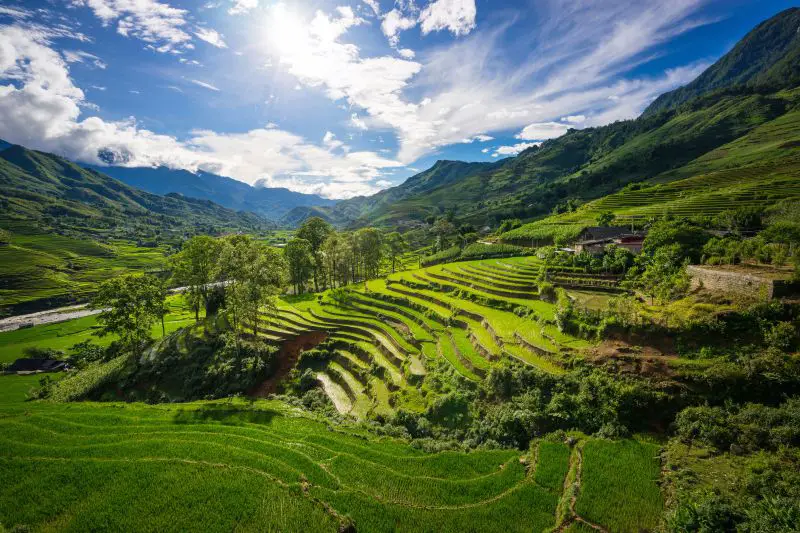
Three days in Sapa, Vietnam is a reasonable amount of time to see the mountainous area in North Vietnam.
This small city is located in Lao Cai, which is about 5 hours northwest of Hanoi, so it’s a fantastic addition to a North Vietnam itinerary or weekend getaway .
Most visitors head to Sapa to enjoy the breathtaking landscape views of the green rice terraces and rice fields, go on bucket list worthy hikes and treks , visit ethnic villages, and escape the large city.
While the main Sapa Town is developed and a bit touristy, there are many incredible things to do in Sapa and the surrounding area. You’ll love your time here, especially the adventure lovers, and won’t want to leave!
In this Sapa 3 days itinerary, we’re providing an easy to follow itinerary on what to do in Sapa, how to get to Sapa, and other helpful travel tips.
Since we love hiking, we’ve included hiking/trekking opportunities and other fun adventurous outdoor activities that you can try. We’ve been to Sapa on two separate occasions and love our experience each time.
Click to jump to certain areas of this Sapa travel guide.
- When to Visit Sapa
How to Get to Sapa
- How to Travel Around Sapa
- Itinerary Day 1
- Itinerary 2 & 3
- Other Places to Visit in Sapa
- Sapa Restaurants
- Sapa Accommodations
Before you check out this 3 days in Sapa itinerary, here are some helpful Vietnam guides to also browse through:
- Why Visit Vietnam
- Fun Things to Try in Vietnam
- Vietnam Travel Apps to Use
*Disclaimer: Traveling to Sapa? This post contains affiliate links. If you click on them and make a purchase, we receive a small commission. There is no additional cost to you. Appreciate the support.
Before arriving in Sapa, it’s recommended to buy a SIM Card at Hanoi Airport (Noi Ba International Airport) or set up a Vietnam eSIM before your arrival . You’ll need to have access to data during your Vietnam travels
For those in the U.S. looking for an international phone plan , consider Google Fi (formerly Google Project Fi). We love this phone plan and have used it since 2016. We get access to data and text in 200+ countries without additional roaming fees, and it works in Vietnam. Learn more and try it for free here.
Best Time to Visit Sapa
With the cooler climate and mountains, Sapa can be visited at any time of the year. The dry season is from October to May and the wet season is from June to September .
If you plan to trek, you may want to avoid the rainy season as the hiking paths are muddy and slippery. Or, just go along for the adventure as rain can happen at any time of the year. You may be lucky and not experience any rain.
If you’re looking for the iconic green and yellow rice terraces , the best time to visit Sapa is from the end of August to the beginning of September. This will be a photogenic time to visit Sapa before the rice harvest begins.
Don’t worry if you’re not able to visit during this time since Sapa is beautiful no matter when you visit !
We traveled to this area in November and the mountains with the rice terraces were still beautiful and green. Although the rice fields were empty, the landscapes were still breathtaking to witness.
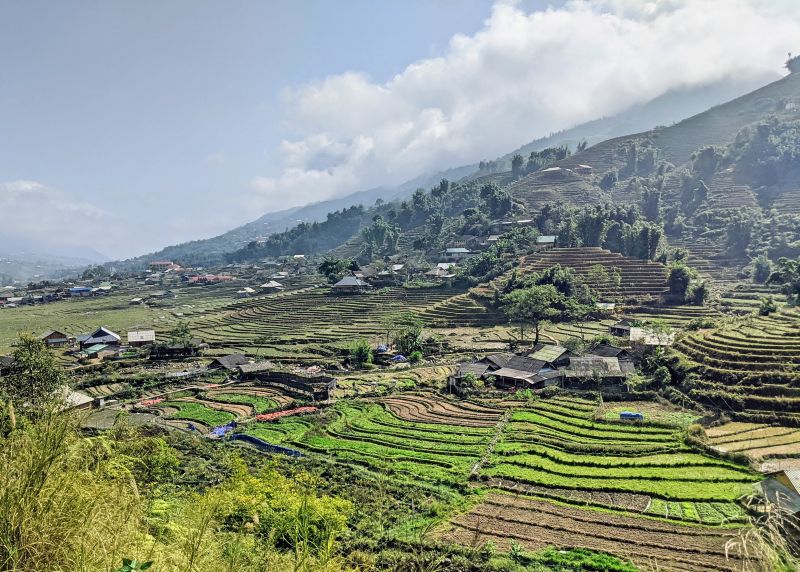
Sapa is beautiful to visit at any time of the year. We visited in November!
Most travelers visit Sapa from Hanoi , Vietnam’s capital.
Since Sapa does not have a domestic airport, visitors must use various transportation options such as sleeper buses, limousine vans, cars, and overnight trains to get to Sapa.
Check out our post on the cheapest and most convenient transportation options from Hanoi to Sapa .
Depending on your budget and the amount of time you have to travel between the cities, the fastest way to get to Sapa from Hanoi is by limousine van, sleeper bus, and private car . Expect to take 6+ hours one way to get to Sapa.
We recommend the luxury sleeper buses where you can have your own cabin and lie down flat.
The longer and more leisurely option is to take the overnight train . As a heads up, the train goes from Hanoi to Lao Cai, and then you’ll need to take a 1 hour bus or taxi from Lao Cai to Sapa.
To return to Hanoi, you’ll need to use the same or different transportation option.
How to Get Around Sapa
Sapa’s main area is small, so you can easily walk around to navigate the side streets and local attractions.
Taxis and motorbike taxis are available if you plan to visit the outskirts of Sapa. You can head to Sun Plaza and grab a taxi in front of the building. Or, you can hail one that is driving around the main town.
In the evenings, cyclos also offer rides around town.
You can also rent a motorbike if you plan to explore the ethnic villages on your own. It’s a cost-effective way to travel around Sapa.
Sapa Itinerary – Day 1: Explore the Town
You finally made it to Sapa from Hanoi!
Depending on your mode of transportation, you’ll arrive in Sapa either early in the morning (6:00am-7:00am) or in the afternoon (around 1:00pm).
Since the long travels may be tiring, we’re taking it easy on your first day in Sapa. After checking into your Sapa accommodation, we’re exploring the main attractions of Sapa town.
1. Wander through the narrow streets of Sapa.
When you arrive in Sapa Town, you’ll notice how touristy it is. It’s not the sleeper town it used to be as the area has been fully developed with hotels and restaurants.
Yet, there are pockets of the town that are quieter . All you need to do is wear comfortable walking shoes and wander around the town.
You’ll see souvenir shops selling teas and trekking gear, shops selling roasted chestnuts and toasted bread made out of chestnuts, and plenty of cafes and restaurants.
Sapa Town does have hills and stairs so you may end up going up or down a steep set of stairs. Or, you can turn around to take the main roads.
Note: Google Maps may not be accurate as the construction of new hotels may have changed the walking paths.
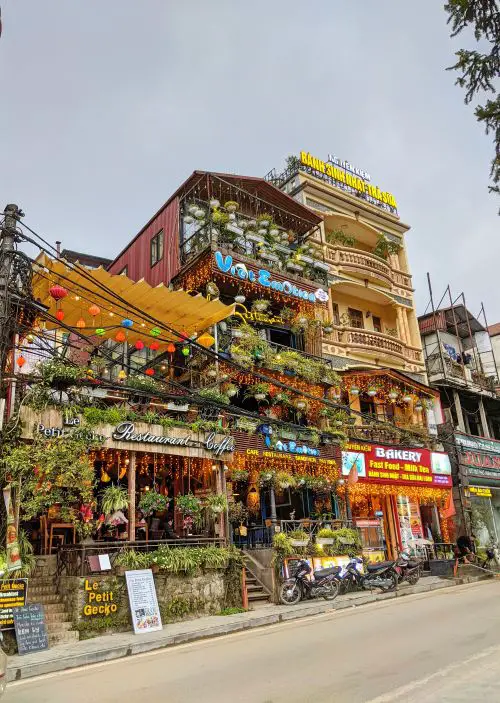
You’ll find lots of cafes and restaurants in Sapa.
2. Walk around Sapa Lake.
Close to the center of town is Sapa Lake. While the lake doesn’t look anything special, it’s a nice way to get some quietness and fresh air.
It’s a calm lake to walk around and you can stop by the cafes nearby.
In the late afternoon/evenings, there is a kiosk selling grilled skewered foods such as seafood and vegetables.
3. Snap a photo in front of Sapa Station/Sun Plaza.
Did the yellow building in the center of Sapa Town catch your eye? It’s the Sapa Plaza which has three levels.
The first floor is the Sapa Station to purchase tickets to Sun World Fansipan Legend and/or take the funicular up Muong Hoa to the Fansipan cable car station .
The second floor is shopping and the third floor has restaurants and a convenience store selling souvenirs, snacks, and drinks.
The Hôtel de la Coupole – MGallery also connects to the Sun Plaza.
As one of the prettiest places in Sapa with the French architectural building and elegant decor inside, it’s no wonder visitors stop here to take photos. You’ll see many visitors take photos in front of the Sapa Station sign/door.
The evenings are also pretty to take photos.
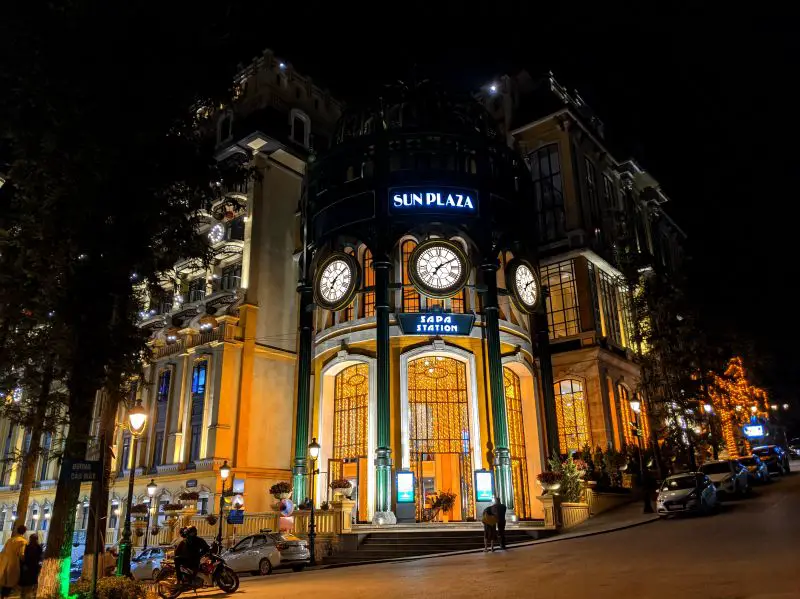
Sapa Plaza is one of the highlights to visit during your 3 days in Sapa. It’s gorgeous in the evenings.
4. Visit the Notre Dame Cathedral.
One of the local attractions to visit in Sapa is the Notre Dame Cathedral . It’s located diagonally from the Sapa Plaza, and you can’t miss the brick construction.
This Catholic church was built in 1895 by the French and still offers services. During our visit, the church had Christmas decorations and lights which brightened the area.
As a heads up, young children sell souvenirs and bracelets in front of the cathedral in the afternoons and evenings.
We suggest that you do not purchase souvenirs from children or take photos of them as they’re most likely not in school and receiving an education.
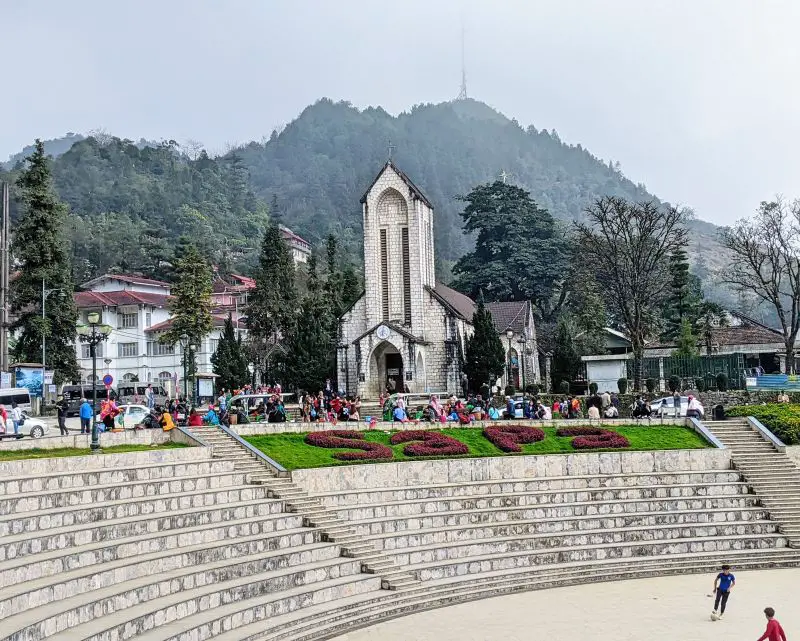
Notre Dame Cathedral is a popular attraction to visit.
5. Take the cable car and visit Sun World Fansipan Legend.
If you have a few extra hours available, consider taking the cable car up to Sun World Fansipan Legend . It’s one of the best Sapa attractions to visit!
You may recognize the name, “Sun World” as it’s one of the large entertainment companies in Vietnam that also produced popular theme parks such as Ba Na Hills and Danang Wonders in Danang .
Fansipan is the highest mountain in Vietnam at 3,143 meters (10,312 feet) and is also the highest in Indochina (Laos, Vietnam, and Cambodia.)
Previously, visitors would trek Fansipan in one or 2 days. (We hiked Fansipan and we’ll share more information about hiking it below).
Since the cable car’s opening in 2016, it now takes about 20 minutes to reach the Fansipan summit and Fansipan attractions, such as pagodas, Great Buddha, Lady Buddha (Guanyin) Statue, and more.
Visitors flock to the Fansipan signage which emphasizes the 3,143 meters. If the weather is clear, you’ll see the views of the Fansipan mountains.
Tip: Wear comfy walking shoes as you’ll walk up the stairs to reach these places.
To take the cable car, you can go to the Fansipan/Hoang Lien cable car station which is a 15-minute drive away from Sapa Town.
Or, take the Muong Hoa funicular from Sapa Station to Hoang Lien cable car station and then take the cable car to Fansipan Mountain. Read more about taking the Fansipan funicular and cable car here .
Save money with your Fansipan Legend cable car tickets here.
6. Visit Sapa Night Markets.
(Currently Closed) The Tinh Night Market ( Chợ Tình Sapa in Vietnamese) is located next to the Sapa Plaza and is an opportunity to buy souvenirs such as handmade handbags, bracelets, jewelry, and more. It’s an opportunity to support female vendors as they make their products. The Night Market opens after 7:00pm.
There is another market, Sapa Market ( Chợ đêm Sapa ) that is 1.4 kilometers (.87 miles) away from Tinh Night Market. It’s recommended to take a taxi or you can take a stroll over to get there.
We passed by this place as we entered Sapa from Lao Cai City. It’s more of wholesale buying of goods and products.
Sapa Itinerary – Day 2 & 3: Trekking
On your second and third day in Sapa, it’s recommended to go on a trek to explore the iconic rice terraces and landscapes.
You’ll also get the chance to smell the crispy, fresh air and visit ethnic villages to meet the ethnic minority people and see how their lifestyles are.
In Sapa, there are five main ethnic Hmong, Dao, Xa Pho, Tay, and/or Day people. About half of the ethnic minority people are Hmong.
We recommend that you do a 2 days trek with a 1 night at a homestay at a local family’s house . You can also do day trips if you prefer to not trek as long each day.
Choose from a variety of treks such as visiting Cat Cat Village to Y Linh Ho, Sa Sen to Hau Thao, Lao Chai to Ta Van Village , and Ma Tra to Ta Phin Village .
We highly recommend the trek from Sapa Town to Lao Chai and Ta Van Village. It’s a tranquil walk through rice terraces and the opportunity to see breathtaking views of the valley.
The trek isn’t too difficult as it’s mostly flat with some hills on paved and dirt paths. You’ll also get the chance to see a secret waterfall on the second day.
Check out our experience of the 2 day trek to Lao Chai and Ta Van Village here.
The daily treks include a local guide, water bottle, and meals (the number of meals depends on how many days you’re trekking).
Recommendation for the trekking guide: Zaazaa from Zaazaa Trekking – We loved trekking with Zaazaa and you won’t be disappointed with her services. She is highly recommended as she is easy to work with and can tailor your trek as needed. We trekked with her twice on two different trips and loved the routes.
Don’t forget to pack hiking boots and hiking clothes. Hiking boots are necessary since you’ll walk through rice fields and they are muddy.
Check out our Sapa trekking guide for helpful tips on how to prepare for a trek and how to choose a trekking guide.
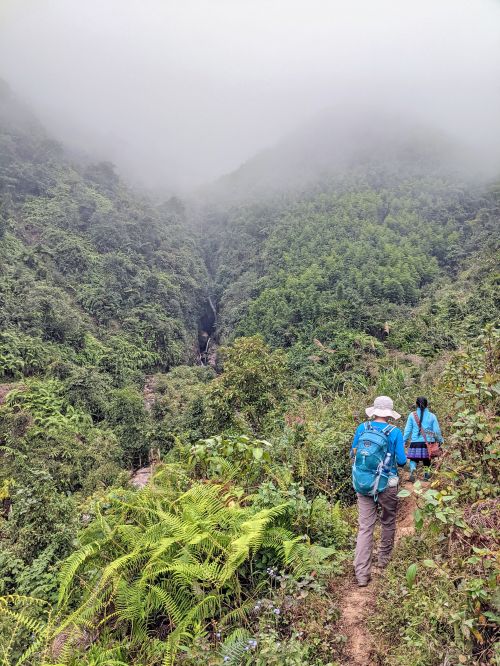
Trekking in Sapa is a must-do activity.
Sapa Itinerary – Other Places to Visit in Sapa
Sapa deserves at least 5 days of exploring if you have the time. If you have 4+ days in Sapa, add these other fun places to visit to extend your stay.
Climb Mount Fansipan.
We mentioned that you can take the cable car to go to the Fansipan summit.
If you’re the adventurous type , try trekking Fansipan in 1 or 2 days. The challenging trek will push your body to climb the tallest mountain in Vietnam. The forest area is quiet and serene and you’ll encounter only a handful of other hikers on the trail.
We hiked Fansipan in 1 day and it was pretty tough mentally and physically. Yet, it was such an accomplishment to reach the highest point of 3,143 meters (10,312 feet).
Tip: Plan for this Fansipan trek on the first day of your Sapa itinerary and then go on your Sapa trek to ethnic villages for the rest of your itinerary. The Sapa trek is “easier” and will give your legs and knees the much-needed rest and recovery.
If you hike in 2 days, you’ll stay overnight at a campsite. The trek includes a chef and porters so everything will be set up at your campsite.
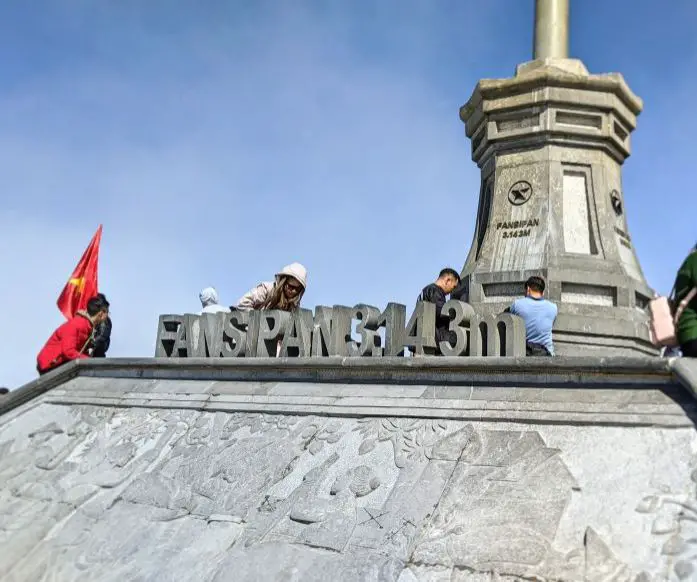
Trekking Mount Fansipan is a challenging activity to add to your Sapa itinerary.
Visit the Love & Silver Waterfalls.
If you’re a waterfall chaser, then add these two Vietnam waterfalls – Love and Silver Waterfalls to the bucket list.
Love Waterfall ( Suối Vàng Thác Tình Yêu in Vietnamese) requires a short 20-30 minutes of easy walking to reach the waterfall. The waterfall has a height of 100 meters.
Visitors love seeing this waterfall surrounded by the luscious forest area of Hoang Lien National Park .
This waterfall is near the Tram Tom entrance to trek Fansipan, so you could combine a visit if you’re a fast hiker.
For an exhilarating experience in Sapa, you can also go canyoning off Love Waterfall.
Read more about our Love Watefall experience here.
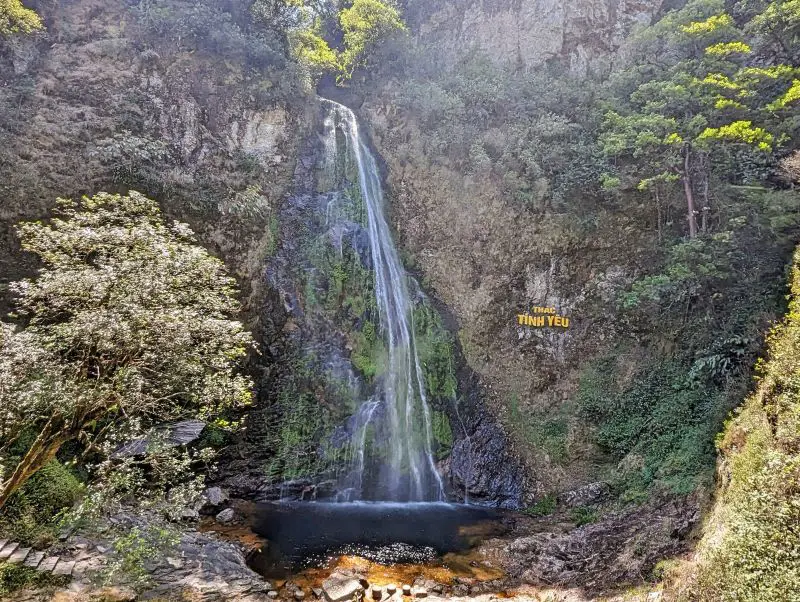
Silver Waterfall ( Thác Bạc in Vietnamese) has waterfall cascades that are over 100 meters high. It’s easy to get to as it’s located off the main highway. Follow the walking path and stairways to see the Silver Waterfall up close.
Read about what to expect when visiting Silver Waterfall here.
To see both Love and Silver Waterfall in one day, check out this private tour option.
Visit Bac Ha Market on Sundays.
One of the unique attractions to visit in Lao Cai is the Bac Ha Market ( Chợ Văn hóa Bắc Hà ).
It’s the largest market where ethnic minorities sell their colorful handicrafts and goods . Plus, it’s a picturesque place as you’ll see people in their colorful traditional outfits.
Since this market is only open on Sundays, it gets crowded with tourists.
But you can also visit on Saturdays to see the horses and buffaloes for sale. It was originally on Sundays but too crowded.
You’ll need to organize a tour, hire a taxi, or drive a motorbike to get to this market as it’s about 2.5 hours one-way from Sapa.
Read our Bac Ha Market guide to learn more.
Explore sapa heaven’s gate at o quy ho..
If you want more fresh air in Sapa, consider visiting Sapa’s Heaven Gate ( Khu Du Lịch Cổng Trời Ô Quy Hồ in Vietnamese).
This tourist area has lovely views of the mountain pass of O Quy Ho, picturesque sceneries, and its own version of Bali’s Pura Lempuyang gates.
The highest point at this tourist spot is 2,035 meters (6,675 feet), so you can take a photo with the triangular landmark that highlights the height above sea level.
Read our experience with Sapa’s Heaven Gate here.
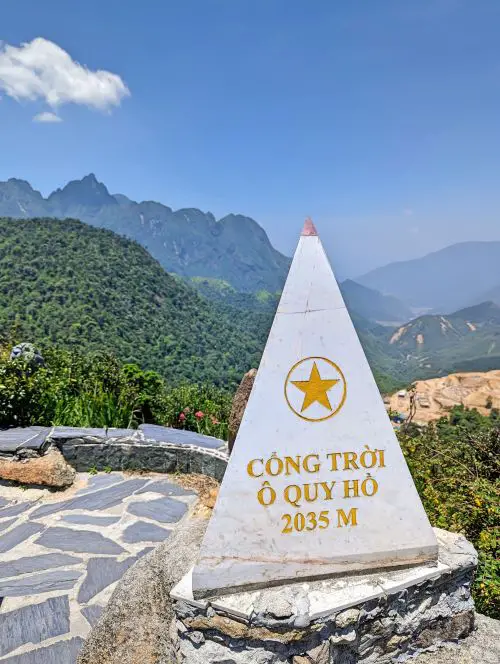
Where to Eat in Sapa
Considering that Sapa Town isn’t large, there are plenty of restaurants to choose from. Choose from Vietnamese to Western-style food. Expect to pay around 130,000-200,000 VND ($5.60-$8.60 USD) for a dish. Most restaurants are cash-only.
Popular Vietnamese foods to try in Sapa include salmon (which tastes more like trout since it’s leaner), sturgeon, dried buffalo, horse meat, and sticky rice in a bamboo stick.
One thing that we noticed was that many of the successful restaurants get copied, whether it’s the name or the items that they sell. We saw four hot pot restaurants next to each other on the main road, Ngu Chi Son Road.
Also, Muong Hoa Road has many sellers located only a few feet away from each other grilling sweet potato, corn, and other snack items in the evenings.
Here are some of the Sapa restaurants that we tried and enjoyed. We followed the trend of visiting restaurants with “Good Morning” in the name.
Good Morning Vietnam – Located off Fansipan Street, this restaurant has some delicious Vietnamese cuisine.
We ordered sizzling deer and a sizzling salmon plate. The salmon had a sweet teriyaki sauce which was highly addicting. Both dishes were delicious and our clothes smelled like the sizzling platter afterward.
If you need more rice, feel free to ask for extra.
Address: 63B Fansipan, street, Sa Pa, Lào Cai
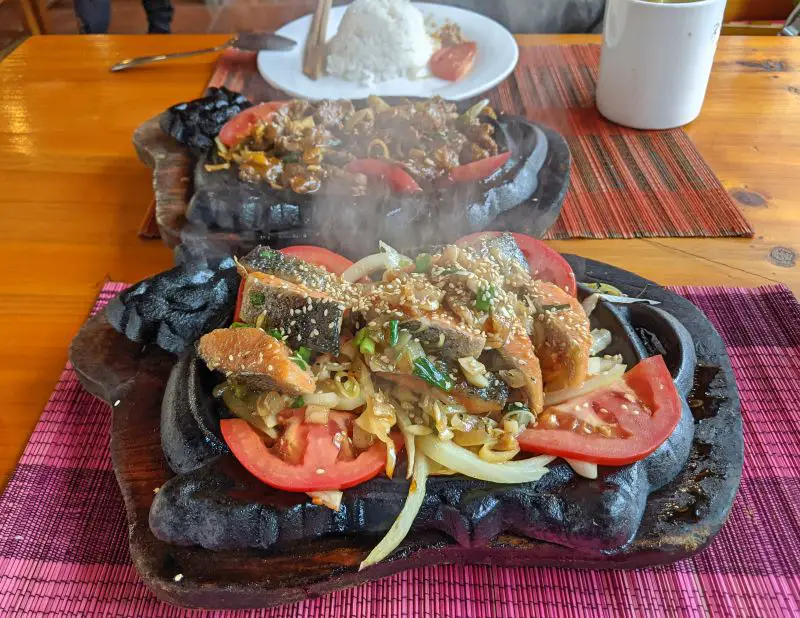
Try these mouthwatering foods at Good Morning Restaurant.
Good Morning View Restaurant – This restaurant is in the quieter part of Muong Hoa. During lunchtime, this place advertises beef noodle soup. We came for dinner and ate some delicious food.
Try the refreshing papaya salad and salmon spring rolls as appetizers. We loved the salmon spring rolls since it was also stuffed with dried wood ear mushrooms, carrots, and other vegetables.
The sizzling sturgeon platter and trout in banana leaf are also tasty main dishes. The sturgeon was interesting since it has a curry flavor. You can also ask for more rice if needed.
Address: 047 Mường Hoa, TT. Sa Pa, Sa Pa, Lào Cai 333100
Good Morning Sapa – We were impressed with the number of salmon dishes offered at this place.
The sizzling salmon with peppercorn platter is a winner and the sauce was finger-licking good.
We also had a platter of mixed vegetables and a bowl of shrimp coconut curry.
Unfortunately, the curry didn’t come inside a coconut. It also had a more Japanese-ish flavor and a slight sweetness from the coconut milk.
On the weekends, this restaurant also offers BBQ skewered foods such as fish balls and vegetables. You can pick some up as a snack on your way to and from the main town.
Address: 014 Mường Hoa, TT. Sa Pa, Sa Pa, Lào Cai
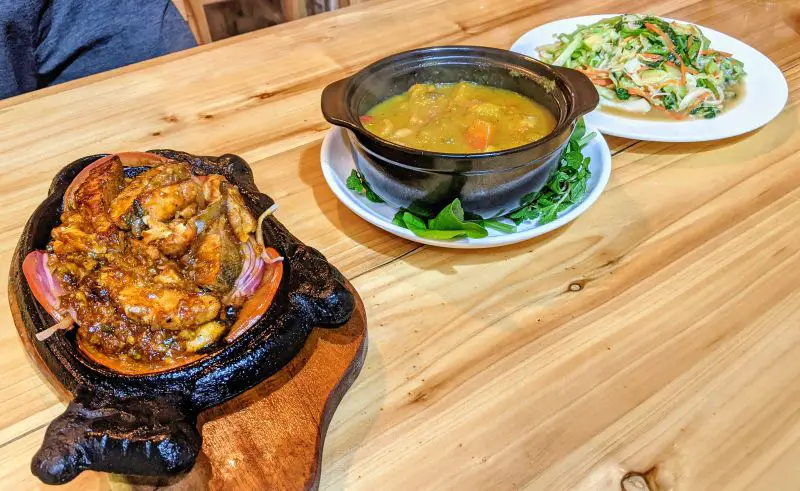
Good Morning Sapa is a delicious spot to try when you’re in Sapa.
Where to Stay in Sapa
Due to Sapa’s increase in tourism, there are hotels and guesthouses everywhere in the main city center. You can get a room at a reasonable price of $30 USD per night for 2 person occupancy.
There are also luxury eco-hotels available that are outside of the city and will require transportation.
Check out Sapa accommodation options here on Booking.
Click to check pricing and availability on Agoda.
Here are two budget-friendly Sapa accommodations that we stayed at:
My Boutique Hotel and Spa – This boutique hotel is one of the best places to stay in Sapa!
The location is about a 10-minute walk away from the Sapa Plaza and is quieter. The rooms are chic and have beautiful furniture and decor. The bathrooms also have a separate tub and shower.
You may never want to leave the room since the bed is way too comfortable and so cozy, especially on a cold night.
We opted to not have breakfast included in the meal as there are restaurants along the street to find something to eat. The cost per night starts at $38 for a 2 person occupancy.
Reserve a room at My Boutique Hotel here on Booking.
Check pricing and availability on Agoda here.
Address: 55 Mường Hoa, TT. Sa Pa, Sa Pa, Lào Cai
Sapa Relax Hotel and Spa – The central location of this hotel is one of the reasons to stay here.
You’re only a few minutes walk from the Sapa Plaza and can see the building outside of the hotel entrance.
The rooms are large and comfortable. Breakfast is included in the room cost and consists of a buffet line of stir-fried noodles, fried rice, vegetables, sausages, eggs, and made to order noodle soup. The cost per night starts at $28 for 2 people.
Reserve a room at Sapa Relax Hotel here.
Check pricing and availability for Sapa Relax on Agoda here.
Address: 19A Đông Lợi, TT. Sa Pa, Sa Pa, Lào Cai
Prefer the luxury accommodation options in Sapa ? Check out Topas Ecolodge , Topas Riverside Lodge , and Sapa Clay House .
These are popular eco-friendly and luxurious places that overlook the mountainous region. They have an in-house restaurant and swimming pool. Expect to pay $130-$500+ per night for a room with 2 person occupancy.
On a return visit to Sapa, we’ll try one of these places as they have positive reviews and are highly recommended in the Ho Chi Minh City Expat Facebook groups.
Final Thoughts
It’s time to say goodbye to your fun three days in Sapa. It’s one of the most beautiful places to visit in Vietnam and you won’t regret visiting here.
We hope you enjoyed this itinerary and are inspired to plan your Sapa trip in the future.
If you need more tips on planning a trip to Vietnam, check out our posts below:
- Things to Know Before Visiting Vietnam
- How to Apply for a Vietnam e-Visa
- Explore Vietnam in 7 Days & Different Itinerary Ideas
Which places are you the most excited to visit in Sapa? If you have other questions, ask in the comment box below.
Like this post? Save it to your Vietnam Pinterest board!
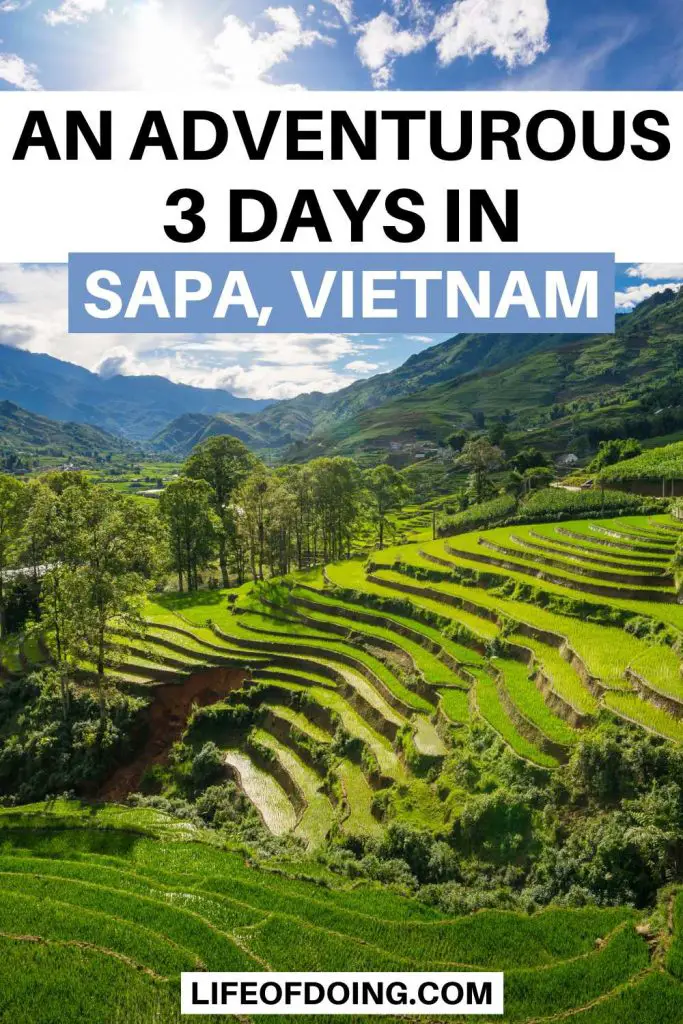
Featured photo credit: empty_vectorist via Depositphotos.com
I'm Jackie - world explorer, hiker, and wanderer. I love planning things whether it is a trip or an upcoming event, exploring nature, hiking up mountains, and seeing new places. I'm notorious for getting lost, so you may see me circling a place a few times.
Sapa Trekking Guide: How to Prepare for Epic Treks in Sapa, Vietnam
Wander through bong lai valley in phong nha, vietnam by bicycle or motorbike, you may also like, how to travel from ipoh to penang georgetown..., 18 must try places to eat in penang’s..., a step by step guide on taking the..., exploring melaka, malaysia in one day – a..., hiking moongate station 5 in penang, malaysia, indonesia’s top 5 scuba diving spots to not..., 11 must have apps for traveling in malaysia, where to go in bali: the best 8..., 16 things to know before visiting ipoh, malaysia, visiting qing xin ling leisure & cultural village....
Sapa is high up on my bucket list! I had no idea it was an actual town because you pretty much only see rice terrace pictures when looking up Sapa! Very cool read. So excited to get to go one day.
Thanks Linda! Sapa is such a pretty area to take photos. I know you’ll love your experience here.
What a gorgeous place!!
Hi Kristina. Sapa is too beautiful! We know you’ll love visiting in the future!
Leave a Comment Cancel Reply
Save my name, email, and website in this browser for the next time I comment.
By submitting a comment, you agree with the storage and handling of your data by this website. Refer to the Privacy Policy and Disclaimer for more information. *
This site uses Akismet to reduce spam. Learn how your comment data is processed .
This website uses cookies to improve your experience. Please accept or opt-out if you wish. Accept Read More

What is the Best Time to Visit Sapa? Recommendation from Local View
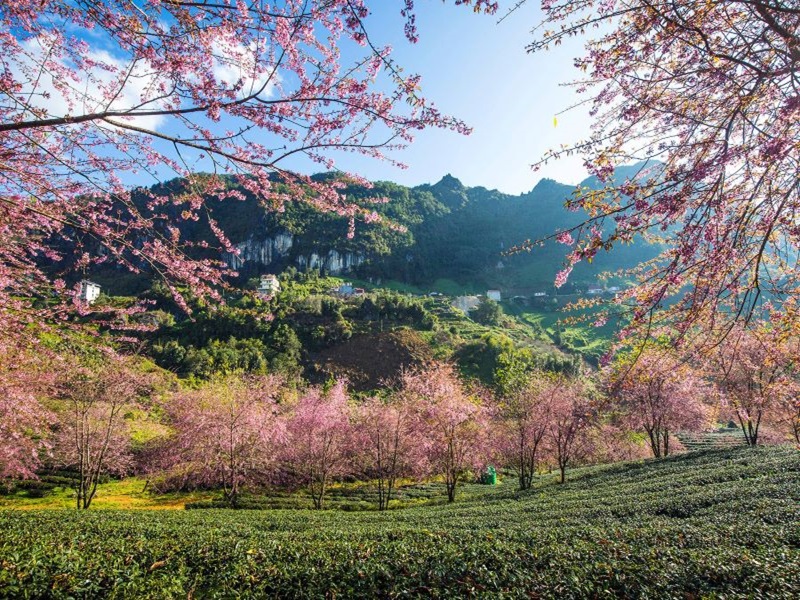
Best time to visit Sapa: A comprehensive guide for first-time visitors
Are you considering a trip to Sapa but are unsure of the ideal time to go there? You should definitely consider that factor since it can have a significant impact on your experience. There are months when there are gorgeous rice fields, months when it rains a lot, and months when it is really cold. Therefore, it’s crucial to be aware of Sapa’s weather before visiting to make sure you pack appropriately and know what to expect. Below is all you need to know!
You may like to read more:
- Best Hanoi Day Trip to Sapa – A Complete Guide for your Amazing Trip
- How Many Days Are Enough for Sapa Viet Nam?
- Best Things To Do in Sapa For First-Timers
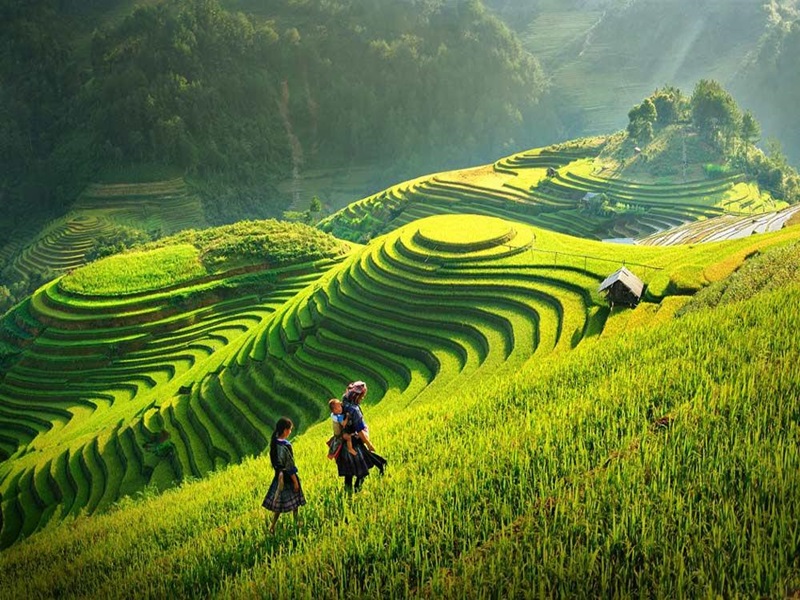
March through May and September through November are the ideal times to visit Sapa, with September being the most favorable month. This is the month when the terraced fields are completely coated in a stunning golden color and the rice is ready to be harvested. In April and May, locals cultivate rice on terraced fields. When viewed from a distance, the terraced fields create a picturesque scene of natural beauty, attracting tourists to stop and take in the sight.
Table of Contents
Summary of Sapa’s weather
- From March to May: Warm and dry weather, perfect for outdoor activities, especially trekking
- From June to August: High season for domestic tourism and heavy precipitation
- From September to November: Dry and cool weather, perfect for photography and trekking
- From December to February: Cold winter and low season for tourism
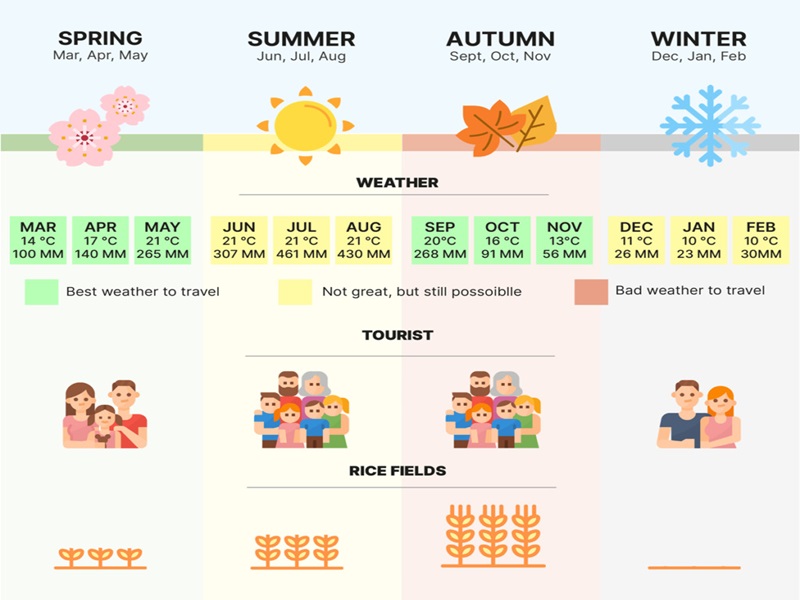
Spring in Sapa – From March to May
Spring comes from early March to late May. Following a cold winter, the weather in Sapa gets warmer and more pleasant. Trekking is most ideal during this season since the scenery looks greener than in other seasons. While trekking in the mountains with ideal temperatures – neither too hot nor too cold, you also can take in breathtaking natural beauty, enjoy the blue sky and have a great opportunity to take many beautiful pictures.
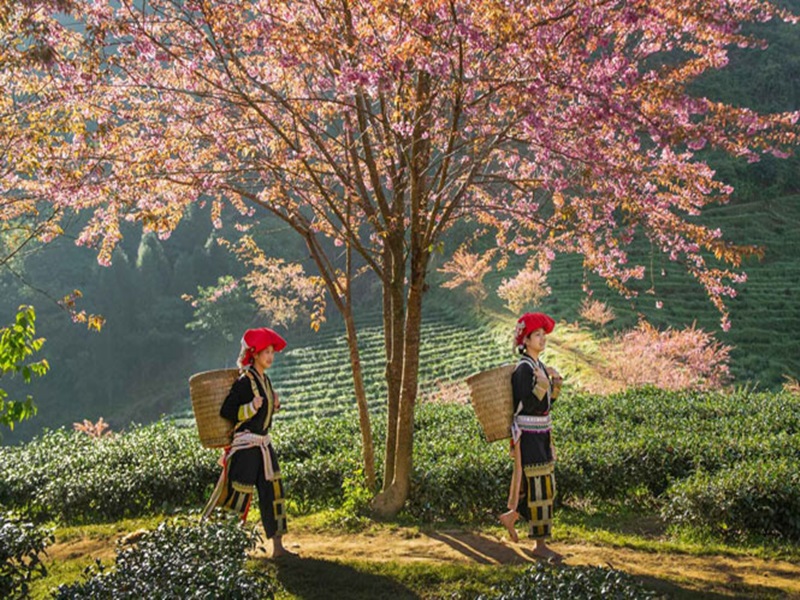
In addition to beautiful weather and lush green landscapes, this is also the peach blossom season. You can see many white and pink flowers in bloom all across the road, the field, and the garden when visiting Sapa during this time.
>>> If you’d like a FREE itinerary tailored to your needs by a knowledgeable travel advisor, Don’t hesitate to contact us for 24/7 help. HOTLINE/WHAT’S APP: + 84 974 805 797 or + 84 914 815 535

Summer in Sapa – From June to August
June, July, and August are summer months and can be extremely hot. Also, it can rain heavily almost every day. An hour-long downpour is so intense that it swiftly converts roads and walkways into muddy trails. Heat and rain make trekking in Sapa not very pleasant.
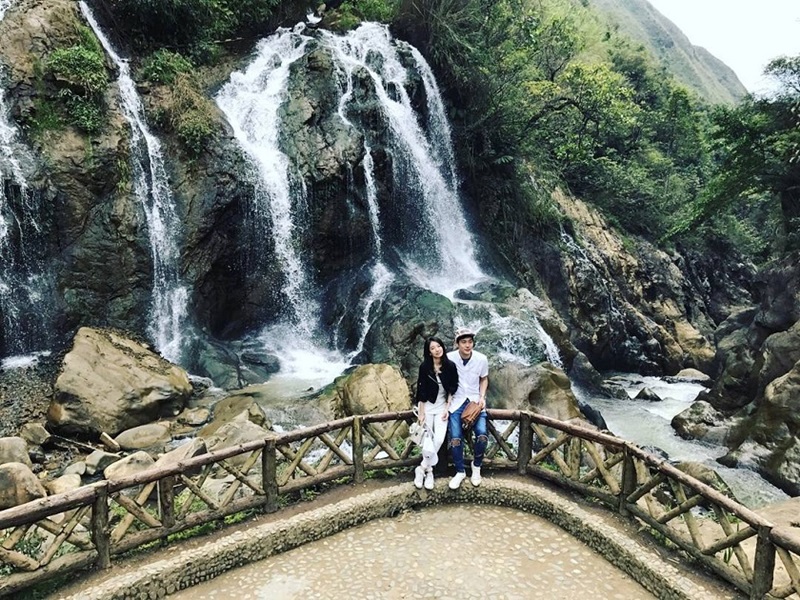
That being said, the summer months bring with them an abundance of greenery, including rice fields. Large volumes of water cascading down the mountains make Sapa’s waterfalls particularly stunning during and right after the rainy season. Thus, you may still take in the breathtaking surroundings when traveling in the summer.
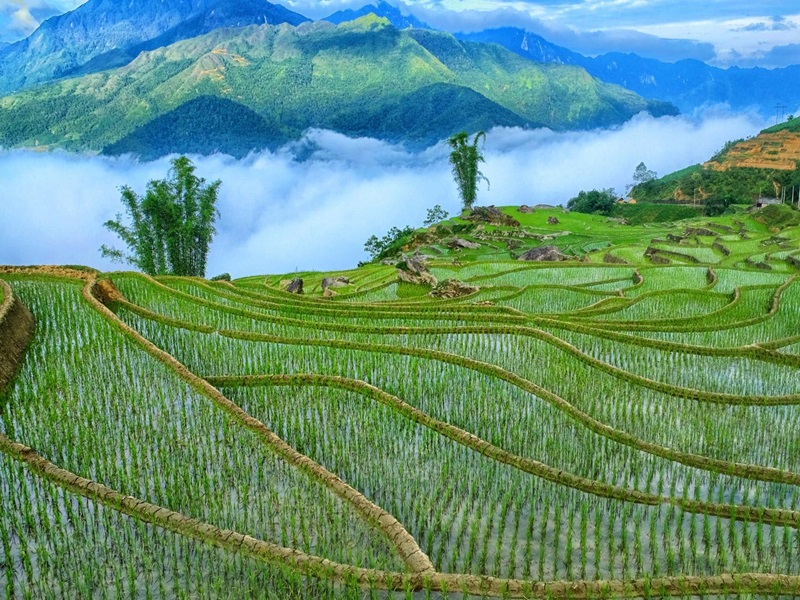
Even though the summer is not the best time to visit Sapa, there are some days when the town grows busier, especially on weekends. Many Vietnamese choose to travel to Sapa during the summer period as their children are off from school.
This is more for you:
- Best Sapa Itineraries
- Best Sapa Package Tour
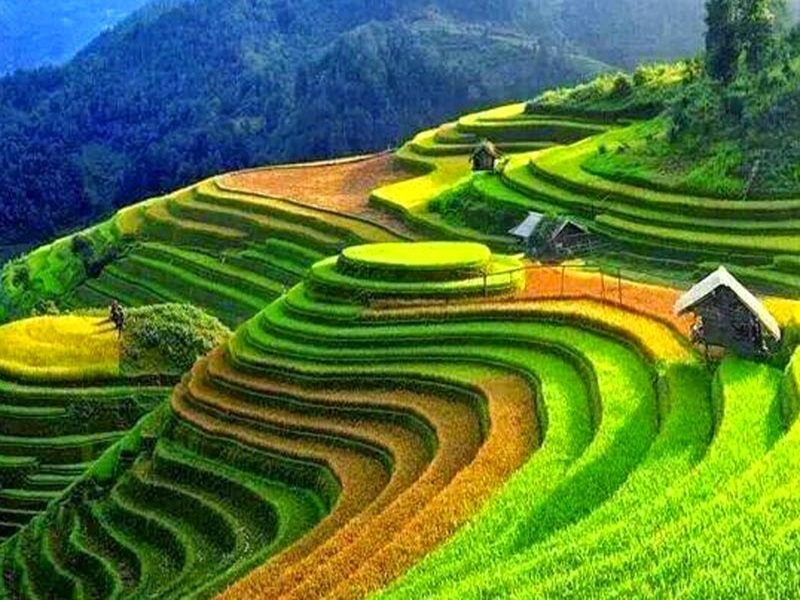
Fall in Sapa – From September to November
September brings with it a decreasing amount of rain, making trekking and traveling easier and more enjoyable. The summer heat eventually passes, even if it is still rather warm during the day.
The months of September and October also coincide with the harvest season. At this time of year, Sapa’s rice fields are at their most picturesque. The view is simply magnificent, with golden rice fields winding across the mountains like golden ribbons. This makes fall the best time to visit Sapa.

The ideal trekking weather returns around the end of October and November as the days become milder and the nights become colder. In addition, the road is easier and safer for a motorbike tour.
>>> Read more: Sapa Trekking: Best Tips, Routes, to Have Your Amazing Trip!
Winter in Sapa – From December to February
Winter begins in November and lasts until the end of February as the days get progressively colder.
While January and December are the coldest months of the year, November is still a lovely time of year to visit Sapa. It could even snow during this time of year, and the temperature could drop below freezing. This is not the ideal time of year to trek Sapa because of the cold weather and deserted rice fields. If you plan to go trekking, remember to bring suitable clothing. You also should keep in mind that not all homestays in Sapa, especially the more basic ones, have good heating systems, so it can get very cold.
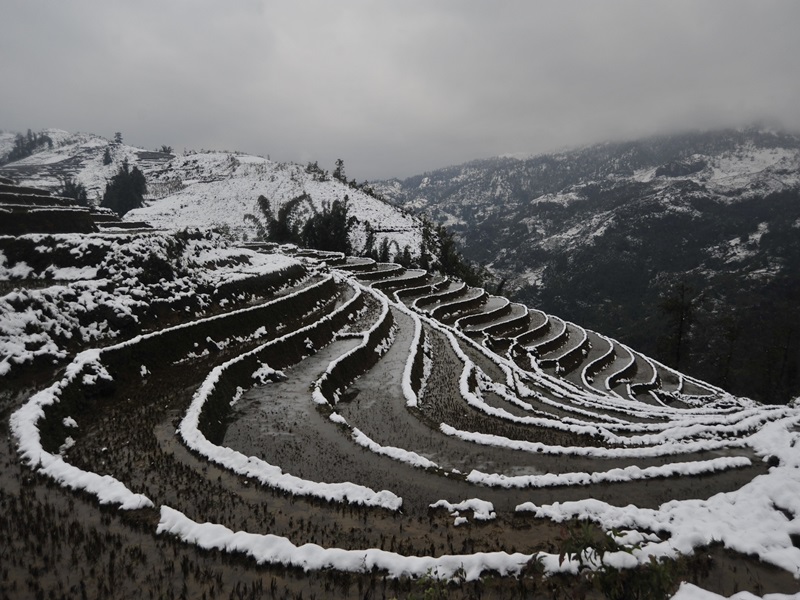
In the event that it doesn’t snow, there’s still a potential of rain, which might make the trekking path muddy and challenging to navigate. There’s another difference: winter brings thick fog, which is why the mountains are blanketed in clouds. It can create some stunning landscapes, but may obstruct your view of the distinctive surroundings. The weather slowly clears up and the temperature rises somewhat starting in February.
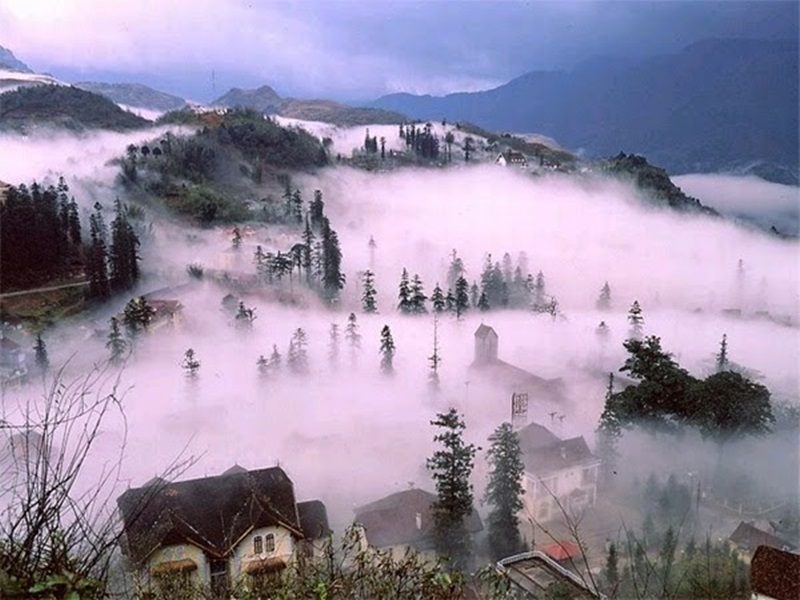
Best time to visit Sapa rice fields
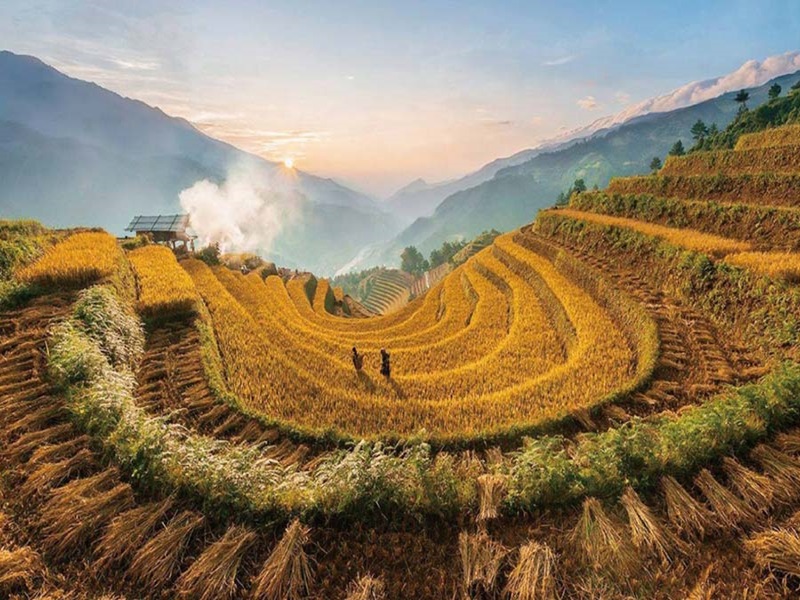
The harvested season – From September to Early October
This is the most beautiful time to visit Sapa, because during the harvest season, the rice fields winding along the mountain range like a ribbon turn yellow. Trekking from village to village is the greatest way to see them.
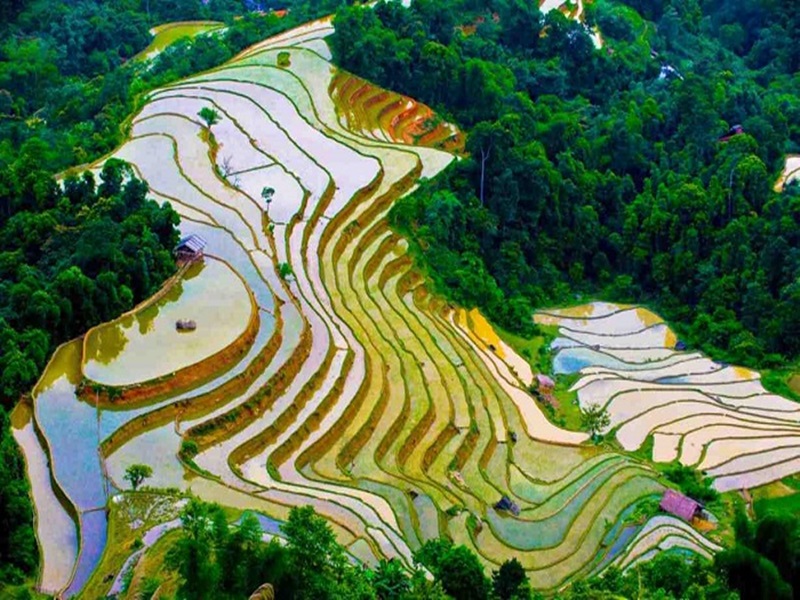
Watering season in Sapa
In Sapa, the watering season runs from April to early May when the terrace fields are being flooded to prepare for sowing. During this season, the rice fields become enormous mirrors that reflect the sky and mountains. For photographers, the best time to visit Sapa is after harvest season.
The essential information about Sapa weather and the best time to visit Sapa for your trip is provided above. May your journey be filled with joy and safety! Please get in touch with the Hanoi Explore Travel team if you need any more assistance with your Sapa trip schedule.

RELATED Post

Thac Bac Waterfall Sapa: A must-see attraction in Sapa
Thac Bac Waterfall Sapa – A majestic beauty for nature lovers Thac Bac Waterfall, or Silver Waterfall in Sapa, Lao Cai province is considered one of the most beautiful and well-known waterfalls in Vietnam. This is also one of the tourist attractions that draw the greatest number of tourists in Sapa every summer. Let’s join […]

O Quy Ho Pass: A Beautiful scenic spot in Sapa Vietnam
O Quy Ho Pass: One of the most beautiful passes in the Northwest During your journey to Sapa, O Quy Ho Pass is a well-liked and well-known site that draws lots of travelers seeking adventure and stunning scenery. Driving across the pass will allow you to take in the breathtaking beauty of Sapa, complete with […]

Sapa Glass Bridge – Complete travel guide for your trip in Sapa!
What makes Rong May Glass Bridge near Sapa so appealing? Sapa Glass Bridge has become a popular tourist attraction in Sapa. The bridge has been open to tourists for a few years, but it draws tens of thousands of visitors every month. This is a stunning check-in location with lots of thrilling games to try. […]

Sapa Heaven Gate – Paradise in the clouds
Heaven’s Gate Sapa: A most interesting place for cloud hunting in Vietnam Explore the amazing beauty of Sapa Heaven Gate – a breathtaking pass in the center of Sapa, Vietnam Sapa Heaven’s Gate, a remarkable destination for individuals seeking comfort in the embrace of nature, draws a sizable influx of foreign visitors with its enchanting […]

Sapa rice fields: A natural masterpiece capturing people’s hearts
Rice terraced fields in Sapa: Comprehensive guide for first-time visitors to Sapa Sapa is a must-see destination for anyone planning a trip to Northern Vietnam. Don’t miss the Sapa rice fields, which offer a charming and poetic view of terraced fields, when you visit Sapa, the most well-known town in Northwest Vietnam. These captivating landscapes […]

How to get from Hanoi to Sapa? Tips to choice a Best Transportation Option!
How to get from Hanoi to Sapa and advice for the greatest travel experience How to get from Hanoi to Sapa is a common question of many tourists when they plan to visit Sapa. The north of Vietnam is completely different from the rest of the country and Sapa is a must-see when you explore […]

Muong Hoa Sapa Valley: Explore Hidden Eden in Northwest Vietnam
Muong Hoa Valley in Sapa: Hidden Eden in Northwest Vietnam Muong Hoa Valley is one of the most popular tourist attractions in Sapa, particularly for travelers who enjoy an exciting experience. Coming here, tourists will be enthralled by the alluring splendor of this valley, which is also the home to many minority groups and breathtaking […]
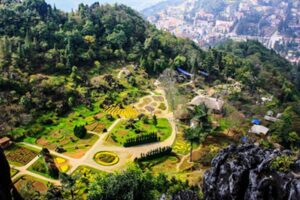
Ham Rong Mountain Sapa: All You Need To Know
Ham Rong Mountain – Sapa: A perfect location for admiring stunning scenery above the clouds Having a charming beauty with magical mists, Sapa is akin to a splendid and beautiful feng shui picture. And Ham Rong Mountain is one of the most wonderful places in Sapa that you should not miss! Discover the legends and […]

Trekking In Sapa, Vietnam: What To Know About Staying With Vietnam's Friendly Mountain Minorities
Quick links, why trekking in vietnam's sapa is a must, sapa - the home of timeless vietnam minority groups, what to know about trekking in sapa packages.
Vietnam is a country of countless wonders - it has everything from mystical bays (like Ha Long Bay) , to pristine tropical beaches (like Phu Quoc) , to bustling night markets, to timeless mountain villages and rice fields. One of the many excellent places to visit is the northern remote mountainous town of Sapa (also spelled Sa Pa).
Sapa is a famous tourist destination to see the mountainous rice fields and the traditional way of life of Vietnam's ethnic minorities. Visitors get to see a bamboo forest and some of the most picture-perfect landscapes in Southeast Asia . But one of the main attractions is seeing the friendly local minority groups going about their daily lives in a world where little has changed over thousands of years (even if they now have mopeds, phones, Wifi, and some mechanical machines in aiding farming).
Sapa is the main gateway town of the region (it has a population of around 60,000). The region around Sapa is protected in the Hoàng Liên National Park. This region is dramatic and includes metamorphose sediments with granitic intrusions. The valleys are densely inhabited, and the mountainsides are extensively terraced and cultivated. The Hoang Lien Mountains here mark the southeastern extent of the wider Himalayan chain formed from the collision of the Indian subcontinent with Asia.
Many of the mountainsides are impossibly steep and inaccessible. The region is arguably one of the most dramatic and rewarding to visit in all of Vietnam.
Most of the land here is above 1,000 meters (3,000 feet) above sea level and even though it is tropical, it can get chilly. It is not uncommon for clouds to descend around the town and villages and drizzle - so take some warm clothes regardless of how stifling hot the capital, Hanoi, may be. The main town of Sapa is 1,500 meters, 4,900 feet above sea level (it can even snow during the winter). There are 160 days of mist annually - so visitors may be greeted by clear blue skies lighting up the valleys or they may be greeted by misty days that make the valleys feel mysterious and unknown.
Sapa is located in the far north of Vietnam, close to the border with China, and includes Vietnam's highest peak - Fan Si Pan - which rises to 3,143 meters or 10,300 feet above sea level.
Related: See Vietnam's Ancient Angkor Wat Hindu Temples At "My Son"
The traditional ethnic minorities that inhabit the mountains and valleys around Sapa include the Hmong, Dao (Yao), Giay, Xa Pho, and Tay. Of these, the main minority groups of the area as the Hmong (52%) and the Dao (25%). The stable food in the valleys here is rice and corn.
Visitors see the villagers (mostly the men) tending to the terraced mountainsides and rice fields - often with water buffalo, just as they have done for thousands of years. The tourists are led in groups along the mountain trails through the villages and farmers' fields, normally by the women. The women generally dress in their traditional clothes and entertain the tourists. They also make a range of traditional crafts (like bracelets, earrings, and clothes) to sell to tourists.
The villages around Sapa are very poor, and the tourists are appreciated as one of the very few ways for the villagers to make at least a few dollars. Don't be overwhelmed if a whole group of people presses with their wares after showing some interest in someone else's wares. This is the perfect time for tourists to practice their haggling skills.
Related: Going To Vietnam? Book A Tour Of Ba Be National Park
Guided all-inclusive packages (except for drinks) are offered by many travel agencies in the capital of Hanoi. The tour package includes pick up from one's hotel with a sleeper bus and travel to Sapa. From there, visitors are picked up by their local tour guide (likely an English-speaking woman from the village), who then guides the group through the mountain trails to her village, where they spend the night in a village guesthouse. The trekking for the day is normally around four hours.
- Cost: $25-40 Per Person Per Day
Generally, tourists leave the bulk of their belongings in a hotel in Sapa and only take a day bag with what they need for the one or two, or three days of trekking in the villages. Two days of trekking (and one night) is generally a good amount of time to get the feel of the valley and area.
Tourists can choose to take a guided tour or just go and explore by themselves, but if it is one's first time, a guided tour is probably the best option. Regardless, Vietnam is a great first-time-friendly destination to visit in Southeast Asia .


IMAGES
VIDEO
COMMENTS
4. Trek in Sapa Highlights: With dramatic landscapes, Sapa has been attracting trekkers for more than 30 years. As an undiscovered paradise for intrepid explorers, trekking in Sapa is a must-do activity when you visit this mountainous area. It is a challenging but incredible experience when you trek through the green paddy field and the world ...
Suggested tours: Sapa: 2-Day Trekking Tour with Minority Village Homestay. From Sapa: Sapa Valley Trek with Local Villages Visit (5 hour tour) 2. Visit Sapa Museum. Source: Diggers2004 / Wikimedia. Sapa Museum. Sapa doesn't have too many 'attractions' in the main town but one of the few it does have is the Sapa Museum.
1. Fansipan Mountain. Fansipan is one of the most beautiful attractions in Sapa, It is the peak of Indochina with the elevation of 3143m. 2. Muong Hoa Valley. Spread over 4 kilometers length, 2 kilometers width with at least 159 stones, Muong Hoa have mysterious graphics. 3.
Below are the top 15 attractions you should visit in Sapa. Table of Contents [ show] 1. Muong Hoa Valley. Located just over 6 miles (10 kilometers) from Sapa, the emerald green Muong Hoa Valley (Thung Lũng Mường Hoa) features some of the most breathtakingly picturesque landscapes in Vietnam.
Sapa Weather. The best time to visit Sapa is in September and October when the rice terraces are at their most splendid; or in April and May when the weather is ideal and skies are clear. For those who don't mind hot weather, June to August is a fine time to visit. Expect chilly weather from November to March.
Trekking in Sapa, therefore, is a must-do activity when you visit this mountainous area, which is regarded as an undiscovered paradise for adventurous travelers. You can walk through lush rice fields and visit the communities of ethnic minorities around the town, which is a challenging but fascinating experience. Trekking on rice fields.
The road between Sapa and Lai Chau crosses the Tram Ton Pass on the northern side of Mt Fansipan, 15km from Sapa. At 1900m it's Vietnam's highest mountain….
Sapa Weather by month. December to February: These are the coldest months, with the average temperatures being around 13°C with highs close to 18°C and lows dropping to around 10°C. It does snow in Sapa, on average the city will see 1-4 snow days per year, however, 2017 and 2018 did not have any snow.
Đường Lên, TT. Sa Pa, Sa Pa, Lào Cai, Vietnam. The Ham Rong Mountain trail is the most easily-accessible trek from Sapa town. The name comes from the shape of some of its cliffs, which reminded locals of a dragon's head ("ham rong" in the local language). Set aside five to six hours to climb to the top.
By Bus. Currently, many bus companies run Hanoi to Sapa with very affordable fares, ranging from 180.000 - 200.000 VND/person/way, which have 2 times of travel: early in the morning from 6:30 am or late in the evening from 10 pm. 2. By Train. If you go to Sapa from Hanoi, you have to move to Tran Quy Cap station.
6. Visit Sun World Fansipan Legend by cable car & funicular. Sun World Fansipan Legend is a famous tourist attraction in Sapa. As mentioned previously, the one-day or multi-day trek was the only way to reach Fansipan. Now, it's easy and convenient to reach Fansipan by taking a combination of funiculars and cable cars.
Sapa covers an area of over 5,000 sq.km with dozens of colorful hill tribes. This old French - built town with tropical forest and emerald rice terrace fields is a great adventure experience. When you travel to Sapa, don't just stay at hotel in town. It is worthy taking a trek in this mountainous area.
In this travel guide, I share all the best things to do in Sapa as well as useful tips to make the most out of your trip. Sapa, Vietnam is a charming mountain town located in Northern Vietnam. Known for its breathtaking scenery, rich cultural heritage, and outdoor activities, Sapa is a must-visit destination for anyone traveling to Vietnam.
The best time to visit Sapa is during spring (March to May) and fall (September to November). During these seasons, the weather is pleasant and relatively stable, with sunny days and cool nights, making it ideal for most outdoor activities and exploration. The enchating scenery of Sapa Town coverd in fog.
When you visit Sapa, you will be able to marvel at the majestic nature of the hills and mountains, gaze upon the sprawling terraced rice fields, and explore the lives of Vietnam's various ethnic minority groups. Join us as we list some of the best attractions in Sapa and provide a few tips for your travel experience in Sapa.
When is the best time to visit Sapa? Although the climate is divided into four distinct seasons, Sapa's average temperature rarely exceeds 25 degrees Celsius, even in summer. Coming to Sapa in any season of the year, you can enjoy a unique scenery, each season has its own beauty, and will easily "captivate" any visitor. ...
How to get to Sapa from Hanoi. Sapa is located to the north of Hanoi, by road the distance is around 325 kilometers (202 miles). Being one of the most popular places to visit in Vietnam, you won't have an issue finding the most suitable way to get to Sapa as per your travel style and budget. Here are the various options available. By bus
Bus or train. To travel from Hanoi to Sapa, you have a few options available. You can book a limousine or a bus from My Dinh bus station, with prices ranging from 230,000 to 350,000 VND per person, depending on the seat class. The journey typically takes around 5-6 hours.
Sapa, situated in the northern mountainous region of Vietnam, is a quaint town about a five-hour drive from Hanoi. Nestled in the heart of the Hoàng Liên Son mountain range, here, you can ascend to the "Roof of Indochina," Fansipan Peak, and overlook the magnificent terraced fields and mountains shrouded in mist. Additionally, visitors can explore traditional villages and experience the ...
1. Ride The Fansipan Cable Car. 1. 1 out of 28. Things To Do in Sapa. Instead of climbing for around 4 hours for three days, the Fansipan Cable Car will take you to the top of the Fansipan Peak in just 15 minutes. It starts from the Fansipan Legend tourist area in the center of Sapa town and ends at Fansipan Cable Car station.
1.1K. Three days in Sapa, Vietnam is a reasonable amount of time to see the mountainous area in North Vietnam. This small city is located in Lao Cai, which is about 5 hours northwest of Hanoi, so it's a fantastic addition to a North Vietnam itinerary or weekend getaway.. Most visitors head to Sapa to enjoy the breathtaking landscape views of the green rice terraces and rice fields, go on ...
Sapa is most nice in summer. March through May and September through November are the ideal times to visit Sapa, with September being the most favorable month. This is the month when the terraced fields are completely coated in a stunning golden color and the rice is ready to be harvested. In April and May, locals cultivate rice on terraced fields.
The best time to visit Sapa is in July and August. The rice plants are full during these months, and fog isn't as common. However, the summer months in Sapa fall during the rainy season, so showers and clouds are common. My January visit to Sapa fell during one of the worst months.
Sapa is a famous tourist destination to see the mountainous rice fields and the traditional way of life of Vietnam's ethnic minorities. Visitors get to see a bamboo forest and some of the most ...